A Surprising Eugene Onegin Lures Me For Carmen In Spades
Sunday, November 30, 2008
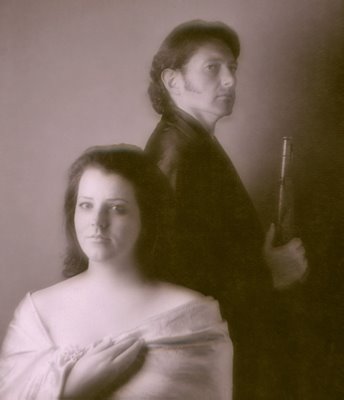
For some services rendered I had two extremely good tickets to the Vancouver Opera's opening day performance, last Tuesday, of Pyotr Iliych Tchaikovsky's opera Eugene Onegin. But I took a chance and asked the powers that be for lesser (but three) tickets for yesterday Saturday with the idea of also taking Rebecca. I asked Rebecca. She said yes. But later it came down that she had been afraid to say no and that she really did not, nor does she like opera. My only comment on this is that you need yeast back at the bakery to make dough rise and without yeast, bread will always be flat.
The empty seat besides me was like a black hole. I could feel a pull. Rosemary and I from the vantage point of our lesser ticket seats enjoyed an opera that surprised me at many levels. The sets (Neil Patel) were sparse and beautiful especially the one in Act III where a bored Eugene Onegin (baritone Brett Polegato) comes back from a trip around the world where all he has found is more boredom. Servants remove his travel clothing and dress him up for a ball as the scenery around him transforms itself into a neo-Greco-Roman ballroom with huge columns bathed in a metalic blue cast. The dancers appear and then Tatyana (soprano Rhoslyn Jones) makes her triumphant entrance lit by a brilliant warm spotlight and in the arms of the tall soldier husband, Prince Gremin (bass Peter Volpe). I have not been so moved by colour and lighting (Rui Rita) in a very long time and particularly in theatre or opera.
The music was also a surprise, while being romantic, it was somehow also sparse, elegant and less over the top as in some of the Italian operas. The overture was quiet and short. The endings after each act (3) or scenes (7) were probably also quiet and lovely but last night's audience was quick to clap before the music ended so I was left with a frustrating curiosity. The music was a revelation which somehow matched the look of the sets and the crisp sound of chorus director Leslie Dala's chorus. Could it be an accident that if Tchaikovsky has given us so many good ballets that the dancing in this production (Allison Grant, choreographer) was both interesting and fun?
As always Rosemary and I enjoyed the Preacher of the Opera's sermon (even the folks at the unculturally recalcitrant Vancouver Sun know a good thing when they see one as they now sponsor the pre-opera talks) before the night's opera. Doug Tuck (The Preacher) enlightened us on how the composer was inspired by Russian composer Mikhail Glinka's opera Ivan Susanin and Pushkin's own Eugene Onegin . At the end of his talk he informed us of the Vancouver Opera's next production, which is Bizet's Carmen which opens January 24, 2009. I wondered if Tuck was up to something and if he was somehow winking at us. When we arrived home I looked into my The History of Opera by Richard Sommerset-Ward and hit paydirt!
But it was in Paris (1876) en route to Bayreuth that he had what he himself described as his most important experience. He attended a performance of Bizet's Carmen. It had been staged for the first time the previous year and had had a cool reception from the Parisian audience. What fascinated Tchaikovsky was not just the copious melody and the realistic story line: Carmen also had an underlying theme that corresponded to something deeply embedded in his own consciousness and, that was increasingly to dominate the remaining years of his life - the theme of fate.
In the "Card Trio"at the beginning of Act III, Carmen turns over the cards to see how they lie. "Spades - a grave!" she exclaims. "What matters it? If you are to die, try the cards a hundred times, they will fall the same - spades, a grave."
In Onegin's duel scene in Act II Scene 2, Oengin's former friend Vladimir Lensky (tenor Oleg Balashov) sings beautifully of his fate and his possible grave in very much the same words. While one of Tchaikovsky's lesser known operas, The Queen of Spades was based on a Puskin own story by the same name he cannot have written it without thinking back to Carmen's prophecy.
Quartet For The End Of Time
Saturday, November 29, 2008
I give bird songs to those who dwell in cities and have never heard them, make rhythms for those who know only military marches or jazz, and paint colors for those who see none.
No one should be allowed to make music as if he were made of wood. One must reproduce the musical text exactly, but not play like a stone.
Music is a language that can reach the secret parts of existence. It is an abstract language which addresses the subconscious more than the conscious.
Olivier Messiaen.
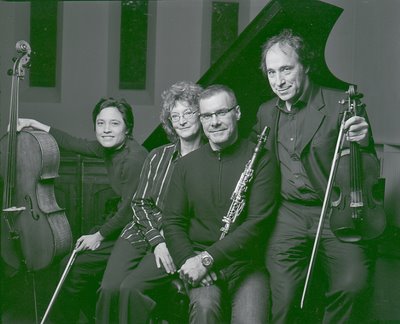
Yesterday afternoon I listened to the rehearsal of a work by French composer Olivier Messiaen whose title is the most beautiful sounding Quartet for the End of Time. It is part of a program by the Turning Point Ensemble in a concert that was held yesterday (Friday) and again tomorrow (Sunday) at 8pm at Ryerson United Church, 2195 W. 45 Avenue. Messiaen’s quartet will be played by cellist Peggy Lee, pianist Jane Hayes, clarinetist François Houle and violinist Marc Destrubé (same order in photograph here).
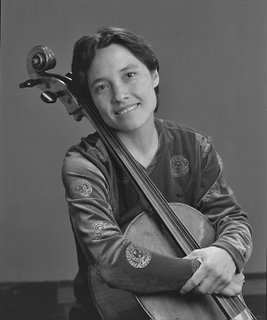
I plan to attend the concert for several reasons.
In 1964 I was a 22-year-old young man who thought he had avant-garde tastes. This meant I went to little Mexican baroque churches to listen to music that had been “discovered” at the time. This was baroque music by such composers as Frescobaldi, Torelli, Vivaldi and Corelli. I looked down on my mother’s fondness for "the musical genius of all time" (as she called
Bach) because his name did not end in i! My idiocy accompanied me to a concert at the University of Mexico where my friend Robert Hijar told me we would have the pleasure of listening to works by composer Olivier Messiaen. I listened to a soprano squawk accompanied by music I could hardly hum and I told Robert I hated it. And that was the last time I exposed myself (knowingly) to Messiaen until last night. After the rehearsal sample I am curious and hooked, too.

A little treasure in my library is A Guide to Orchestral Music - The Handbook for Non-Musicians by Ethan Mordden (Oxford University Press 1980). Before going over to Ryerson to snap the picture of the quartet yesterday I read:
Birds are a major inspiration to Messiaen; his attempts to recreate and even analyze their music in his compositions form his most identifying feature. “For me,” says Messiaen, “birds are the greatest of artists.” He has traveled the world noting their cries, he taking down their dictation on music paper, his wife (the pianist Yvonne Loriod) capturing the sound on tape.

When I listened to the third movement (8 in all) Abyss of the birds (I had no program) François Houle’s clarinet was a bird, several birds. It was beautiful. Of this movement Messiaen himself writes:
Clarinet alone. The abyss is Time with its sadness, its weariness. The birds are the opposite to Time; they are our desire for light, for stars for rainbows, and for jubilant songs.

Of the work, Quartet for the End Of Time, Turning Point Ensemble Conductor (and composer) Owen Underhill (seen here with dancer/choreographer Lauri Stallings) writes:
In 1940, Olivier Messiaen was interned in a German prison camp, where he discovered among his fellow prisoners a clarinetist, a violinist and a cellist. The success of a short trio which he wrote for them led him to add seven more movements to this Interlude, and a piano to the ensemble, to create the Quartet for the End of Time. Messiaen and his friends first performed it for their 5000 fellow prisoners on January 15, 1941.
According to the composer, the Quartet was intended not to be a commentary on the Apocalypse, nor to refer to his own captivity, but to be a kind of musical extension of the Biblical account, and of the concept of the end of Time as the end of past and future and the beginning of eternity. New Yorker critic Alex Ross has described this iconic work as "the most ethereally beautiful music of the twentieth century."
Of the rest of the program Underhill notes:
Paired with the Messiaen are three dynamic and colourful large ensemble pieces by one of Canada's most skillful and internationally respected composers, Vancouver born, Alexina Louie. “Louie’s music is a wondering pairing to the music of Messiaen, and the performance of these three significant large scale works is a substantial and overdue representation of the work for Vancouver audiences,” The works include the BC premiere of Imaginary Opera, Louie's Winter Music, a chamber concerto for viola and eleven performers commissioned by the Vancouver New Music Society and nominated for a Juno award for Best Classical Composition in 1998, featuring solo violist David Harding and her work, Ricochet featuring Turning Point Ensemble Co-Artistic Director and trombonist Jeremy Berkman.
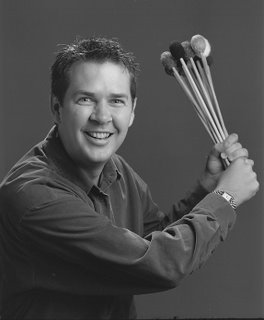
If all the above is not enough to lure you to Sunday's concert let me add two more features that make me curious. While I was listening to the rehearsal I spotted percussionist Vern Griffiths (left) getting his instruments ready. I would describe what I saw to be a wall of sound instruments almost as wide as the church. I wanted to ask him what kind of vehicle or vehicles he needed to transport all the gongs, drums, bells, xylophones, etc that I saw.
And when was the last time you heard a piece for solo trombone?
Addendum
The ever versatile cellist Peggy Lee has a short but glowing report on her new CD in the Sunday, November 30, NY Times:
The Canadian cellist, not the American singer, Peggy Lee has an eight-piece band that sounds like jazz, and then rock, and then a kind of chamber-music pastoralia, always flowing organically from one thing to the next. It’s made by collective improvisation, with lots of friction and jostle among the guitars and saxophones and brass and drums, but the Peggy Lee Band’s latest album, “New Code” (Drip Audio), isn’t aggressive; it’s full of pop melodies (including Bob Dylan’s “All I Really Want to Do,” Kurt Weill’s “Lost in the Stars” and plenty of Ms. Lee’s own), pretty drones and subtle shifts of arrangement brought on by Ms. Lee’s cues.
Friday, November 28, 2008
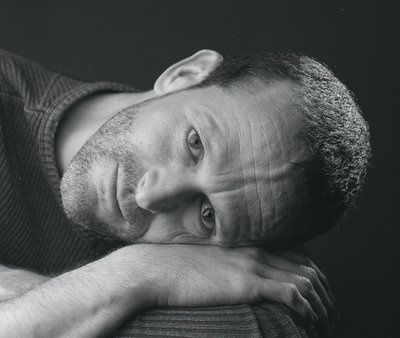
Sometime in the mid 80s during an economic recession, Vancouver Magazine editor, Malcolm Parry decided to run a "service piece" (a thinly disguised editorial that wasn't) called Good Things In Bad Times. I was dispatched to photograph $15.00 (the price then) Cuban Montecristo cigars, an economically-priced but very good Spanish Rioja wine and a few other things.
Watching the Playhouse Theatre Company's first play of their season, Lisa Lambert, Greg Morrison, Bob Martin and Don McKellar's The Drowsy Chaperone , directed by Max Reimer, and seeing my usually somber wife smile, I understood Malcolm Parry's idea about good things in bad times. In fact The Drowsy Chaperone is a very good thing for very bad times.
A few months back my wife and I enjoyed the Arts Club Theatre musical The Producers which coincidentally (with a purpose, perhaps?) also had Jay Brazeau in the cast. My friend author and Georgia Straight movie critic John Lekich pointed out that producing such a musical with a large cast and very good dancers and singers was no easy task in these times. He told me, "Whe should lap up such stuff when it happens as it doesn't very often."
Before I throw unabashed praise on The Drowsy Chaperone let me point out my pet peeves. As a Latin American born in Buenos Aires I have understood theatre, film and opera but I have never comprehended the concept of musicals where people, out of the blue, suddenly begin to sing or to dance. A cultured Mexican friend of mine is unable to handle exotic dishes that feature sweet and sour or sweet and salty. He likes to have his stuff separate. Perhaps my 35 residence in Vancouver has softened my stance on musicals so that I can enjoy them. My other pet peeve is more difficult to reconcile. I absolutely hate tap dancing and there is lots of tap dancing in the The Drowsy Chaperone.
With that all cleared up I must assert that when tap dancers Laird Mackintosh (Robert, the groom) and Ryan Reid (George, the best man) did their stuff it was done well. But it was tap dancing. Then David Marr (Underling, the butler/servant) appeared on the scene. This usually extremely serious Vancouver actor ( His Greatness) did his little tap sequence between the other two. I laughed. Tap dancing must have its moments!
While I am 66 I am still an admirer of not only talent (she's got it) but of beauty and especially legs. Debbie Timuss (Janet) has legs that somehow are even more luscious by whatever stockings costume designer Phillip Clarkson made her wear. Timuss's dresses (Clarkson again!) are all designed to show off those legs and a white teddy later in the show made me feel 20 again.
Legs don't stop with Timuss. They keep on going with Nathalie Marrable (Kitty). She is forced to speak and sing with a ditzy voice so I spent more time looking at her legs. My distraction with legs was compounded when the gangsters (disguised as pastry chefs) Neil Minor and Shawn Macdonald, in photo above left, appeared. My, what legs!
I spotted Dal Richards in the audience who must have felt the same way as I did in enjoying the big band sound of the small group of musicians (Nick Apivor, Derry Byrne, Thomas Colclough, Rod Murray and Lloyd Nicholso, the musical director). How often do you get to hear a trombone?
As I watched the versatile and extremely funny Jay Brazeau play Man In Chair (sort of like a physical narrator who steps in, here and there, to tell you what is going on in his mind as the shenanigans on stage are what he sees with his imagination as he plays the records of this fictitious show set in the roaring 20s) I kept thinking of an older and chubbier Mike Harcourt with a tad more hair. Apparently this was no accidental connection on my part. My friend Abraham Rogatnick (who played the rabbi with Brazeau in the Playhouse's production of Fiddler on the Roof ) told me today that Brazeau often imitated Harcourt when Harcourt was our mayor. As I watched Brazeau's jovial performance I suddenly remembered that he had played a mortician in Lynne Stopkewich's 1996 film, Kissed. Now that's range.
If this wonderful play had been a dud I would still have liked it simply because it champions the use of one of he most beautiful and evocative words of the English language that has all but disappeared in our politically correct times. And that is aviatrix. The Drowsy Chaperone features an almost full scale WWI biplane (Take that, Miss Saigon!) and Trix (a black and very independent aviatrix played by Tshol Khalema).The play ends in a scene right out of one of my favourite films, the 1933 Flying Down To Rio with Fred Astaire, Ginger Rogers and Dolores del Río.
And if that is not enough there is Gabrielle Jones playing an always tipsy (is it iced water, is it vodka?) drowsy chaperone. Her "spraying" scene with the very funny (how was I to know of this hidden talent of his?) David Marr rivals the blind roller skating scene but I won't go into that one. Nor will I venture to reveal the identity of the most talented building manager in the business who has a key role in this production.
The Drowsy Chaperone runs until December 27.
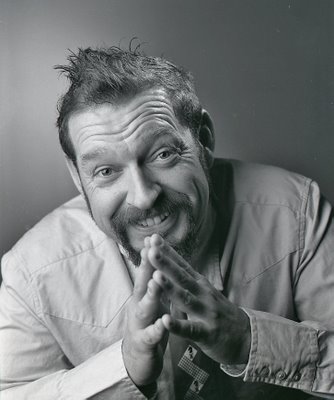
Last night I attended the Arts Club Theatre production of It's A Wonderful Life directed gleefully by Dean Paul Gibson, left. I wrote about this last year here. Seeing it for a second time did not diminish my enjoyment as I saw it not with my wife Rosemary but with my daughter Hilary (Rebecca and Lauren's mother). Hilary sees very little theatre because I take Rebecca to as many theatre performanes as I can. Hilary's first comment at the intermission was, "This is not at all like the high school productions I used to attend as a teenager! This is professional." But what really made the play such a pleasure for Hilary has to be what I think is really a Vancouver tradition in the performing arts. Let me explain.
Many years ago when Hilary's older sister Ale was around 12 I took her to an Andrés Segovia guitar recital at the Orpheum. At the time Ale was taking guitar lessons at the Vancouver School of Music. A very taciturn Segovia walked into the stage and sat down without any explanation. He silently left after his virtuoso performance. I told Ale, "Go to that side door and wait. Knock and somebody will let you in. Perhaps Segovia will autograph your program." Ale did just that and I saw her disappear behind the side door. When she came back, with a big smile on her face, she told me, "Andrés (he asked me to call him that), picked me up and gave me a hug. Since I spoke in Spanish to him he told me in his Castilian, Alejandra, I did not say anything during the performance because I lost my voice in the airplane from Spain." Ale has not forgotten Segovia's warm welcome and warm (if diminished) voice.
Since then I have managed to go back stage (without much problem) at theatre performances, the ballet, modern dance, the Vancouver Symphony, the Vancouver Opera, musical performances at the UBC School of Music, the Chan, the Vancouver East Cultural Centre. One of the many highlights has been able to go back stage at Ballet BC rehearsals and watch the action from there. During rehearsals of the Vancouver Philharmonic Orchestra its former director Juan Castelao used to allow Rebecca and I to sit a meer three or four ft behind him. And of course after performances of the Pacific Baroque Orchestra or of famous luminaries of the baroque world in Early Music Vancouver concerts I have mingled and shared thoughts with, the likes of Monica Huggett and Andrew Manze both violinists that can only be compared with our very own Marc Destrubé.
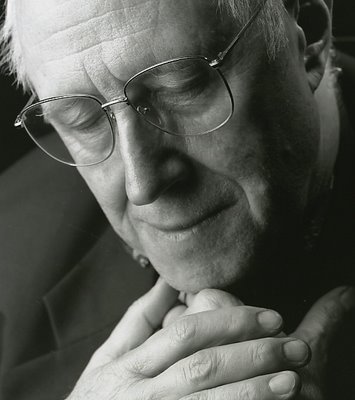
But the best of all was my being multiply kissed in the cheek by cellist and conductor Mstislav Rostropovich backstage at the Orpheum after a VSO performance.
It is this Vancouver tradition of opening rapport between performers and the audience and making it so accessible that amazed my daughter Hilary last night at the Arts Club Granville Island Stage. We talked to the actors and had a warm chat with director Dean Paul Gibson (above, left) . Hilary wanted to congratulate actor Bernard Cuffling who played the not quite winged Clarence the angel. I took my opportunity to tell him that I missed his motorcycle. He winked at me as he understood my reference to his wonderful performance in the recent Arts Club Theatre production of The History Boys.
You learn quickly and for the better that Ballet BC dancers, modern dancers, musicians, conductors, directors are not gods. You learn that they put their pants on one leg at a time and that they sometimes have to eat Kraft Dinners like we sometimes do. But you also learn and admire their passion, skill and determination to avoid and transcend the mediocrity that is taking over our lives. You learn that while there is not much interdisciplinary cooperation in Vancouver amongst the performance organizations there is a sense that every once in a while one has to circle the wagons and save the troops. Bill Millerd in his usual little warm talk before last night's It's A Wonderful Life said, "Let's all go out there and buy tickets to the Nutcracker. Let's save Ballet BC." Yes!
It's a Wonderful Life runs until January 2, 2009
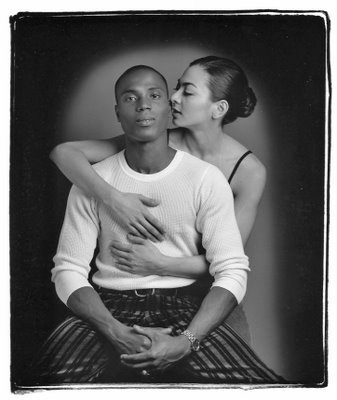
Subject: Tragic - Ballet BC terminated
Dear Friends,
We have our work cut out for us. The cancellation of the CBC Radio Orchestra, huge cuts within the CBC with more potential layoffs announced today and now this. In my opinion, Ballet BC is the best arts organization in Vancouver and we need to save it. It's cutting edge artistic and run by the brilliant, creative and innovative mind of John Alleyne. We are so lucky to have them in our city and to have them represent Canada abroad. Please encourage people to go to the Nutcracker - if there are enough seat sales, we can save this jewel and hopefully save an important part of culture in our city.
Thank you all,
Tiko Kerr
I received the above this morning. My friend Richard Dal Monte and editor at Tri-Ciy-News had sent me the Vancouver Sun article yesterday morning so I was already in a bit of a shock. I thought about it all night and slept badly. The above letter from artist Tiko Kerr made me think on my relationship with Ballet BC which began sometime around 1995 when I started shooting dance pictures for the Georgia Straight. Here (above) is one of my earliest ones with Ballet BC Director John Alleyne and dancer Gail Skrela.
It all began with an infatuation (love perhaps?) of watching Evelyn Hart dance, meet her and take her photographs. Evelyn Hart was my introduction into the wonders of ballet. From there I had to see more ballet so Ballet BC became my ticket. I became such a fan that I would notice when dancers would lose or gain weight or when they got new hair cuts. I could not understand why more people did not try to secure access to back stage or rehearsals. I felt many years younger because I became a groupie. I watched my swans prepare back stage. Many wore fluffy rabbit bedroom slippers to keep their feet warm!
But there was another awakening in myself that was all due to my experiences with Ballet BC. Going to some of the premiere performances I would note groups of men usually dressed in black (with some wearing leather pants). They were evidently gay and were there to enjoy the beautiful male dancers. I felt a bit on the dirty side as I was there to admire the beautiful female dancers. It was at about this time that I wrote a piece for the Vancouver Sun and for the CBC Arts Web Page about the sexual aspect of ballet and dance. I felt that as a man I should be able to proudly assert that I especially liked ballet and dance because the women were beautiful and graceful. Why was it that only the men who liked the boys could get away with it?

I soon found out what those men were enjoying because I too began to feel within me the excitement of seeing men dance and I was affected by their sexuality much in the same way as I was when I watched the women dance. Soon I was a fan of the men, too and I noticed when they had new haircuts. It was as if my pleasure at being a fan of Ballet BC was twofold. It was!
I began to realize that manliness and passion had nothing to do with sexual persuasion. My most favourite male dancer ever, (seen below painting on Tiko Kerr's head), was passion on the floor. I enjoyed every performance of his as if it were his last and to this day I regret that he never played Dracula! The three young men are from left to right, Chengxin Wei, Justin Peck and James Russell Toth.

Thanks to Ballet BC and dance in Vancouver I persuaded my daughter Hilary to put Rebecca into dance at Arts Umbrella. Her first teacher was Ballet BC's Andrea Hodge.It was at Arts Umbrella that I noticed the young boys and men of the company and how I could watch them without any personal embarrasment. I was watching dancers dance well. Their sex was irrelevant. It was thrilling. I even managed to write about it for a local magazine VLM. The interviews helped me understand the intelligence and approach of the taciturn Ballet BC dancer Edmond Kilpatrick, seen below, left with Acacia Schachte and Sandrine Cassini.

I will not argue that culture is important and that we must put more effort in attending (and buying tickets) dance, theatre, opera and musical performances. Not having a ballet company in Vancouver is a tragedy and Tiko Kerr points out that they represent Canada very well abroad.
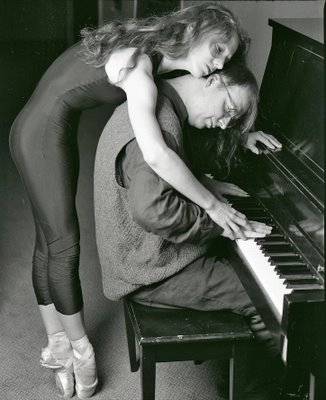
I would only add that in many respects even with the death (I hope a most temporary one) Ballet BC represents us well even now. Lauri Stallings, seen here inspiring composer Owen Underhill at the piano, recently choreographed (one of the dancers she directed was Paloma Herrera) for the American Ballet Theater in New York City. And our very own Arts Umbrella alumnus and Ballet BC dancer Acacia Schachte dances for the prestigious US Cedar Lake contemporary ballet company. One of the choreographers is Crystal Pite also a former dancer from Ballet BC who went on to dance for the Frankfurt Ballet and is now in Vancouver directing her own company Kidd Pivot. And Ballet BC talent doesn't stop there. Some years ago Ballet BC Director and choreographer (seen here with dancer Gail Skrela) lured Frankfurt Ballet dancer Emily Molnar to Vancouver who was one major reason for steady shift from the company's classical ballet into the exciting new direction of modern ballet and modern dance. Emily Molnar now has her own dance company and she is busy traveling the world as a highly rated choreographer. There is Ballet BC blood there seeping into the dance culture of the world.
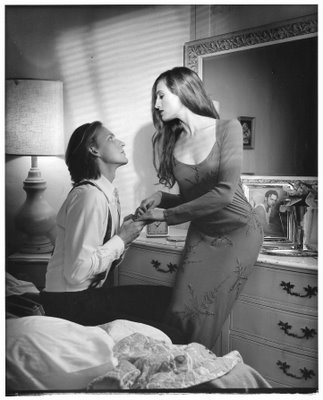
And we must not forget that through the years Ballet BC has attempted, when possible and when budgets permitted, to use original and live music to accompany its dancers. One of the more elaborate performances was Carmina Burana and Carmen where full-sized orchestras were used. This meant jobs for free lance musicians and composers as in the recent Fairy Queen. In recent times many of the new ballets (like the Fairy Queen) were choreographed by John Alleyne. I wondered why we had not recently seen anything (as an example) by choreographer William Forsythe. After all when Alleyne started at Ballet BC we were exposed to many of Forsythe's ballets. The answer (from that graceful horse's mouth, Alleyne himself) was a teling one. I asked him a couple of months ago. He said,"In order for us to mount a Forsythe ballet we have to pay a royalty upwards of 75 thousand dollars plus we have to pay air fair and accomodation for one of Forsythe's'representatives to monitor our production.
There is one more debt of gratitude that I have for Ballet BC. The company in the many photo assignments that I had with them inspired me to shoot some of the best photographs of my career. This inspiration has not stopped as dance is now a very big chunk of my life. John Alleyne, Ballet BC, Miroslav Zydowicz, Andrea Hodge, Simone Orlando, Acacia Schachte, Edmond Kilpatrick, Lauri Stallings (seen in last picture here with Miroslav Zydowicz), Crystal Pite, Emily Molnar and so many others thank you and come back soon.

Some 29 years ago I went Claudia Beck and Andrew Gruft's Nova Gallery on 4th Avenue and saw a print (printed by the photographer) of Moonrise Over Hernandez, New Mexico by Ansel Adams. It was superb hanging in the middle of the room suspended by wires from the ceiling. For many of us this was the Holy Grail of the landscape photograph. It was the perfect landscape. We knew that Adams had been able to take but one exposure from a camera on a tripod on the roof of his pickup. We also knew that the one exposure was close to perfect because Adams knew the luminance value of the full moon. For many who dabbled in landscape they would often say that Adams's pictures were good only because he had the money and patience to wait for the best light.
What is the best light? As an example consider the problem of a landscape that has three separate areas.
1. A dramatic sky with puffy or storm clouds.
2. A middle region that is often a mountain chain with snow capped peaks.
3. A third region which us usually a valley (streams or lakes) in the shadow of the mountain range.
No b+w film or slide film can accommodate the three values. If you expose for the dramatic sky the snow on the peaks will go gray and the valley will be black. If you over-expose to get detail in the valley the snow will lose its detail and the sky will be disappointing. Adams waited for the best light and had his own personal trick that he called his Zone System. It worked with separate sheets of b+w film in larger formats but it failed with transparency or slide film.
For many years pristine and perfect landscapes were rare. We photographers would be wowed when we saw them. There was a large postcard demand for these pristine landscapes.
Then about 40 years ago a French company called Cokin revolutionized landscape photography with the mass distribution of its partial neutral density filters which were made of plastic. They were relatively expensive and you really had to take care of them as they scratched easily. Here you see such an example. This filter was large enough for most of my 35mm wide angle lenses. If you positioned the dark area on the top of the lens, the darkness would prevent light from entering your camera and exposing your film. As you took an exposure that was correct for that dark valley the neutral density (meaning it did not add or subtract colour) the resulting overexposure on the dark dramatic cloud was compensated by the top half of the Cokin filter. These filters came in all sort of gradations with narrower or darker bands of darkness. Then Coking came up with coloured neutral density filters. Instead of dark areas these areas would be in colour. The most popular was a reddish one that was called the tobacco filter. These filters started creeping into movies particularly the ones that were about the rosier time of yesteryear or in old cheddar TV ads (this is the way we used to make our cheese and this is still the same way we make it now).
One of the first things I did after marrying Rosemary in 1968 (but there is no connection) was getting a membership (this was before the magazine went public and you could buy it in newsstands or get a subscription) to the National Geographic. Thanks to the inept and corrupt Mexican postal system I never got more than 8 issues per year. I vowed to someday move to a country were I would get all 12 issues per year. This finally happened in 1975 when we moved to Vancouver. At the time I was dazzled by the photography of the magazine. But it was also at this time that Cokin was making itself known and I was disappointed and dismayed to see photograph in the Geographic (Robert Louis Stevenson's tomb on top Mount Vaea on Upolu, Samoa) at about that time that had used the tobacco filter. The photographer had not waited for the light. The photographer had cheated.
I am happy to report that the Geographic from my vantage point has become again a magazine that is most important in my life. The photographs of animals in the current issue (December) in an article on Alfred Russel Wallace are terrific and the article so interesting I am going to look for a biography on this man that the Geographic calls The Other Darwin. The magazine is a delight to read as it no longer seems to tow the US political line and when it reports on a country that is a dictatorship is says so. At one time the Geographic photographers would keep the horizon near the bottom of the picture. You never saw the squalor, the poverty or the dirt. That is long gone as the horizon has increasingly moved upwards.
Cokin is still in business but the digital camera industry will soon probably do it in. Photographers are now able to shoot that landscape (the sky, the mountain range, the valley) in three separate exposures and there are many cheap programs that will meld all three exposures seamlessly. If you pick up any photo magazine your eyes will soon grow tired or even blind to the page after page of perfect landscapes in intense colours. The reflections of the mountains on the lake are as perfect as the mountains themselves.
Looking back at the picture of Stevenson's tomb on Samoa I now don't see it so much as a travesty. It was only a modification of existing conditions that film could not handle. The eye can look at those three separate aspects of the landscape. It is the camera with film that fails. Now landscapes can all be perfect. As perfect as all those photographs of perfect models that even lack pores in their faces.
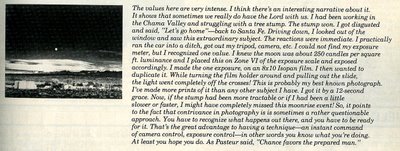
Can it be that we will no longer be thrilled by a picture taken from the roof of pickup as a one shot?
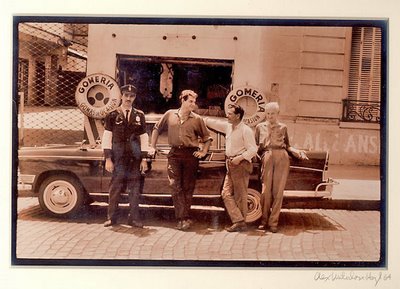
Memory and its selectiveness has fascinated me for a long time. I cannot fathom how it is that I spent close to six months seeing my father every Sunday afternoon in Buenos Aires in 1965 before he died and yet I cannot remember any of our conversations. Perhaps the only proof that it all happened is a photo that I took of him with my Pentacon F camera. I do remember that I snapped it on a Buenos Aires street named Carabobo which I have always thought to be a funny name even though it was the name of the decisive battle that Simón Bolivar won against the Spanish in 1821 and gave Venezuela its independence. And I have a fond memory of the oddly named Siam Di Tella car that my father (far right, in picture, left) is leaning on.
Some 28 years ago I used to frequent Vancouver's Commodore Ballroom with Vancouver Magazine rock journalist Les Wiseman. There was a young man that Wiseman kept introducing me to who was always at the concerts. I would invariably forget the young man's name. One day I ran into him on the street and told him I would never forget his name again because I used the trick of associating his name with Scottish patriot Robert the Bruce. Unfortunately this never did work. When I would see him at the Commodore I would think, "Is his name Robert or Bruce?"
Bud I do pride myself for my good memory for historical facts, for botanical names, the names of books and their corresponding authors and my memory for rose smells is acute as I can discern variations within the myrrh scent varieties of English Roses. I don't say I am good with botanical Latin because a friend, Donald Hodgson a Latin teacher told me that botanical Latin has more of the Greek than of the latter. I have noticed that my botanical nomenclature in both Greek and Latin is good from Spring until late fall and then as the garden collapses and disappears my nomenclature fades, too. As soon as those plants begin to emerge in the spring their names are instantly retrieved from my memory banks!
Memory is much in my thoughts as I am reading Umberto Eco's The Mysterious Flame of Queen Loana . It is about a man who wakes up with selective memory. On Wednesday I was browsing at Chapters on Granville and Robson. One novel (a period novel) caught my eye because the author's name was in what looked like classic Latin. I looked at the author photo and found out she lived in Alaska. I was intrigued. I put the book back when my eye caught a large print edition of a Donna Leon, Commissario Guido Brunetti mystery and I instantly bought it as I have a few relatives with poor eyes. I forgot about the Alaskan author with the Latin name.
On Saturday night Rebecca and I went to see Twilight. When the credits were running in the end I was struck by a name. The unit manager of the film was Michelle Imperato Stabile. I dropped Rebecca off and as soon as I got home I punched the name into my computer but I found no mention of this woman being an author. Was my memory playing tricks? I tried different combinations of the name but found no novelist with a Latin name.
Today on my way to Van Arts I stopped at Chapters. I remembered exactly where the book had been and it was gone. I returned later and asked Nancy (she has a prodigious memory for the names of her book in the store) and we drew a blank. I told her that my only remaining solution was to stop at the other Chapters on Broadway and Granville and look there. Either I was crazy or the bookstore computer bank was in error.
In the other store I did not find Michelle Imperato Stabile. As I was about to leave I noticed a novel called The Spanish Bow. The author's name was Andromeda Romano-Lax. I looked for the author photo. Yes! She lives in Alaska. And yes, this time around I purchased the book.

The picture you see here of the author is taken by her husband Brian Lax. And of course my friend Donald Hodgson would have immediately pointed out that Andromeda was a Greek mythology name and that she was the daughter of Cepheus and Cassiopeia and wife of Perseus, who had rescued her from a sea monster.
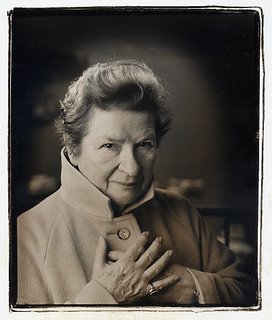
Today I read every article in my Sunday NY Times Magazine twice. In particular I was struck by Becoming Screen Literate by Wired writer Kevin Kelly. The second and third paragraphs of his essay hit home and you wonder what Marsahall McLuhan would write about a world he might have had a inkling of but could never have predicted the present we live in now.
When technology shifts, it bends the culture. Once, long ago, culture revolved around the spoken word. The oral skills of memorization, recitation and rhetoric instilled in societies a reverence for the past, the ambiguous, the ornate and the subjective. Then, about 500 years ago, orality was overthrown by technology. Gutenberg’s invention of metallic movable type elevated writing into a central position in the culture. By the means of cheap and perfect copies, text became the engine of change and the foundation of stability. From printing came journalism, science and the mathematics of libraries and law. The distribution-and-display device that we call printing instilled in society a reverence for precision (of black ink on white paper), an appreciation for linear logic (in a sentence), a passion for objectivity (of printed fact) and an allegiance to authority (via authors), whose truth was as fixed and final as a book. In the West, we became people of the book.
Now invention is again overthrowing the dominant media. A new distribution-and-display technology is nudging the book aside and catapulting images, and especially moving images, to the center of the culture. We are becoming people of the screen. The fluid and fleeting symbols on a screen pull us away from the classical notions of monumental authors and authority. On the screen, the subjective again trumps the objective. The past is a rush of data streams cut and rearranged into a new mashup, while truth is something you assemble yourself on your own screen as you jump from link to link. We are now in the middle of a second Gutenberg shift — from book fluency to screen fluency, from literacy to visuality.
In my own way I have written here how our computer monitor and flat screen TV viewing has changed our perception of three dimensionality as we go towards a future when exploring a museum will be all with our Dell 2408 monitor as we pay Getty Images for a two minute viewing of La Gioconda.
I am so used to injecting hyperlinks in this blog that I feel frustrated when I read a novel or non fiction book and I notice a word I don't know or the mention of a historical character I want to know more about that instant. The Kindle will take off only when it comes with a built in hyperlink.
The air beyond the window touches each source of light with a faint hepatic corona, a tint of jaundice edging imperceptibly into brownish translucence. Fine dry flakes of fecal snow, billowing in from the sewage flats, have lodged in the lens of night.
The above is the third paragraph from William Gibson's 1993 novel Virtual Light . It is the scene looking out from a Mexico City hotel room and the paragraph describes to perfection what that Mexico City sky looks like and where I have seen puffy white clouds float by with dense pollution above them. Gibson confessed to me that when he wrote that paragraph he did it without ever having traveled to Mexico City. On a Kindle of a most immediate future readers would be able to find the definition of hepatic, corona and even fecal should they be curious.
The liniarity that Gutenberg brought with his press is just about dead. Consider the first paragraph of NY Times film critic A.O. Scott's essay The Screening in America in today's NY Times Magazine:
A short time ago, in honor of the impending holiday season and the looming depression, I settled in for a viewing of “It’s a Wonderful Life.” I watched it on the same laptop on which I’m writing these words, with headphones plugged in to filter out distraction, though from time to time I did shrink the image so I could check my e-mail or my favorite blog.
The above sentences may be linear but A.O. Scott's actions are not. I have been often reminded by a friend that a computer's ability to multi-task is not a prerogative of the computer but an ability that is most human that has been programmed into the computer by humans. My friend reminds me that we don't scan rooms like computers but that computers scan like humans. While I may be shocked (and so would my friend John Lekich) on the travesty of admiring Donna Reed's eyes on a laptop or heaven forbid in cell phone's tiny screen, I just might accept that our ability to do this is probably hard-wired and that Gutenberg's unfluence on our liniarity may have been a passing phase.
Consider the ad for P.D. James's latest The Private Patient in today's NY Times Book Review. It says, "Curl up with her new and immensly satisfying 14th Adam Dalgliesh mystery."
Who coined this term that is so often repeated that is as much of a cliché as the use of flawed by film critics? Can one curl up with a laptop? The term for me is alien as I prop myself up with three or four pillows and read in bed. Are the folks advertising the James book convinced that all who read her are of a certain age. And that would eschew the laptop, the Kindle and would curl up in the family sofa in the living room? How many would be able to read in a living room having as potential competition that huge flat screen TV over the gas fireplace?
In Umberto Eco's 2004 novel The Mysterious Flame of Queen Loana ( a remarkable $10 bargain at Chapters for which I received a further 10% off with my irewards card) a man wakes up in a hospital:
"And what's your name?"
"Wait, it's on the tip of my tongue."
That's how it all began.
The man, Yambo, a Milanese rare-book dealer does not remember his name, recognize his wife but can remember the plot of every book he has ever read and quote most accurately, He speaks in incredible almost disjointed streams of consciousness that seem to me to be stuff of the present. His utterings might disjoint Gutenberg's successors and crusty book reviewers. I was simply dazzled. Could Yambo's speech patterns be what ours will be as soon as hyperlinks operate in our brain?
I stroked the children and could smell their odor, without being able to define it except to say it was tender. All that came to mind was there are perfumes as fresh as a child's flesh . And indeed my head was not empty, it was a maelsrtom of memories that were not mine: the marchioness went out at five o'clock in the middle of the journey of our life, Abraham begat Isaac and Isaac begat Jacob and Jacob begat the man of La Mancha, and that was when I saw the pendulum betwixt a smile and tear, on the branch of Lake Como where late the sweet birds sang, the snows of yesteryear softly falling onth the dark mutinous Shannon waves, messieurs les Anglais je me suis couché de bonne heure though words cannot heal the women come and go, here we shall make Italy, or a kiss is a just a kiss, tu quoque alea, a man without qualities fights and runs away, brothers to Italy ask not what you can do for your country, the plow that makes the furrow will live to fight another day, I mean a Nose by any other name, Italy is made now the rest is commentary, mi espíritu se purifica en Paris con aguacero don't ask us for the word crazed with light, we'll have our battle in the shade and suddenly it's evening, around my heart three ladies' arms I sing, oh Valentino Valentino where art though , happy families are all alike said the bridegroom to the bride, Guido I wish that mother died today, I recognized the trembling of man's first disobedience, de la musique où marchent de colombes, go little book to where the lemons blossom, once upon a time there lived Achilles son of Peleus, and the earth was without form and too much with us, Licht mehr licht über alles , Contessa what or what is life? and Jill came tumbling after, Names, names, name": Angelo Dallóca Bianca, Lord Brummell, Pindar, Flaubert, Disraeli, Remigio Zena, Jurassic, Fattori, Straparola and the pleasant nights, de Pompadour, Smitth and Wesson, Rosa Luxemburg, Zeno Cosini, Palma the Elder, Archaeopteryx, Ciceruacchio , Matthew Mark Luke John, Pinocchio, Justine, Mari Goretti, Thaïs the whore with the shitty fingernails, Osteoporosis, Saint Honoré, Bactria Ecbatana Persopolis Susa Arbela, Alexander and the Gordian knot.
The encyclopedia was tumbling down on me, its pages loose, and I felt like waving my hands the way one does amid a swarm of bees. Meanwhile the children were calling me Grandpa, I knew I was supposed to love them more than myself, and yet I could not tell which was Giangio, which was Alessandro, which was Luca. I knew all about Alexander the Great, but nothing about Alessandro the tiny, the mine.
For a child, parents’ warning is like a rose blooming in the brain; it opens with difficulty and fades quickly.
Galileo Galilei, Berchtolt Brecht
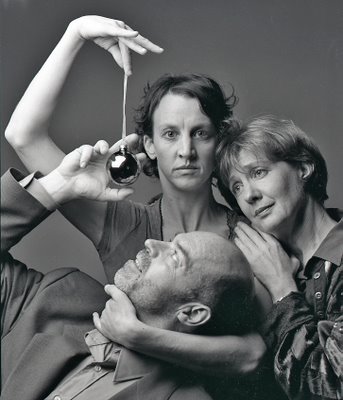
Last night John Lekich and I went to see the Main Street Production of David Mamet's play Glengarry Glen Ross at the Little Mountain Studio on East 26 Avenue at Main Street. The experience was so intense that when we had a coffee at the nearby coffee shop, The Grind I was just about commanded by Lekich,"You must blog this." My retort, "I only have a picture of actor Bill Dow that I took some years ago in a trio with Lois Anderson (centre) and Sheelah Megill (right). Lekich looked at me and said, "So what?"
The intensity of this production, besides a stellar cast including my fave Bill Dow playing Shelley "The Machine" Levene, was because we the audience weren't watching a play on a stage. We were in the stage watching the performance about a meter or two away from the actors. In the second act the chairs are re-configured and the audience surrounds an office situation. The swearing, the yelling the slamming of doors, all up front, made me forget I was watching a play. I was watching a real life drama involving men with questionable ethics or perhaps with no ethics.
I told Lekich that my first play (I forget the circumstances and obviously my parents gave me no choice on going or not going) was Bertolt Brecht's Galileo Galilei performed in Spanish in a Buenos Aires theatre-in-the-round configuration sometime in 1952 when I was 10. I will never forget the immediacy of seeing people talking there in front of me when my previous experience came only from movies. There was that visceral feeling all over again at last night's Glengarry Glen Ross.
Around 1960 when I was officially an adult in Mexico City (I was 18) I was able to go to the Frontón Mexico (minors were not allowed because the frontón is a betting game) to see mostly Basque pelotaris play the super exciting juego de pelota (ball game) or frontón. I remember in particular a player called Chicuri and the sole Mexican who liked Chicuri was considered a fenómeno (great player). The Mexican was a short and very quick man called Rafael Solana whose other talent of Formula 1 racing finally killed him. The form of frontón that I liked so much is usually called jai alai in North America. Jai alai in euskera (the language of the Basques) means "the happy game".
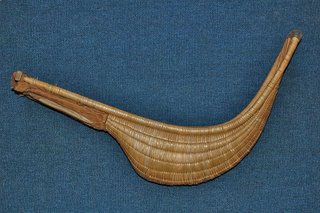
It is played with a basket called zesta-punta. This is supposed to be the fastest game in the world as the pelota (ball, handmade of virgin rubber, layered with nylon thread and two goatskin covers. Slightly smaller than a baseball and livelier than a golf ball, the pelota weighs about 4½ ounces.) has been clocked at over 300kph and can shatter bulletproof glass.
Watching my favourite pelotaris play the game was a thrill that has rareley been equalled. I get ráfagas (a lovely Spanish word that means flash or streak) of this thrill when I listen to solos by Marc Destrubé or a rose super-performs in my garden, the bloom drawing my attention with its perfection of shape and scent. I had several ráfagas of this thrill watching the virtuoso performance of the all-male cast last night of Glengarry Glenn Ross and in particular that of Bill Daw and of Alex Ferguson playing Richard (Ricky) Roma. The latter could be an inspirational speaker at a $500 a plate dinner. He was that convincing and smooth. Bill Daw with the simple movement of his semi-closed eyes or the raising of an eybrow was triumphant one instant and defeated in the next. Watching Dow was like watching Chicuri or Solana gather the ball with their cesta and hurling it at the frontón (wall) with that dizzying speed that thrilled me so many years ago.
If I didn't get 100% satisfaction at the play it had all to do with the fact that I don't work from nine to five from Monday to Friday. If this were the case, after a frustrating hard week of the office, Glengary Glenn Ross, much like Sam Peckinpah's Straw Dogs, is the perfect play to see on a Friday night. It was funny too. We were sitting next to Vancouver Sun theatre reviewer Peter Birnie. The three of us seemed to laugh in unison. What fun to have fun!

When I scanned this panoramic slide last night for my history of photography class at Van Arts today (the class was about landscape photography) it almost broke my heart. Here you see Rebecca taking pictures of a flock of flamingos in a lagoon in Yucatán. That's Rosemary on the left. The sky is so blue and Rebecca so slim and girlish. The world was at her feet.
Rebecca (11) has been crying these days as she maneuvers into adulthood in what could be a highly shortened teenagehood. Many in school shun her. I am sure it has all to do with her perceived sophistication. Math isn't all that easy and taking care of her guinea pig Pablo is not the pleasure she thought it would be before she received him as gift. Life is hard.
If there is anything I am completely helpless about, it is in dealing with crying women. I will do anything (within my power) to make a crying woman stop. So I called Rebecca's mother and told her to ask Rebecca if she would want to go with me tomorrow afternoon to see Twilight. I wasn't there but I am sure Rebecca smiled. Even if the film is a dud satisfaction has already come this way. I look forward to my date tomorrow.

It is hard to believe that only 10 years ago a magazine (Nuvo) sent both Sean Rossiter and I to do a story in San Miguel Allende, Mexico. The story hinged around a BC aviation pioneer called Bob Engle. It was Engle (here with his wife Roxy) who provided us access to his Cessna Citation which flew us from Vancouver to Querétaro, Mexico where we were then driven to San Miguel.
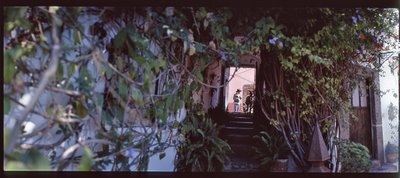
In San Miguel we stayed with the Engles and we had as a visitor their landlord who happened to be ex Olympic skater Toller Cranston who now was a well-known painter in the San Miguel De Allende artist community. Here you see him in his large and beautiful studio.

While there I never stopped thinking at the luck I had in having been flown there and being able to share the hospitality of the Engles and enjoy the food, the sun and the smells of Mexico.
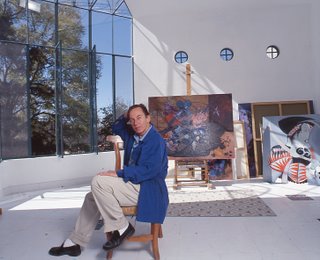
One other visitor was Jennifer Hamilton. She was in her 70s. She was a retired ballerina from New York City. I fell for her and became her lap dog. I watched how graceful she was and questioned my senses, after all she was at least 18 years older than I was. I don't think I had ever fallen for an older women before or since. It had to be the dance aspect of her!

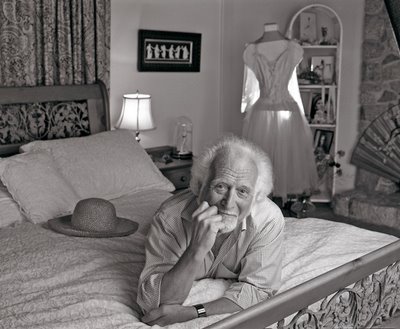
I have written often here about my love for dance. When my daughters were young I took them to every Vancouver appearance of any internationally known dance troupe. I did this because I thought it was my obligation as a father. It has all become a blur and I remember taking them to see the Alvin Ailey Dance Company. I remember black dancers all dressed in luminous white and the women were dancing with parasols. I remember nothing more. But I do remember waiting in my Fiat on cold rainy evenings outside the Vancouver School of Music on Chestnut Street. I would wait and wait while my daughters dithered and chatted with friends as they changed after their ballet classes with Mr. Lee. Mrs. Lee's method was to only pay attention to those girls who she thought had talent. She ignored the rest. My daughters were ignored and to this day I would say they are ambivalent about dance because of their experience there.
When I met and saw Evelyn Hart dance in the 90s I fell in love with her and with ballet. I soon became so intrested in the discipline that I went to modern dance and just about anything else (except tap which is where I draw the line). I was so smitten by Evelyn Hart that I went to the library in search of books on her. I found one, Evelyn Hart: An Intimate Portrait by Max Wyman. It was not difficult to understand that I was not the only smitten one!
Quite a few years later while chatting with Vancouver Sun staffer Nick Rebalski he told me that Wyman had a collection of ballerina slippers. I immediately called up Wyman and we worked together on a Saturday piece. for the Vancouver Sun.
In the last year I have had some difficulty promoting dance within my own family. Rebecca has the talent and presence but there is not much enthusiasm on the part of some of those close to her to promote it. Rebecca has abandoned dance. My only hope is that she will someday do as Katy Harris-McLeod who decided to be a dancer at 27 and in short order became one of our best and most interesting Vancouver dancers.
I have fond memories of going to Evelyn Hart's dressing room with Rebecca and having Rebecca give Hart a peppermint paddy with the idea that she might gain a bit of weight. In another occasion Rebecca and I went backstage after a Ballet BC performance and Simone Orlando took Rebecca to her dressing room and presented her with a pair of her point shoes.
When I interviewed Wyman a couple of months back at his home in Lions Bay I asked him which was his favourite room. His reply was most interesting:
It’s the bedroom I share with my wife. It’s the place of retreat, the place where I can go to relax. It is the place where I restore myself after the travelings [Bob I can’t confirm this spelling but that’s the word Max used.] of the day. I do my sleeping. It is also the place where I have a lot of things that are important to me. Beside the bed, on Susan’s side, we have a dressmaker’s dummy (that Susan made) wearing Evelyn Hart’s first tutu from her first Giselle. It is a very intimate and wonderful connection with a period of my life. Dance has been so much a part of my life and what I have done and how I have enjoyed myself. The bedroom is full of dance bits and pieces. It is full of the things we like to look at and of the places we have been. I keep whatever books I am reading here. It’s a haven.
How do these two women in your life live together in that room?
Very harmoniously, they are very good friends. Evelyn is beside the bed and Susan is in the bed. Susan recognizes that difference.
At this point Susan, who was nearby during the interview, interjects: I also got the dress for you. It was your birthday. I asked Evelyn for it.
'And that's tero-teros,' Nicky said. A pair of black and white plovers got up and circled above us, shrieking that the enemy was about. 'And that's the ugliest damned noise. Hates man, that bird. Absolutely hates man.'
In Patagonia, Bruce Chatwin

A few things conspired yesterday to bring on a terrible nostalgic melancholy.
A couple of days ago I finished the terrific novel Mr. Darwin's Shooter by Australian author Roger McDonald. I would have never read this book had circumtances not played out the way they did. I read the review in the NY Times when it appeared in 1998 but somehow I never saw it at a bookstore and I forgot. Last week when I took the B-line bus to teach my class at Focal Point (the bus stops at Sasamat and 10th Avenue) I did my usual routine of looking into the window of the used books store that alongside the stop. I have spent a fair amount of change there. Bookstores should never be at bus stops. In the window was Mr. Darwin's Shooter as a pristine first edition that had (by appearences) never been read.
It is a novelized account of the life of Symns Covington who was Charles Darwin's assistant during the trip in the HMS Beagle (1831-1836). Even after that trip when Covington settled in Australia he sent Darwin a large collection of barnacles which were to be as crucial as finches in helping Darwin arrive at his theory.
I was particularly attracted to the scenes where Darwin and Covington travel through the Argentine pampa. There are beutiful passages on how Covington loaded his bird gun so that birds would not be damaged by bullets. The finches, shot in the Galapagos were the most crucial in helping Darwin arrive at his startling conclusion on where we came from. One passage on gauchos caught my eye and started my melancholia:
The country people, the gauchos whose paths he crossed - and who gave him their hospitality at night - expressed their pride in never walking at all. They used their feet only in hobbling to their saddle beds, hopping to their fires of dry thistles for roasting meats and brewing their yerba mattee [author's spelling] teas. They used legs for jumping from thistle-clumps, cutting throats of Indians or each other as it pleased them. Covington's safety was up to their whims. He sensed their dangerous humours but left such decisions to God, and laughed in their faces. They were like cripples or were bred to be centaurs, you might think, living on horseback in their fresh-cut cowhide boots crusted with blood, with silver spurs and spaces leaving the first two toes dirty and bare. Such toes were made for gripping stirrups not dirt.
Then last night Hilary mentioned that every day she walks by 21st Avenue and Laurel and notices that the house where my Argentine friends Nora Patrich and Juan Manuel Sanchez lived for many years has been changed and remodelled. Hilary said, "It is as if they never existed." I got up and put on Mi Buenos Aires Querido which is my very favourite (up there with any Piazzolla) Argentine tango music CD and it has Daniel Barenboim on piano, Rodolfo Mederos on bandoneón and Hécotor Console on bass. This CD is exquisite but extremely sad. After the music I opened up my copy of Darwin's The Voyage of the Beagle and spent some hours reading his entries on the Argentine and Uruguayan pampas. One of my favourite sections is when he writes of the birds of the pampas.
The teru-tero (Vanellus cayanus) is another bird, which often disturbs the stillness of the night. In appearance and habits it resembles in many respects our peewits; its wings, however, are armed with sharp spurs, like those on the legs of the common cock. As our peewit takes its name from the sound of its voice, so does the teru-tero. While riding over the grassy plains, on is constantly pursued by these birds which appear to hate mankind, and I am sure deserve to be hated for their never-ceasing, unvaried harsh screams. To the sportsman they are most annoying, by telling every other bird and animal of his approach: to the traveller in the country, they may possibly, as Molina says, do good, by warning him of the midnight robber. During the breeding season, they attempt, like our peewit, by feigning to be wounded, to draw away from their nests dogs and other enemies. The eggs of this bird ar esteemed a great delicacy.
On January 1953 I was 10 years old and my parents sent me to the camp (the English in Argentina call the campo or pampa the camp). One song was played to death that January and the only way to escape it was to hop on a horse and ride into the pampa where the only sounds where the rustling of the thistles and the tero-tero cries of Darwin's Vanellus cayanus which we Argentines adore and simply call the tero. That's the sound that it makes and when the bird flies low and swoops there is a sadness in its call whose memory of it brings in me a longing as powerful as that of the tango.
The song I was doing my best to avoid was the cloying:
How much is that doggie in the window?
The one with the waggly tail
How much is that doggie in the window?
I do hope that doggie's for sale
I must take a trip to California
And leave my poor sweetheart alone
If he has a dog, he won't be lonesome
And the doggie will have a good home
How much is that doggie in the window?
The one with the waggly tail
How much is that doggie in the window?
I do hope that doggie's for sale
I read in the papers there are robbers
With flashlights that shine in the dark
My love needs a doggie to protect him
And scare them away with one bark
How much is that doggie in the window?
The one with the waggly tail
Composed by Bob Merrill and sung by Patti Page.
During my horse travels I did not fall for the trick of a large tero with his espolones (I am sure that Darwin did not chose to reveal his knowledge in the above passage from the Voyage of the Beagle that only the male of the species has the sharp barbs on its wing shoulders). I found the nest and picked up one of the birds (it was small) and took him home with me to Buenos Aires. My tero grew and he romped in the front garden. We kept its wings clipped so it would not fly away. Anybody even approaching our front gate was alerted to us by my tero's "tero, tero". I had a guard bird! A year later, not long before we moved to Mexico my Uncle Tony brought us a very large brown poodle, Moro. It didn't take long before I found my terito with its wings broken. I was heart-broken and to this day I can vividly remember my tero's voice and how elegant and patrician he was.

Linda Lorenzo that beautiful Argentine woman who faced my camera and on whose body I layered all my memories of Argentine nostalgia is seen here as a tero with her elegant bolts of black, white and silver satin.
It's dawn and things move about quickly,
a bird sound at the end of every sentence,
the period disolves and becomes a curve of notes
Robin Blaser
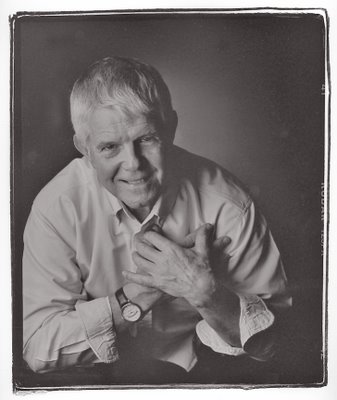
On election night Abraham Rogatnick and I went to a concert at St. Andrews-Wesley on Burrard and Nelson. The concert featured the Erato Ensemble and friends. This particular concert was dedicated to 7 British Columbia composers. All the music was brand new. The Erato Esemble is an interesting but ever so slightly odd musical group as they bring together voices, pianists and such instruments as the saxophone, the flute, the guitar, violin and the cello. This means that the group can play almost anything once it is adapted to their instrument makeup which varies depending on needs! The Erato Ensemble is not your usual chamber group.
The concert began with a cello and piano piece by Timothy Corlis called Prelude, for the night of the lunar eclipse. Pianist Rachel Iwaasa and the interestingly named cellist Stefan Hintersteininger instantly wowed me to the outstanding acoustics of the church. But then I was front row aisle seat and the cellist was only a meter away.
The next pieces were by composer Mark Armanini (below right with Vivian Xia). It must be nerve-racking to hear your music performed for the first time. Armanini was either trying to quit smoking or he was simply nervous as he chewed gum all night! His music blends a western sensibility with the music of China. During most of the performance of the 5-part Chinese Folksongs my eyes were on the hands of pipa player Guilian Liu. If there was ever an instrument (besides the harp) that is ballet of the hands the pipa has to be the other. Mezzo-soprano Grace Chan gave me an inkling (heard later in the composition of Leslie Uyeda) of her extraordinary presence and volume all wrapped around a most pleasant smile as if saying, “This is so easy.” I am sure it wasn’t. It srikes me that Armanini’s music and much of the music of the evening would be perfect for our Olympics. Armani then gave us some sweet songs with tenor William George and guitarist Michael Strutt.
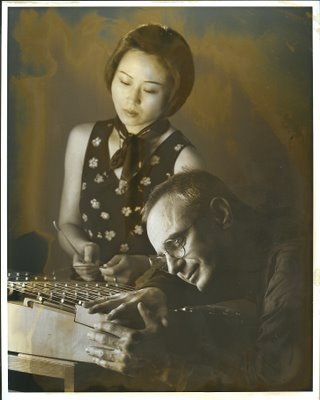
I am not a lover of the soprano saxophone buy Julia Nolan (and Rita Attrot on piano) somehow made Denis Bedard’s Fantasie sound smooth and mellow in the smooth and mellow parts. Colin Macdonald (of the Macdonald Pocket Orchestra fame) was there and he proudly said that Julia Nolan had taught him to play that soprano sax.
Rodney Sharman was much more cheerful than usual as his two compositions, Cabaret Songs featuring tenor William George, baritone Joel Klein and pianist Rachel Iwaasa, were funny, especially Au Revoir, Maria Callas with text by Bill Richardson.

At the intermission my friend Abraham Rogatnick went to a victory celebration of the party of his choice and left me sitting next to poet Robin Blaser, a magnificent man with white hair whose profile is a Rushmore.
Leslie Uyeda’s (below right with librettist Tom Cone) The Great Sea with words by a Netsilik Inuit woman Uvavnuk was a powerful blast by mezzo-soprano Grace Chan accompanied by Rachel Iwaasa.

When we listened to Russell Wallace’s Dreams poet Robin Blaser’s face instantly went into a smile as soprano Emily Cheung’s voice seemed to soar to the church rafters. He looked like a little boy on the last day of school. At that point and with Wallace’s next piece Qanimenskan Ku Tmicw (I have heard the earth) I believe the whole church was delighted with music that exceeded their expectations.
The next piece, SunarcanuS (Act 2 with poetry by Roya Ravanbakhsh) was program music with a twist. Composer Farshid Samandari instead of chewing gum like Mark Armanini seriously transported himself into the percussion corner with instruments including an Arthur Rank type gong. Director Terry Pitt-Brooke had both hands going. He directed with his right while he flipped with his left a chart with numbers in 5 second intervals. It seems that this piece, a little duel between the left hand side and right hand side of the brain (with soprano Emily Cheung and mezzo-soprano Grace Chan and the full Erato Ensemble) had no predetermined tempo. This bit of avant garde music challenged me but did so gently.
It was Lloyd Burritt’s (very top, left) Lake of Souls that finally made me smile at my lucky stars. Burrit explained that the text of his composition was from a poem he had been exposed to when he was 7. He pointed at the man (sitting next to me) as the poet. I looked at Blaser and asked him, “ If Burritt was 7 then how old are you now?” With a smile he answered, “ I am not prepared to tell you that at this time.”
The whole piece with soprano Emily Cheung, mezzo-soprano Grace Chan, tenor, William George, baritone Joel Klein, flutist Tanya Klieforth, violinist Yuri Zaidenberg, saxophonist Julia Nolan and cellist Stefan Hintersteininger was, from my vantage point, a complete delight. The director’s right hand was mere inches from my face (that’s how close I was to the action) and on my right Robin Blaser, with a smile on his face seemed to be projecting on the singers the text of his poem for the first time.
As it all ended I wondered at the tragedy of so much of contemporary new music. You hear it once and then… But Burritt told us that the concert had been recorded.
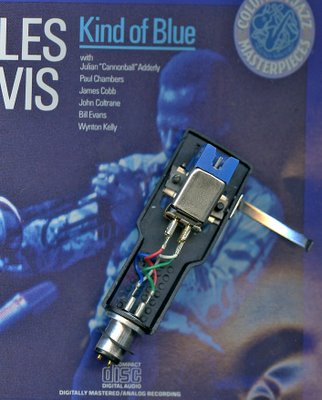
Much has been written about the impossibility of being able to read all the good books around in one lifetime. Something similar could be written about the time needed to listen to all of Bach's cantatas or Haydn's symphonies. When long-playing records were king, not all (very few) where competently manufactured. Music came with built-in pops. It was then that I learned to use my imagination and I could listen to the sound without the pops. When CDs came out the noises were gone. No matter how many people who told me that these CSs were diminished in warmth I didn't notice it much. I simply put in the warmth with my imagination. At age 66 I have discovered the ultimate sound system. It is the ultimate "green" sound system.
At my age I don't have all that much time to listen to world music or the latest revisionist punk bands. I am settled to liking the music I like. Every once in a while (I lie, much more frequently it is) I go to live baroque concerts where I listen to composers that never existed when A&B Sound was king of the mountain. These almost-long-lost baroque composers are wonderful. They have lived under the shadow of Vivaldi and Bach for too long. It is only recently that I have heard some of their music live and enjoyed the first symphonies of many composers like Beethoven. These first symphonies or first piano sonatas are rarely played. I even attended a performance of that odd (only the number is odd, but not in a mathematical sense) zero symphony by Bruckner!
What is that ultimate sound system? It is my memory. I can sit down with a decent cup of strong tea and play the whole Miles Davis album Kind of Blue in my head. It is free of pops and it is not compressed. The sound is all there. With my imagination I can re-live that magical moment that was the first time I heard Jazz Samba with Stan Getz and Charlie Byrd or the winter largo from Vivaldi's Four Seasons. I can imagine myself driving a Maserati Biturbo while the lights of Seattle pass quickly by as I pass through the partly covered city freeway while listening to London Calling.
There is one exception to this ultimate sound system and that is going to a concert of new music. I did this last night. I will write more about that tomorrow.
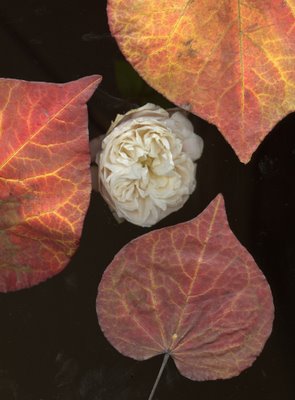
About 15 years ago Rosemary had her heart set for obtaining a Cercis canadensis 'Forest Pansy'. This tree, commonly called the Eastern Redbud grows very well in Ontario. I likes an intense hot summer and a cold but dry winter. There were then few (and even now) specimens of the tree in BC and in Vancouver. They don't like our rainy winters and the short hot summers. We planted one anyway in a secluded area of our back garden. The tree fluorished and grew rapidly delighting us with the red/purple buds in spring before any leaves appeared. The tree is a wonder to behold in the summer when the reddish/green leaves shine when the sun acts as a backlight. The sight of the fallen leaves in the fall with their intense yellow and red further attached us to our tree. A severe windstorm three years ago tore down our white picket fence and several trees almost went down. One of them was a juniper that was leaning precariously in the direction of our living room. There was no way of propping it up with cables as the cables would have been on the street side. Our Cercis went to the ground and Rosemary was in tears. We called the folks at Bartlett Tree Service and they streightened the tree and secured it with a cable. We then hoped for the best. Three years later our Cercis is doing well and Rosemary smiles when she looks out of the window.
A week ago we were admiring our tall Ginkgo biloba . It leaves were a golden yellow. I told myself I need to photograph the tree. Alas! That evening there was a windstorm and the next day the tree was all but bare!

Today when Rosemary and I went to vote for the municipal elections I noticed a rose in bloom in the front garden. Considering the date and the wet weather is is most unusual to see a rose in bloom that is a multiple-petaled English Rose. But then its name 'Immortal Juno' might just be significant. Juno was Zeus's wife. Greek goddesses in spite of their human traits were indeed immortal.
After I scanned the cercis and the ginkgo leaves. After I scanned Immortal Juno I had the unusual pleasure of smelling spring in November. The intense myrrh scent nudged my brain's sensory perception. Could spring be just around the corner in fall?
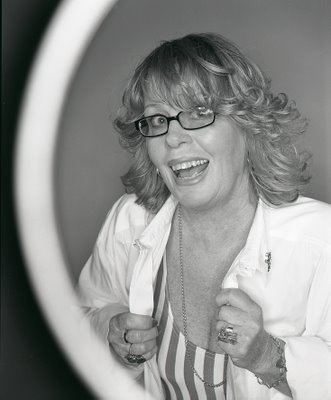
In Spanish the saying is, "Nadie es profeta en su tierra." It seems to sound that much more final in Spanish that no one is a prophet in their own land.
As a photographer I always try to do my best. As a commercial photographer I don't perform in direct relationship to how much I get paid. I feel I must give my best. I show my photographs to my wife. I may be proud of a particular photograph and when she sees it she looks at some obscure corner and (finding some hair that is askew or a finger not in place or some wrinkle here or there) and usually says, "What's that?" I dismiss her criticism. I take the photograph to some competent art director who upon seeing the picture (notices what Rosemary noticed) says, "What's that?"
In the end (and I am convinced of this) you are only as good as you think you are. If you think you are good and you have been around the block you might just be almost right.
After 35 years in Vancouver I have seen many photographers come and go. Some were one or two month fashion wonders instantly superseded by the next two-month wonders. Few of them ever stayed. One of the best, Howard Fry, retired to Saltspring Island. There is James La Bounty, Hans Sipma, Roger Brooks, Doane Gregory, Raymond Lum and a couple more I may have forgotten. As for the new young ones I am sure time will tell.
There is one photographer who has remained and never given anything but her best. And she gives her best with a smile on her face. It is difficult to be a photographer in Vancouver and still be cheery. Rosamond Norbury is cheery and she is very good. And she is one of the few Vancouver photographers who manages to be commercial when it is necessary while not sacrificing her art side. Some of the serious stuff she does at Malaspina Printmakers on Granville Island is seriously good.
Every once in a while I run into Norbury. She is quick to smile. I smile back and I remember the best thing anybody ever said about my work, "Alex, thank you for not having ever taken a bad picture."
I do hope that after seeing this picture I took of her a few years ago she does not change her mind.

Sometime in the mid 80s during an economic recession, Vancouver Magazine editor, Malcolm Parry decided to run a "service piece" (a thinly disguised editorial that wasn't) called Good Things In Bad Times. I was dispatched to photograph $15.00 (the price then) Cuban Montecristo cigars, an economically-priced but very good Spanish Rioja wine and a few other things.
Watching the Playhouse Theatre Company's first play of their season, Lisa Lambert, Greg Morrison, Bob Martin and Don McKellar's The Drowsy Chaperone , directed by Max Reimer, and seeing my usually somber wife smile, I understood Malcolm Parry's idea about good things in bad times. In fact The Drowsy Chaperone is a very good thing for very bad times.
A few months back my wife and I enjoyed the Arts Club Theatre musical The Producers which coincidentally (with a purpose, perhaps?) also had Jay Brazeau in the cast. My friend author and Georgia Straight movie critic John Lekich pointed out that producing such a musical with a large cast and very good dancers and singers was no easy task in these times. He told me, "Whe should lap up such stuff when it happens as it doesn't very often."
Before I throw unabashed praise on The Drowsy Chaperone let me point out my pet peeves. As a Latin American born in Buenos Aires I have understood theatre, film and opera but I have never comprehended the concept of musicals where people, out of the blue, suddenly begin to sing or to dance. A cultured Mexican friend of mine is unable to handle exotic dishes that feature sweet and sour or sweet and salty. He likes to have his stuff separate. Perhaps my 35 residence in Vancouver has softened my stance on musicals so that I can enjoy them. My other pet peeve is more difficult to reconcile. I absolutely hate tap dancing and there is lots of tap dancing in the The Drowsy Chaperone.
With that all cleared up I must assert that when tap dancers Laird Mackintosh (Robert, the groom) and Ryan Reid (George, the best man) did their stuff it was done well. But it was tap dancing. Then David Marr (Underling, the butler/servant) appeared on the scene. This usually extremely serious Vancouver actor ( His Greatness) did his little tap sequence between the other two. I laughed. Tap dancing must have its moments!
While I am 66 I am still an admirer of not only talent (she's got it) but of beauty and especially legs. Debbie Timuss (Janet) has legs that somehow are even more luscious by whatever stockings costume designer Phillip Clarkson made her wear. Timuss's dresses (Clarkson again!) are all designed to show off those legs and a white teddy later in the show made me feel 20 again.
Legs don't stop with Timuss. They keep on going with Nathalie Marrable (Kitty). She is forced to speak and sing with a ditzy voice so I spent more time looking at her legs. My distraction with legs was compounded when the gangsters (disguised as pastry chefs) Neil Minor and Shawn Macdonald, in photo above left, appeared. My, what legs!
I spotted Dal Richards in the audience who must have felt the same way as I did in enjoying the big band sound of the small group of musicians (Nick Apivor, Derry Byrne, Thomas Colclough, Rod Murray and Lloyd Nicholso, the musical director). How often do you get to hear a trombone?
As I watched the versatile and extremely funny Jay Brazeau play Man In Chair (sort of like a physical narrator who steps in, here and there, to tell you what is going on in his mind as the shenanigans on stage are what he sees with his imagination as he plays the records of this fictitious show set in the roaring 20s) I kept thinking of an older and chubbier Mike Harcourt with a tad more hair. Apparently this was no accidental connection on my part. My friend Abraham Rogatnick (who played the rabbi with Brazeau in the Playhouse's production of Fiddler on the Roof ) told me today that Brazeau often imitated Harcourt when Harcourt was our mayor. As I watched Brazeau's jovial performance I suddenly remembered that he had played a mortician in Lynne Stopkewich's 1996 film, Kissed. Now that's range.
If this wonderful play had been a dud I would still have liked it simply because it champions the use of one of he most beautiful and evocative words of the English language that has all but disappeared in our politically correct times. And that is aviatrix. The Drowsy Chaperone features an almost full scale WWI biplane (Take that, Miss Saigon!) and Trix (a black and very independent aviatrix played by Tshol Khalema).The play ends in a scene right out of one of my favourite films, the 1933 Flying Down To Rio with Fred Astaire, Ginger Rogers and Dolores del Río.
And if that is not enough there is Gabrielle Jones playing an always tipsy (is it iced water, is it vodka?) drowsy chaperone. Her "spraying" scene with the very funny (how was I to know of this hidden talent of his?) David Marr rivals the blind roller skating scene but I won't go into that one. Nor will I venture to reveal the identity of the most talented building manager in the business who has a key role in this production.
The Drowsy Chaperone runs until December 27.
It's A Wonderful Life - A Vancouver Tradition
Thursday, November 27, 2008

Last night I attended the Arts Club Theatre production of It's A Wonderful Life directed gleefully by Dean Paul Gibson, left. I wrote about this last year here. Seeing it for a second time did not diminish my enjoyment as I saw it not with my wife Rosemary but with my daughter Hilary (Rebecca and Lauren's mother). Hilary sees very little theatre because I take Rebecca to as many theatre performanes as I can. Hilary's first comment at the intermission was, "This is not at all like the high school productions I used to attend as a teenager! This is professional." But what really made the play such a pleasure for Hilary has to be what I think is really a Vancouver tradition in the performing arts. Let me explain.
Many years ago when Hilary's older sister Ale was around 12 I took her to an Andrés Segovia guitar recital at the Orpheum. At the time Ale was taking guitar lessons at the Vancouver School of Music. A very taciturn Segovia walked into the stage and sat down without any explanation. He silently left after his virtuoso performance. I told Ale, "Go to that side door and wait. Knock and somebody will let you in. Perhaps Segovia will autograph your program." Ale did just that and I saw her disappear behind the side door. When she came back, with a big smile on her face, she told me, "Andrés (he asked me to call him that), picked me up and gave me a hug. Since I spoke in Spanish to him he told me in his Castilian, Alejandra, I did not say anything during the performance because I lost my voice in the airplane from Spain." Ale has not forgotten Segovia's warm welcome and warm (if diminished) voice.
Since then I have managed to go back stage (without much problem) at theatre performances, the ballet, modern dance, the Vancouver Symphony, the Vancouver Opera, musical performances at the UBC School of Music, the Chan, the Vancouver East Cultural Centre. One of the many highlights has been able to go back stage at Ballet BC rehearsals and watch the action from there. During rehearsals of the Vancouver Philharmonic Orchestra its former director Juan Castelao used to allow Rebecca and I to sit a meer three or four ft behind him. And of course after performances of the Pacific Baroque Orchestra or of famous luminaries of the baroque world in Early Music Vancouver concerts I have mingled and shared thoughts with, the likes of Monica Huggett and Andrew Manze both violinists that can only be compared with our very own Marc Destrubé.

But the best of all was my being multiply kissed in the cheek by cellist and conductor Mstislav Rostropovich backstage at the Orpheum after a VSO performance.
It is this Vancouver tradition of opening rapport between performers and the audience and making it so accessible that amazed my daughter Hilary last night at the Arts Club Granville Island Stage. We talked to the actors and had a warm chat with director Dean Paul Gibson (above, left) . Hilary wanted to congratulate actor Bernard Cuffling who played the not quite winged Clarence the angel. I took my opportunity to tell him that I missed his motorcycle. He winked at me as he understood my reference to his wonderful performance in the recent Arts Club Theatre production of The History Boys.
You learn quickly and for the better that Ballet BC dancers, modern dancers, musicians, conductors, directors are not gods. You learn that they put their pants on one leg at a time and that they sometimes have to eat Kraft Dinners like we sometimes do. But you also learn and admire their passion, skill and determination to avoid and transcend the mediocrity that is taking over our lives. You learn that while there is not much interdisciplinary cooperation in Vancouver amongst the performance organizations there is a sense that every once in a while one has to circle the wagons and save the troops. Bill Millerd in his usual little warm talk before last night's It's A Wonderful Life said, "Let's all go out there and buy tickets to the Nutcracker. Let's save Ballet BC." Yes!
It's a Wonderful Life runs until January 2, 2009
My Debt To Ballet BC - An Apologist's View
Wednesday, November 26, 2008

Subject: Tragic - Ballet BC terminated
Dear Friends,
We have our work cut out for us. The cancellation of the CBC Radio Orchestra, huge cuts within the CBC with more potential layoffs announced today and now this. In my opinion, Ballet BC is the best arts organization in Vancouver and we need to save it. It's cutting edge artistic and run by the brilliant, creative and innovative mind of John Alleyne. We are so lucky to have them in our city and to have them represent Canada abroad. Please encourage people to go to the Nutcracker - if there are enough seat sales, we can save this jewel and hopefully save an important part of culture in our city.
Thank you all,
Tiko Kerr
I received the above this morning. My friend Richard Dal Monte and editor at Tri-Ciy-News had sent me the Vancouver Sun article yesterday morning so I was already in a bit of a shock. I thought about it all night and slept badly. The above letter from artist Tiko Kerr made me think on my relationship with Ballet BC which began sometime around 1995 when I started shooting dance pictures for the Georgia Straight. Here (above) is one of my earliest ones with Ballet BC Director John Alleyne and dancer Gail Skrela.
It all began with an infatuation (love perhaps?) of watching Evelyn Hart dance, meet her and take her photographs. Evelyn Hart was my introduction into the wonders of ballet. From there I had to see more ballet so Ballet BC became my ticket. I became such a fan that I would notice when dancers would lose or gain weight or when they got new hair cuts. I could not understand why more people did not try to secure access to back stage or rehearsals. I felt many years younger because I became a groupie. I watched my swans prepare back stage. Many wore fluffy rabbit bedroom slippers to keep their feet warm!
But there was another awakening in myself that was all due to my experiences with Ballet BC. Going to some of the premiere performances I would note groups of men usually dressed in black (with some wearing leather pants). They were evidently gay and were there to enjoy the beautiful male dancers. I felt a bit on the dirty side as I was there to admire the beautiful female dancers. It was at about this time that I wrote a piece for the Vancouver Sun and for the CBC Arts Web Page about the sexual aspect of ballet and dance. I felt that as a man I should be able to proudly assert that I especially liked ballet and dance because the women were beautiful and graceful. Why was it that only the men who liked the boys could get away with it?

I soon found out what those men were enjoying because I too began to feel within me the excitement of seeing men dance and I was affected by their sexuality much in the same way as I was when I watched the women dance. Soon I was a fan of the men, too and I noticed when they had new haircuts. It was as if my pleasure at being a fan of Ballet BC was twofold. It was!
I began to realize that manliness and passion had nothing to do with sexual persuasion. My most favourite male dancer ever, (seen below painting on Tiko Kerr's head), was passion on the floor. I enjoyed every performance of his as if it were his last and to this day I regret that he never played Dracula! The three young men are from left to right, Chengxin Wei, Justin Peck and James Russell Toth.

Thanks to Ballet BC and dance in Vancouver I persuaded my daughter Hilary to put Rebecca into dance at Arts Umbrella. Her first teacher was Ballet BC's Andrea Hodge.It was at Arts Umbrella that I noticed the young boys and men of the company and how I could watch them without any personal embarrasment. I was watching dancers dance well. Their sex was irrelevant. It was thrilling. I even managed to write about it for a local magazine VLM. The interviews helped me understand the intelligence and approach of the taciturn Ballet BC dancer Edmond Kilpatrick, seen below, left with Acacia Schachte and Sandrine Cassini.

I will not argue that culture is important and that we must put more effort in attending (and buying tickets) dance, theatre, opera and musical performances. Not having a ballet company in Vancouver is a tragedy and Tiko Kerr points out that they represent Canada very well abroad.

I would only add that in many respects even with the death (I hope a most temporary one) Ballet BC represents us well even now. Lauri Stallings, seen here inspiring composer Owen Underhill at the piano, recently choreographed (one of the dancers she directed was Paloma Herrera) for the American Ballet Theater in New York City. And our very own Arts Umbrella alumnus and Ballet BC dancer Acacia Schachte dances for the prestigious US Cedar Lake contemporary ballet company. One of the choreographers is Crystal Pite also a former dancer from Ballet BC who went on to dance for the Frankfurt Ballet and is now in Vancouver directing her own company Kidd Pivot. And Ballet BC talent doesn't stop there. Some years ago Ballet BC Director and choreographer (seen here with dancer Gail Skrela) lured Frankfurt Ballet dancer Emily Molnar to Vancouver who was one major reason for steady shift from the company's classical ballet into the exciting new direction of modern ballet and modern dance. Emily Molnar now has her own dance company and she is busy traveling the world as a highly rated choreographer. There is Ballet BC blood there seeping into the dance culture of the world.

And we must not forget that through the years Ballet BC has attempted, when possible and when budgets permitted, to use original and live music to accompany its dancers. One of the more elaborate performances was Carmina Burana and Carmen where full-sized orchestras were used. This meant jobs for free lance musicians and composers as in the recent Fairy Queen. In recent times many of the new ballets (like the Fairy Queen) were choreographed by John Alleyne. I wondered why we had not recently seen anything (as an example) by choreographer William Forsythe. After all when Alleyne started at Ballet BC we were exposed to many of Forsythe's ballets. The answer (from that graceful horse's mouth, Alleyne himself) was a teling one. I asked him a couple of months ago. He said,"In order for us to mount a Forsythe ballet we have to pay a royalty upwards of 75 thousand dollars plus we have to pay air fair and accomodation for one of Forsythe's'representatives to monitor our production.
There is one more debt of gratitude that I have for Ballet BC. The company in the many photo assignments that I had with them inspired me to shoot some of the best photographs of my career. This inspiration has not stopped as dance is now a very big chunk of my life. John Alleyne, Ballet BC, Miroslav Zydowicz, Andrea Hodge, Simone Orlando, Acacia Schachte, Edmond Kilpatrick, Lauri Stallings (seen in last picture here with Miroslav Zydowicz), Crystal Pite, Emily Molnar and so many others thank you and come back soon.
A French Connection & The Other Darwin
Tuesday, November 25, 2008

Some 29 years ago I went Claudia Beck and Andrew Gruft's Nova Gallery on 4th Avenue and saw a print (printed by the photographer) of Moonrise Over Hernandez, New Mexico by Ansel Adams. It was superb hanging in the middle of the room suspended by wires from the ceiling. For many of us this was the Holy Grail of the landscape photograph. It was the perfect landscape. We knew that Adams had been able to take but one exposure from a camera on a tripod on the roof of his pickup. We also knew that the one exposure was close to perfect because Adams knew the luminance value of the full moon. For many who dabbled in landscape they would often say that Adams's pictures were good only because he had the money and patience to wait for the best light.
What is the best light? As an example consider the problem of a landscape that has three separate areas.
1. A dramatic sky with puffy or storm clouds.
2. A middle region that is often a mountain chain with snow capped peaks.
3. A third region which us usually a valley (streams or lakes) in the shadow of the mountain range.
No b+w film or slide film can accommodate the three values. If you expose for the dramatic sky the snow on the peaks will go gray and the valley will be black. If you over-expose to get detail in the valley the snow will lose its detail and the sky will be disappointing. Adams waited for the best light and had his own personal trick that he called his Zone System. It worked with separate sheets of b+w film in larger formats but it failed with transparency or slide film.
For many years pristine and perfect landscapes were rare. We photographers would be wowed when we saw them. There was a large postcard demand for these pristine landscapes.
Then about 40 years ago a French company called Cokin revolutionized landscape photography with the mass distribution of its partial neutral density filters which were made of plastic. They were relatively expensive and you really had to take care of them as they scratched easily. Here you see such an example. This filter was large enough for most of my 35mm wide angle lenses. If you positioned the dark area on the top of the lens, the darkness would prevent light from entering your camera and exposing your film. As you took an exposure that was correct for that dark valley the neutral density (meaning it did not add or subtract colour) the resulting overexposure on the dark dramatic cloud was compensated by the top half of the Cokin filter. These filters came in all sort of gradations with narrower or darker bands of darkness. Then Coking came up with coloured neutral density filters. Instead of dark areas these areas would be in colour. The most popular was a reddish one that was called the tobacco filter. These filters started creeping into movies particularly the ones that were about the rosier time of yesteryear or in old cheddar TV ads (this is the way we used to make our cheese and this is still the same way we make it now).
One of the first things I did after marrying Rosemary in 1968 (but there is no connection) was getting a membership (this was before the magazine went public and you could buy it in newsstands or get a subscription) to the National Geographic. Thanks to the inept and corrupt Mexican postal system I never got more than 8 issues per year. I vowed to someday move to a country were I would get all 12 issues per year. This finally happened in 1975 when we moved to Vancouver. At the time I was dazzled by the photography of the magazine. But it was also at this time that Cokin was making itself known and I was disappointed and dismayed to see photograph in the Geographic (Robert Louis Stevenson's tomb on top Mount Vaea on Upolu, Samoa) at about that time that had used the tobacco filter. The photographer had not waited for the light. The photographer had cheated.
I am happy to report that the Geographic from my vantage point has become again a magazine that is most important in my life. The photographs of animals in the current issue (December) in an article on Alfred Russel Wallace are terrific and the article so interesting I am going to look for a biography on this man that the Geographic calls The Other Darwin. The magazine is a delight to read as it no longer seems to tow the US political line and when it reports on a country that is a dictatorship is says so. At one time the Geographic photographers would keep the horizon near the bottom of the picture. You never saw the squalor, the poverty or the dirt. That is long gone as the horizon has increasingly moved upwards.
Cokin is still in business but the digital camera industry will soon probably do it in. Photographers are now able to shoot that landscape (the sky, the mountain range, the valley) in three separate exposures and there are many cheap programs that will meld all three exposures seamlessly. If you pick up any photo magazine your eyes will soon grow tired or even blind to the page after page of perfect landscapes in intense colours. The reflections of the mountains on the lake are as perfect as the mountains themselves.
Looking back at the picture of Stevenson's tomb on Samoa I now don't see it so much as a travesty. It was only a modification of existing conditions that film could not handle. The eye can look at those three separate aspects of the landscape. It is the camera with film that fails. Now landscapes can all be perfect. As perfect as all those photographs of perfect models that even lack pores in their faces.

Can it be that we will no longer be thrilled by a picture taken from the roof of pickup as a one shot?
Imperato Stabile - Romano-Lax & Siam Di Tella
Monday, November 24, 2008

Memory and its selectiveness has fascinated me for a long time. I cannot fathom how it is that I spent close to six months seeing my father every Sunday afternoon in Buenos Aires in 1965 before he died and yet I cannot remember any of our conversations. Perhaps the only proof that it all happened is a photo that I took of him with my Pentacon F camera. I do remember that I snapped it on a Buenos Aires street named Carabobo which I have always thought to be a funny name even though it was the name of the decisive battle that Simón Bolivar won against the Spanish in 1821 and gave Venezuela its independence. And I have a fond memory of the oddly named Siam Di Tella car that my father (far right, in picture, left) is leaning on.
Some 28 years ago I used to frequent Vancouver's Commodore Ballroom with Vancouver Magazine rock journalist Les Wiseman. There was a young man that Wiseman kept introducing me to who was always at the concerts. I would invariably forget the young man's name. One day I ran into him on the street and told him I would never forget his name again because I used the trick of associating his name with Scottish patriot Robert the Bruce. Unfortunately this never did work. When I would see him at the Commodore I would think, "Is his name Robert or Bruce?"
Bud I do pride myself for my good memory for historical facts, for botanical names, the names of books and their corresponding authors and my memory for rose smells is acute as I can discern variations within the myrrh scent varieties of English Roses. I don't say I am good with botanical Latin because a friend, Donald Hodgson a Latin teacher told me that botanical Latin has more of the Greek than of the latter. I have noticed that my botanical nomenclature in both Greek and Latin is good from Spring until late fall and then as the garden collapses and disappears my nomenclature fades, too. As soon as those plants begin to emerge in the spring their names are instantly retrieved from my memory banks!
Memory is much in my thoughts as I am reading Umberto Eco's The Mysterious Flame of Queen Loana . It is about a man who wakes up with selective memory. On Wednesday I was browsing at Chapters on Granville and Robson. One novel (a period novel) caught my eye because the author's name was in what looked like classic Latin. I looked at the author photo and found out she lived in Alaska. I was intrigued. I put the book back when my eye caught a large print edition of a Donna Leon, Commissario Guido Brunetti mystery and I instantly bought it as I have a few relatives with poor eyes. I forgot about the Alaskan author with the Latin name.
On Saturday night Rebecca and I went to see Twilight. When the credits were running in the end I was struck by a name. The unit manager of the film was Michelle Imperato Stabile. I dropped Rebecca off and as soon as I got home I punched the name into my computer but I found no mention of this woman being an author. Was my memory playing tricks? I tried different combinations of the name but found no novelist with a Latin name.
Today on my way to Van Arts I stopped at Chapters. I remembered exactly where the book had been and it was gone. I returned later and asked Nancy (she has a prodigious memory for the names of her book in the store) and we drew a blank. I told her that my only remaining solution was to stop at the other Chapters on Broadway and Granville and look there. Either I was crazy or the bookstore computer bank was in error.
In the other store I did not find Michelle Imperato Stabile. As I was about to leave I noticed a novel called The Spanish Bow. The author's name was Andromeda Romano-Lax. I looked for the author photo. Yes! She lives in Alaska. And yes, this time around I purchased the book.

The picture you see here of the author is taken by her husband Brian Lax. And of course my friend Donald Hodgson would have immediately pointed out that Andromeda was a Greek mythology name and that she was the daughter of Cepheus and Cassiopeia and wife of Perseus, who had rescued her from a sea monster.
From Orality To Literacy To Visuality While Curling Up With P.D. James
Sunday, November 23, 2008

Today I read every article in my Sunday NY Times Magazine twice. In particular I was struck by Becoming Screen Literate by Wired writer Kevin Kelly. The second and third paragraphs of his essay hit home and you wonder what Marsahall McLuhan would write about a world he might have had a inkling of but could never have predicted the present we live in now.
When technology shifts, it bends the culture. Once, long ago, culture revolved around the spoken word. The oral skills of memorization, recitation and rhetoric instilled in societies a reverence for the past, the ambiguous, the ornate and the subjective. Then, about 500 years ago, orality was overthrown by technology. Gutenberg’s invention of metallic movable type elevated writing into a central position in the culture. By the means of cheap and perfect copies, text became the engine of change and the foundation of stability. From printing came journalism, science and the mathematics of libraries and law. The distribution-and-display device that we call printing instilled in society a reverence for precision (of black ink on white paper), an appreciation for linear logic (in a sentence), a passion for objectivity (of printed fact) and an allegiance to authority (via authors), whose truth was as fixed and final as a book. In the West, we became people of the book.
Now invention is again overthrowing the dominant media. A new distribution-and-display technology is nudging the book aside and catapulting images, and especially moving images, to the center of the culture. We are becoming people of the screen. The fluid and fleeting symbols on a screen pull us away from the classical notions of monumental authors and authority. On the screen, the subjective again trumps the objective. The past is a rush of data streams cut and rearranged into a new mashup, while truth is something you assemble yourself on your own screen as you jump from link to link. We are now in the middle of a second Gutenberg shift — from book fluency to screen fluency, from literacy to visuality.
In my own way I have written here how our computer monitor and flat screen TV viewing has changed our perception of three dimensionality as we go towards a future when exploring a museum will be all with our Dell 2408 monitor as we pay Getty Images for a two minute viewing of La Gioconda.
I am so used to injecting hyperlinks in this blog that I feel frustrated when I read a novel or non fiction book and I notice a word I don't know or the mention of a historical character I want to know more about that instant. The Kindle will take off only when it comes with a built in hyperlink.
The air beyond the window touches each source of light with a faint hepatic corona, a tint of jaundice edging imperceptibly into brownish translucence. Fine dry flakes of fecal snow, billowing in from the sewage flats, have lodged in the lens of night.
The above is the third paragraph from William Gibson's 1993 novel Virtual Light . It is the scene looking out from a Mexico City hotel room and the paragraph describes to perfection what that Mexico City sky looks like and where I have seen puffy white clouds float by with dense pollution above them. Gibson confessed to me that when he wrote that paragraph he did it without ever having traveled to Mexico City. On a Kindle of a most immediate future readers would be able to find the definition of hepatic, corona and even fecal should they be curious.
The liniarity that Gutenberg brought with his press is just about dead. Consider the first paragraph of NY Times film critic A.O. Scott's essay The Screening in America in today's NY Times Magazine:
A short time ago, in honor of the impending holiday season and the looming depression, I settled in for a viewing of “It’s a Wonderful Life.” I watched it on the same laptop on which I’m writing these words, with headphones plugged in to filter out distraction, though from time to time I did shrink the image so I could check my e-mail or my favorite blog.
The above sentences may be linear but A.O. Scott's actions are not. I have been often reminded by a friend that a computer's ability to multi-task is not a prerogative of the computer but an ability that is most human that has been programmed into the computer by humans. My friend reminds me that we don't scan rooms like computers but that computers scan like humans. While I may be shocked (and so would my friend John Lekich) on the travesty of admiring Donna Reed's eyes on a laptop or heaven forbid in cell phone's tiny screen, I just might accept that our ability to do this is probably hard-wired and that Gutenberg's unfluence on our liniarity may have been a passing phase.
Consider the ad for P.D. James's latest The Private Patient in today's NY Times Book Review. It says, "Curl up with her new and immensly satisfying 14th Adam Dalgliesh mystery."
Who coined this term that is so often repeated that is as much of a cliché as the use of flawed by film critics? Can one curl up with a laptop? The term for me is alien as I prop myself up with three or four pillows and read in bed. Are the folks advertising the James book convinced that all who read her are of a certain age. And that would eschew the laptop, the Kindle and would curl up in the family sofa in the living room? How many would be able to read in a living room having as potential competition that huge flat screen TV over the gas fireplace?
In Umberto Eco's 2004 novel The Mysterious Flame of Queen Loana ( a remarkable $10 bargain at Chapters for which I received a further 10% off with my irewards card) a man wakes up in a hospital:
"And what's your name?"
"Wait, it's on the tip of my tongue."
That's how it all began.
The man, Yambo, a Milanese rare-book dealer does not remember his name, recognize his wife but can remember the plot of every book he has ever read and quote most accurately, He speaks in incredible almost disjointed streams of consciousness that seem to me to be stuff of the present. His utterings might disjoint Gutenberg's successors and crusty book reviewers. I was simply dazzled. Could Yambo's speech patterns be what ours will be as soon as hyperlinks operate in our brain?
I stroked the children and could smell their odor, without being able to define it except to say it was tender. All that came to mind was there are perfumes as fresh as a child's flesh . And indeed my head was not empty, it was a maelsrtom of memories that were not mine: the marchioness went out at five o'clock in the middle of the journey of our life, Abraham begat Isaac and Isaac begat Jacob and Jacob begat the man of La Mancha, and that was when I saw the pendulum betwixt a smile and tear, on the branch of Lake Como where late the sweet birds sang, the snows of yesteryear softly falling onth the dark mutinous Shannon waves, messieurs les Anglais je me suis couché de bonne heure though words cannot heal the women come and go, here we shall make Italy, or a kiss is a just a kiss, tu quoque alea, a man without qualities fights and runs away, brothers to Italy ask not what you can do for your country, the plow that makes the furrow will live to fight another day, I mean a Nose by any other name, Italy is made now the rest is commentary, mi espíritu se purifica en Paris con aguacero don't ask us for the word crazed with light, we'll have our battle in the shade and suddenly it's evening, around my heart three ladies' arms I sing, oh Valentino Valentino where art though , happy families are all alike said the bridegroom to the bride, Guido I wish that mother died today, I recognized the trembling of man's first disobedience, de la musique où marchent de colombes, go little book to where the lemons blossom, once upon a time there lived Achilles son of Peleus, and the earth was without form and too much with us, Licht mehr licht über alles , Contessa what or what is life? and Jill came tumbling after, Names, names, name": Angelo Dallóca Bianca, Lord Brummell, Pindar, Flaubert, Disraeli, Remigio Zena, Jurassic, Fattori, Straparola and the pleasant nights, de Pompadour, Smitth and Wesson, Rosa Luxemburg, Zeno Cosini, Palma the Elder, Archaeopteryx, Ciceruacchio , Matthew Mark Luke John, Pinocchio, Justine, Mari Goretti, Thaïs the whore with the shitty fingernails, Osteoporosis, Saint Honoré, Bactria Ecbatana Persopolis Susa Arbela, Alexander and the Gordian knot.
The encyclopedia was tumbling down on me, its pages loose, and I felt like waving my hands the way one does amid a swarm of bees. Meanwhile the children were calling me Grandpa, I knew I was supposed to love them more than myself, and yet I could not tell which was Giangio, which was Alessandro, which was Luca. I knew all about Alexander the Great, but nothing about Alessandro the tiny, the mine.
Glengarry Glenn Ross As Thrilling As A Basque Ball Game
Saturday, November 22, 2008
For a child, parents’ warning is like a rose blooming in the brain; it opens with difficulty and fades quickly.
Galileo Galilei, Berchtolt Brecht

Last night John Lekich and I went to see the Main Street Production of David Mamet's play Glengarry Glen Ross at the Little Mountain Studio on East 26 Avenue at Main Street. The experience was so intense that when we had a coffee at the nearby coffee shop, The Grind I was just about commanded by Lekich,"You must blog this." My retort, "I only have a picture of actor Bill Dow that I took some years ago in a trio with Lois Anderson (centre) and Sheelah Megill (right). Lekich looked at me and said, "So what?"
The intensity of this production, besides a stellar cast including my fave Bill Dow playing Shelley "The Machine" Levene, was because we the audience weren't watching a play on a stage. We were in the stage watching the performance about a meter or two away from the actors. In the second act the chairs are re-configured and the audience surrounds an office situation. The swearing, the yelling the slamming of doors, all up front, made me forget I was watching a play. I was watching a real life drama involving men with questionable ethics or perhaps with no ethics.
I told Lekich that my first play (I forget the circumstances and obviously my parents gave me no choice on going or not going) was Bertolt Brecht's Galileo Galilei performed in Spanish in a Buenos Aires theatre-in-the-round configuration sometime in 1952 when I was 10. I will never forget the immediacy of seeing people talking there in front of me when my previous experience came only from movies. There was that visceral feeling all over again at last night's Glengarry Glen Ross.
Around 1960 when I was officially an adult in Mexico City (I was 18) I was able to go to the Frontón Mexico (minors were not allowed because the frontón is a betting game) to see mostly Basque pelotaris play the super exciting juego de pelota (ball game) or frontón. I remember in particular a player called Chicuri and the sole Mexican who liked Chicuri was considered a fenómeno (great player). The Mexican was a short and very quick man called Rafael Solana whose other talent of Formula 1 racing finally killed him. The form of frontón that I liked so much is usually called jai alai in North America. Jai alai in euskera (the language of the Basques) means "the happy game".

It is played with a basket called zesta-punta. This is supposed to be the fastest game in the world as the pelota (ball, handmade of virgin rubber, layered with nylon thread and two goatskin covers. Slightly smaller than a baseball and livelier than a golf ball, the pelota weighs about 4½ ounces.) has been clocked at over 300kph and can shatter bulletproof glass.
Watching my favourite pelotaris play the game was a thrill that has rareley been equalled. I get ráfagas (a lovely Spanish word that means flash or streak) of this thrill when I listen to solos by Marc Destrubé or a rose super-performs in my garden, the bloom drawing my attention with its perfection of shape and scent. I had several ráfagas of this thrill watching the virtuoso performance of the all-male cast last night of Glengarry Glenn Ross and in particular that of Bill Daw and of Alex Ferguson playing Richard (Ricky) Roma. The latter could be an inspirational speaker at a $500 a plate dinner. He was that convincing and smooth. Bill Daw with the simple movement of his semi-closed eyes or the raising of an eybrow was triumphant one instant and defeated in the next. Watching Dow was like watching Chicuri or Solana gather the ball with their cesta and hurling it at the frontón (wall) with that dizzying speed that thrilled me so many years ago.
If I didn't get 100% satisfaction at the play it had all to do with the fact that I don't work from nine to five from Monday to Friday. If this were the case, after a frustrating hard week of the office, Glengary Glenn Ross, much like Sam Peckinpah's Straw Dogs, is the perfect play to see on a Friday night. It was funny too. We were sitting next to Vancouver Sun theatre reviewer Peter Birnie. The three of us seemed to laugh in unison. What fun to have fun!
Twilight - As Childhood Ends
Friday, November 21, 2008

When I scanned this panoramic slide last night for my history of photography class at Van Arts today (the class was about landscape photography) it almost broke my heart. Here you see Rebecca taking pictures of a flock of flamingos in a lagoon in Yucatán. That's Rosemary on the left. The sky is so blue and Rebecca so slim and girlish. The world was at her feet.
Rebecca (11) has been crying these days as she maneuvers into adulthood in what could be a highly shortened teenagehood. Many in school shun her. I am sure it has all to do with her perceived sophistication. Math isn't all that easy and taking care of her guinea pig Pablo is not the pleasure she thought it would be before she received him as gift. Life is hard.
If there is anything I am completely helpless about, it is in dealing with crying women. I will do anything (within my power) to make a crying woman stop. So I called Rebecca's mother and told her to ask Rebecca if she would want to go with me tomorrow afternoon to see Twilight. I wasn't there but I am sure Rebecca smiled. Even if the film is a dud satisfaction has already come this way. I look forward to my date tomorrow.
San Miguel Allende, The Cessna Citation & I Fall For An Ex Ballerina
Thursday, November 20, 2008

It is hard to believe that only 10 years ago a magazine (Nuvo) sent both Sean Rossiter and I to do a story in San Miguel Allende, Mexico. The story hinged around a BC aviation pioneer called Bob Engle. It was Engle (here with his wife Roxy) who provided us access to his Cessna Citation which flew us from Vancouver to Querétaro, Mexico where we were then driven to San Miguel.

In San Miguel we stayed with the Engles and we had as a visitor their landlord who happened to be ex Olympic skater Toller Cranston who now was a well-known painter in the San Miguel De Allende artist community. Here you see him in his large and beautiful studio.

While there I never stopped thinking at the luck I had in having been flown there and being able to share the hospitality of the Engles and enjoy the food, the sun and the smells of Mexico.

One other visitor was Jennifer Hamilton. She was in her 70s. She was a retired ballerina from New York City. I fell for her and became her lap dog. I watched how graceful she was and questioned my senses, after all she was at least 18 years older than I was. I don't think I had ever fallen for an older women before or since. It had to be the dance aspect of her!

Max Wyman - Smitten Over Dance
Wednesday, November 19, 2008

I have written often here about my love for dance. When my daughters were young I took them to every Vancouver appearance of any internationally known dance troupe. I did this because I thought it was my obligation as a father. It has all become a blur and I remember taking them to see the Alvin Ailey Dance Company. I remember black dancers all dressed in luminous white and the women were dancing with parasols. I remember nothing more. But I do remember waiting in my Fiat on cold rainy evenings outside the Vancouver School of Music on Chestnut Street. I would wait and wait while my daughters dithered and chatted with friends as they changed after their ballet classes with Mr. Lee. Mrs. Lee's method was to only pay attention to those girls who she thought had talent. She ignored the rest. My daughters were ignored and to this day I would say they are ambivalent about dance because of their experience there.
When I met and saw Evelyn Hart dance in the 90s I fell in love with her and with ballet. I soon became so intrested in the discipline that I went to modern dance and just about anything else (except tap which is where I draw the line). I was so smitten by Evelyn Hart that I went to the library in search of books on her. I found one, Evelyn Hart: An Intimate Portrait by Max Wyman. It was not difficult to understand that I was not the only smitten one!
Quite a few years later while chatting with Vancouver Sun staffer Nick Rebalski he told me that Wyman had a collection of ballerina slippers. I immediately called up Wyman and we worked together on a Saturday piece. for the Vancouver Sun.
In the last year I have had some difficulty promoting dance within my own family. Rebecca has the talent and presence but there is not much enthusiasm on the part of some of those close to her to promote it. Rebecca has abandoned dance. My only hope is that she will someday do as Katy Harris-McLeod who decided to be a dancer at 27 and in short order became one of our best and most interesting Vancouver dancers.
I have fond memories of going to Evelyn Hart's dressing room with Rebecca and having Rebecca give Hart a peppermint paddy with the idea that she might gain a bit of weight. In another occasion Rebecca and I went backstage after a Ballet BC performance and Simone Orlando took Rebecca to her dressing room and presented her with a pair of her point shoes.
When I interviewed Wyman a couple of months back at his home in Lions Bay I asked him which was his favourite room. His reply was most interesting:
It’s the bedroom I share with my wife. It’s the place of retreat, the place where I can go to relax. It is the place where I restore myself after the travelings [Bob I can’t confirm this spelling but that’s the word Max used.] of the day. I do my sleeping. It is also the place where I have a lot of things that are important to me. Beside the bed, on Susan’s side, we have a dressmaker’s dummy (that Susan made) wearing Evelyn Hart’s first tutu from her first Giselle. It is a very intimate and wonderful connection with a period of my life. Dance has been so much a part of my life and what I have done and how I have enjoyed myself. The bedroom is full of dance bits and pieces. It is full of the things we like to look at and of the places we have been. I keep whatever books I am reading here. It’s a haven.
How do these two women in your life live together in that room?
Very harmoniously, they are very good friends. Evelyn is beside the bed and Susan is in the bed. Susan recognizes that difference.
At this point Susan, who was nearby during the interview, interjects: I also got the dress for you. It was your birthday. I asked Evelyn for it.
That Elegant And Most Melancholy Vanellus cayanus
Tuesday, November 18, 2008
'And that's tero-teros,' Nicky said. A pair of black and white plovers got up and circled above us, shrieking that the enemy was about. 'And that's the ugliest damned noise. Hates man, that bird. Absolutely hates man.'
In Patagonia, Bruce Chatwin

A few things conspired yesterday to bring on a terrible nostalgic melancholy.
A couple of days ago I finished the terrific novel Mr. Darwin's Shooter by Australian author Roger McDonald. I would have never read this book had circumtances not played out the way they did. I read the review in the NY Times when it appeared in 1998 but somehow I never saw it at a bookstore and I forgot. Last week when I took the B-line bus to teach my class at Focal Point (the bus stops at Sasamat and 10th Avenue) I did my usual routine of looking into the window of the used books store that alongside the stop. I have spent a fair amount of change there. Bookstores should never be at bus stops. In the window was Mr. Darwin's Shooter as a pristine first edition that had (by appearences) never been read.
It is a novelized account of the life of Symns Covington who was Charles Darwin's assistant during the trip in the HMS Beagle (1831-1836). Even after that trip when Covington settled in Australia he sent Darwin a large collection of barnacles which were to be as crucial as finches in helping Darwin arrive at his theory.
I was particularly attracted to the scenes where Darwin and Covington travel through the Argentine pampa. There are beutiful passages on how Covington loaded his bird gun so that birds would not be damaged by bullets. The finches, shot in the Galapagos were the most crucial in helping Darwin arrive at his startling conclusion on where we came from. One passage on gauchos caught my eye and started my melancholia:
The country people, the gauchos whose paths he crossed - and who gave him their hospitality at night - expressed their pride in never walking at all. They used their feet only in hobbling to their saddle beds, hopping to their fires of dry thistles for roasting meats and brewing their yerba mattee [author's spelling] teas. They used legs for jumping from thistle-clumps, cutting throats of Indians or each other as it pleased them. Covington's safety was up to their whims. He sensed their dangerous humours but left such decisions to God, and laughed in their faces. They were like cripples or were bred to be centaurs, you might think, living on horseback in their fresh-cut cowhide boots crusted with blood, with silver spurs and spaces leaving the first two toes dirty and bare. Such toes were made for gripping stirrups not dirt.
Then last night Hilary mentioned that every day she walks by 21st Avenue and Laurel and notices that the house where my Argentine friends Nora Patrich and Juan Manuel Sanchez lived for many years has been changed and remodelled. Hilary said, "It is as if they never existed." I got up and put on Mi Buenos Aires Querido which is my very favourite (up there with any Piazzolla) Argentine tango music CD and it has Daniel Barenboim on piano, Rodolfo Mederos on bandoneón and Hécotor Console on bass. This CD is exquisite but extremely sad. After the music I opened up my copy of Darwin's The Voyage of the Beagle and spent some hours reading his entries on the Argentine and Uruguayan pampas. One of my favourite sections is when he writes of the birds of the pampas.
The teru-tero (Vanellus cayanus) is another bird, which often disturbs the stillness of the night. In appearance and habits it resembles in many respects our peewits; its wings, however, are armed with sharp spurs, like those on the legs of the common cock. As our peewit takes its name from the sound of its voice, so does the teru-tero. While riding over the grassy plains, on is constantly pursued by these birds which appear to hate mankind, and I am sure deserve to be hated for their never-ceasing, unvaried harsh screams. To the sportsman they are most annoying, by telling every other bird and animal of his approach: to the traveller in the country, they may possibly, as Molina says, do good, by warning him of the midnight robber. During the breeding season, they attempt, like our peewit, by feigning to be wounded, to draw away from their nests dogs and other enemies. The eggs of this bird ar esteemed a great delicacy.
On January 1953 I was 10 years old and my parents sent me to the camp (the English in Argentina call the campo or pampa the camp). One song was played to death that January and the only way to escape it was to hop on a horse and ride into the pampa where the only sounds where the rustling of the thistles and the tero-tero cries of Darwin's Vanellus cayanus which we Argentines adore and simply call the tero. That's the sound that it makes and when the bird flies low and swoops there is a sadness in its call whose memory of it brings in me a longing as powerful as that of the tango.
The song I was doing my best to avoid was the cloying:
How much is that doggie in the window?
The one with the waggly tail
How much is that doggie in the window?
I do hope that doggie's for sale
I must take a trip to California
And leave my poor sweetheart alone
If he has a dog, he won't be lonesome
And the doggie will have a good home
How much is that doggie in the window?
The one with the waggly tail
How much is that doggie in the window?
I do hope that doggie's for sale
I read in the papers there are robbers
With flashlights that shine in the dark
My love needs a doggie to protect him
And scare them away with one bark
How much is that doggie in the window?
The one with the waggly tail
Composed by Bob Merrill and sung by Patti Page.
During my horse travels I did not fall for the trick of a large tero with his espolones (I am sure that Darwin did not chose to reveal his knowledge in the above passage from the Voyage of the Beagle that only the male of the species has the sharp barbs on its wing shoulders). I found the nest and picked up one of the birds (it was small) and took him home with me to Buenos Aires. My tero grew and he romped in the front garden. We kept its wings clipped so it would not fly away. Anybody even approaching our front gate was alerted to us by my tero's "tero, tero". I had a guard bird! A year later, not long before we moved to Mexico my Uncle Tony brought us a very large brown poodle, Moro. It didn't take long before I found my terito with its wings broken. I was heart-broken and to this day I can vividly remember my tero's voice and how elegant and patrician he was.

Linda Lorenzo that beautiful Argentine woman who faced my camera and on whose body I layered all my memories of Argentine nostalgia is seen here as a tero with her elegant bolts of black, white and silver satin.
The Great Sea - A Concert Of New Music & A Poet Smiles
Monday, November 17, 2008
It's dawn and things move about quickly,
a bird sound at the end of every sentence,
the period disolves and becomes a curve of notes
Robin Blaser

On election night Abraham Rogatnick and I went to a concert at St. Andrews-Wesley on Burrard and Nelson. The concert featured the Erato Ensemble and friends. This particular concert was dedicated to 7 British Columbia composers. All the music was brand new. The Erato Esemble is an interesting but ever so slightly odd musical group as they bring together voices, pianists and such instruments as the saxophone, the flute, the guitar, violin and the cello. This means that the group can play almost anything once it is adapted to their instrument makeup which varies depending on needs! The Erato Ensemble is not your usual chamber group.
The concert began with a cello and piano piece by Timothy Corlis called Prelude, for the night of the lunar eclipse. Pianist Rachel Iwaasa and the interestingly named cellist Stefan Hintersteininger instantly wowed me to the outstanding acoustics of the church. But then I was front row aisle seat and the cellist was only a meter away.
The next pieces were by composer Mark Armanini (below right with Vivian Xia). It must be nerve-racking to hear your music performed for the first time. Armanini was either trying to quit smoking or he was simply nervous as he chewed gum all night! His music blends a western sensibility with the music of China. During most of the performance of the 5-part Chinese Folksongs my eyes were on the hands of pipa player Guilian Liu. If there was ever an instrument (besides the harp) that is ballet of the hands the pipa has to be the other. Mezzo-soprano Grace Chan gave me an inkling (heard later in the composition of Leslie Uyeda) of her extraordinary presence and volume all wrapped around a most pleasant smile as if saying, “This is so easy.” I am sure it wasn’t. It srikes me that Armanini’s music and much of the music of the evening would be perfect for our Olympics. Armani then gave us some sweet songs with tenor William George and guitarist Michael Strutt.

I am not a lover of the soprano saxophone buy Julia Nolan (and Rita Attrot on piano) somehow made Denis Bedard’s Fantasie sound smooth and mellow in the smooth and mellow parts. Colin Macdonald (of the Macdonald Pocket Orchestra fame) was there and he proudly said that Julia Nolan had taught him to play that soprano sax.
Rodney Sharman was much more cheerful than usual as his two compositions, Cabaret Songs featuring tenor William George, baritone Joel Klein and pianist Rachel Iwaasa, were funny, especially Au Revoir, Maria Callas with text by Bill Richardson.

At the intermission my friend Abraham Rogatnick went to a victory celebration of the party of his choice and left me sitting next to poet Robin Blaser, a magnificent man with white hair whose profile is a Rushmore.
Leslie Uyeda’s (below right with librettist Tom Cone) The Great Sea with words by a Netsilik Inuit woman Uvavnuk was a powerful blast by mezzo-soprano Grace Chan accompanied by Rachel Iwaasa.

When we listened to Russell Wallace’s Dreams poet Robin Blaser’s face instantly went into a smile as soprano Emily Cheung’s voice seemed to soar to the church rafters. He looked like a little boy on the last day of school. At that point and with Wallace’s next piece Qanimenskan Ku Tmicw (I have heard the earth) I believe the whole church was delighted with music that exceeded their expectations.
The next piece, SunarcanuS (Act 2 with poetry by Roya Ravanbakhsh) was program music with a twist. Composer Farshid Samandari instead of chewing gum like Mark Armanini seriously transported himself into the percussion corner with instruments including an Arthur Rank type gong. Director Terry Pitt-Brooke had both hands going. He directed with his right while he flipped with his left a chart with numbers in 5 second intervals. It seems that this piece, a little duel between the left hand side and right hand side of the brain (with soprano Emily Cheung and mezzo-soprano Grace Chan and the full Erato Ensemble) had no predetermined tempo. This bit of avant garde music challenged me but did so gently.
It was Lloyd Burritt’s (very top, left) Lake of Souls that finally made me smile at my lucky stars. Burrit explained that the text of his composition was from a poem he had been exposed to when he was 7. He pointed at the man (sitting next to me) as the poet. I looked at Blaser and asked him, “ If Burritt was 7 then how old are you now?” With a smile he answered, “ I am not prepared to tell you that at this time.”
The whole piece with soprano Emily Cheung, mezzo-soprano Grace Chan, tenor, William George, baritone Joel Klein, flutist Tanya Klieforth, violinist Yuri Zaidenberg, saxophonist Julia Nolan and cellist Stefan Hintersteininger was, from my vantage point, a complete delight. The director’s right hand was mere inches from my face (that’s how close I was to the action) and on my right Robin Blaser, with a smile on his face seemed to be projecting on the singers the text of his poem for the first time.
As it all ended I wondered at the tragedy of so much of contemporary new music. You hear it once and then… But Burritt told us that the concert had been recorded.
The Music Of My Imagination
Sunday, November 16, 2008

Much has been written about the impossibility of being able to read all the good books around in one lifetime. Something similar could be written about the time needed to listen to all of Bach's cantatas or Haydn's symphonies. When long-playing records were king, not all (very few) where competently manufactured. Music came with built-in pops. It was then that I learned to use my imagination and I could listen to the sound without the pops. When CDs came out the noises were gone. No matter how many people who told me that these CSs were diminished in warmth I didn't notice it much. I simply put in the warmth with my imagination. At age 66 I have discovered the ultimate sound system. It is the ultimate "green" sound system.
At my age I don't have all that much time to listen to world music or the latest revisionist punk bands. I am settled to liking the music I like. Every once in a while (I lie, much more frequently it is) I go to live baroque concerts where I listen to composers that never existed when A&B Sound was king of the mountain. These almost-long-lost baroque composers are wonderful. They have lived under the shadow of Vivaldi and Bach for too long. It is only recently that I have heard some of their music live and enjoyed the first symphonies of many composers like Beethoven. These first symphonies or first piano sonatas are rarely played. I even attended a performance of that odd (only the number is odd, but not in a mathematical sense) zero symphony by Bruckner!
What is that ultimate sound system? It is my memory. I can sit down with a decent cup of strong tea and play the whole Miles Davis album Kind of Blue in my head. It is free of pops and it is not compressed. The sound is all there. With my imagination I can re-live that magical moment that was the first time I heard Jazz Samba with Stan Getz and Charlie Byrd or the winter largo from Vivaldi's Four Seasons. I can imagine myself driving a Maserati Biturbo while the lights of Seattle pass quickly by as I pass through the partly covered city freeway while listening to London Calling.
There is one exception to this ultimate sound system and that is going to a concert of new music. I did this last night. I will write more about that tomorrow.
Immortal Juno & Forest Pansy Prevails
Saturday, November 15, 2008

About 15 years ago Rosemary had her heart set for obtaining a Cercis canadensis 'Forest Pansy'. This tree, commonly called the Eastern Redbud grows very well in Ontario. I likes an intense hot summer and a cold but dry winter. There were then few (and even now) specimens of the tree in BC and in Vancouver. They don't like our rainy winters and the short hot summers. We planted one anyway in a secluded area of our back garden. The tree fluorished and grew rapidly delighting us with the red/purple buds in spring before any leaves appeared. The tree is a wonder to behold in the summer when the reddish/green leaves shine when the sun acts as a backlight. The sight of the fallen leaves in the fall with their intense yellow and red further attached us to our tree. A severe windstorm three years ago tore down our white picket fence and several trees almost went down. One of them was a juniper that was leaning precariously in the direction of our living room. There was no way of propping it up with cables as the cables would have been on the street side. Our Cercis went to the ground and Rosemary was in tears. We called the folks at Bartlett Tree Service and they streightened the tree and secured it with a cable. We then hoped for the best. Three years later our Cercis is doing well and Rosemary smiles when she looks out of the window.
A week ago we were admiring our tall Ginkgo biloba . It leaves were a golden yellow. I told myself I need to photograph the tree. Alas! That evening there was a windstorm and the next day the tree was all but bare!

Today when Rosemary and I went to vote for the municipal elections I noticed a rose in bloom in the front garden. Considering the date and the wet weather is is most unusual to see a rose in bloom that is a multiple-petaled English Rose. But then its name 'Immortal Juno' might just be significant. Juno was Zeus's wife. Greek goddesses in spite of their human traits were indeed immortal.
After I scanned the cercis and the ginkgo leaves. After I scanned Immortal Juno I had the unusual pleasure of smelling spring in November. The intense myrrh scent nudged my brain's sensory perception. Could spring be just around the corner in fall?
Rosamond Norbury - A Very Good Photographer
Friday, November 14, 2008

In Spanish the saying is, "Nadie es profeta en su tierra." It seems to sound that much more final in Spanish that no one is a prophet in their own land.
As a photographer I always try to do my best. As a commercial photographer I don't perform in direct relationship to how much I get paid. I feel I must give my best. I show my photographs to my wife. I may be proud of a particular photograph and when she sees it she looks at some obscure corner and (finding some hair that is askew or a finger not in place or some wrinkle here or there) and usually says, "What's that?" I dismiss her criticism. I take the photograph to some competent art director who upon seeing the picture (notices what Rosemary noticed) says, "What's that?"
In the end (and I am convinced of this) you are only as good as you think you are. If you think you are good and you have been around the block you might just be almost right.
After 35 years in Vancouver I have seen many photographers come and go. Some were one or two month fashion wonders instantly superseded by the next two-month wonders. Few of them ever stayed. One of the best, Howard Fry, retired to Saltspring Island. There is James La Bounty, Hans Sipma, Roger Brooks, Doane Gregory, Raymond Lum and a couple more I may have forgotten. As for the new young ones I am sure time will tell.
There is one photographer who has remained and never given anything but her best. And she gives her best with a smile on her face. It is difficult to be a photographer in Vancouver and still be cheery. Rosamond Norbury is cheery and she is very good. And she is one of the few Vancouver photographers who manages to be commercial when it is necessary while not sacrificing her art side. Some of the serious stuff she does at Malaspina Printmakers on Granville Island is seriously good.
Every once in a while I run into Norbury. She is quick to smile. I smile back and I remember the best thing anybody ever said about my work, "Alex, thank you for not having ever taken a bad picture."
I do hope that after seeing this picture I took of her a few years ago she does not change her mind.
Thursday, November 13, 2008
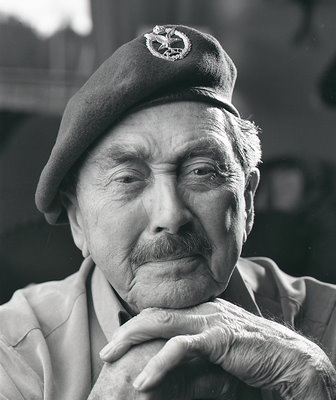
On the early hours of June 6, 1944 (0007 minutes after the invasion of Normandy had started) Staff Sargeant James Wallwork (left), glider pilot, cast off his Horsa glider from the Halifax bomber that was towing him. At that instant, the invasion had really begun. There were 156,000 men prepared to go into France that day, by air and by sea, British, Canadian and American, organized into some 12,000 companies. D Company's 160 men under the commmand of Major John Howard in 6 gliders (Number 1 was Wallwork's) led the way. It was the only company attacking as a completely independent unit. When Wallwork cast off, D Company was alone.
At 0016 Wallwork's No 1 (Irene) landed (a controlled crash) very near the Bénouville Bridge(later renamed, most famously, the Pegasus) on the Caen Canal. The crash sent Wallwork and his co-pilot, Staff Sargeant Ainsworth out of the cockpit, through the perspex canopy and into the ground. Wallwork was the first allied soldier on occupied French soil.
This magnificent performance and that of the other 5 Horsa gliders was praised by Air Vice Marshal Leigh-Mallory, commanding the Allied air forces on D-Day, as the greatest feat of flying of World War II.
I remembered the above when Rosemary and I enjoyed a Vancouver East Cultural Centre double bill last night in one of its unofficial sites (in this case The Firehall Arts Centre) while the new Cultch is being finished. The double bill with its military theme, one specifically about the Normandy landings featured Julia Mackey in her play Jake's Gift directed by Dirk Van Stralen. One would have needed to be Charlie McCarthy to not have been affected by Mackey's performance as little French girl who tends the graves of Canadian soldiers who died in the Juno Beach (the Canadians) part of the Normandy invasion. Mackey also plays her grandmother and Jake. Jake is a crusty old veteran who finally makes it to France after 60 years with the purpose of looking for his elder brother's grave. Jake's Gift made me laugh and if had been a little bit less of a Charlie McCarthy I might have cried, too.
The folks at the Vancouver East Cultural Centre have taken an interesting (in my opinion) plunge in attempting to bring several art forms together under one roof. I go to dance, opera, symphony, baroque concerts and theatre. When I go to ballet I never see the crowd that attends modern dance. At the opera I rarely see the folks that cater to Vivaldi and Pandolfi. The scene is fractured.
But last night and until November 16, the double bill includes Jake's Gift and a collaboration by choreographer Jennifer Mascall and modern dancer Ron Stewart called WhaT,?. The latter is dance with the spoken word and video projections. Is it only dance? It is more.
In the past there have been attempts in Vancouver to add the spoken word to dance. In 1998 John Alleyne lauched his The Goldberg and received lots of criticism for the heavy burden of the narrative side of his ballet. I thought the work was beautiful and I did not care that the Ballet BC dancers could not project the voice of CBC radio announcers. If those same Ballet BC dancers tried to find work at the CBC today they would be rejected for not having speech impediments and or lisps. I don't mind when dancers talk.
Ron Stewart, an extremly fit and flexible redhead with a face that could make you lose all your clothes if you ever tried to play strip poker with him, danced four or five rolls. They featured himself and a man that was part his father and the partrooper father of choreographer Jennifer Mascall.
Having seen many Mascall productions I can ascertain here that they will test your mettle and you cannot sit back and relax. There is a lot of stuff thrown at you that is full of intelligence. Just as a José Saramago novel, you have to read one first for the rest to gradually become that much easier to understand, not that you need to understand modern dance at all to enjoy it. Watching Stewart dance is pleasure enough.
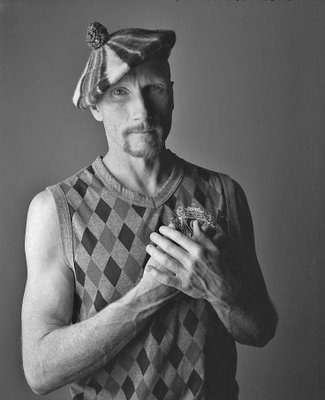
Julia Mackey's rapid fire transformation from one character to another with all the accompanying ticks was a tour de force to watch. In the case of Ron Stewart the long moments of silence as he takes his clothes off (a warning!) or puts them on was almost like watching a not so silent reverse strip. If Julia Mackey's tender story had serious moments the funny moments in Stewart's performance are a lot more serious and personal.
I had no new picture of Ron Stewart so I asked him to oblige me and come to my studio to pose for this blog. Since I am going with my granddaugther Rebecca to see the double bill tomorrow I wanted Stewart to bring the Scotish regalia he wears in parts of WhaT,! . The connection is that both Ron and my Rebecca are surnamed Stewart. I asked why the work is called What,? (that comma is part of the title). It seems that people when seeing this show would simply say, "What's..."
Just a few minutes before I sat down to write this I called James Wallwork at his home in Ladner. He is doing just fine and was wondering when he and his wife Genevieve could visit for tea. Wallwerk is 89. I told him how proud I was and how I remembered him last night when I was watching Jake's Gift and how I wanted to shout, "I know the man who was the first man to hit Normandy, head first through the windshield of his glider plane!"
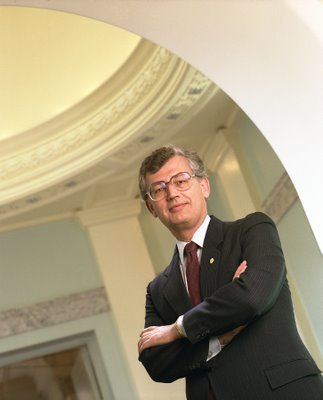
A long time ago I was waiting to photograph Bob Hope at a film location on West Broadway (Don Ameche was also my subject that day) when I noticed that Hope granted journalists 15 and 20 minute interviews but invited my journalist friend John Lekich to have lunch with him in his trailer. I asked Lekich about this and he told me that actors and directors had to face media so often that they made value judgments based on experience and generally gave you about 1 minute to make your case. In that minute actor and directors decide if they will open up and grant you a good interview or not. In brief even if an actor may not be too swift, experience compensates. It helps them avoid uncomfortable situations or time wasting.
I use Lekich's argument to press my case that photographers, long considered to be stupid, and in spite of it all, we do perceive stuff simply because of experience.

In Argentina we all know that the next rank for a four-star general is Presidente de La Nación. That rank can be obtained through elections but most often it has happened with a "golpe de estado". In Mexico any Mexican will tell you that only stupid and dishonest people would become politicians, "Anybody smart enough, would know better." Few Harvard graduates make it as politicians in Mexico except (and who knows why?) the exceptions have been economists working for both the Argentine and Mexican governments.
In 1975 Rosemary pressed for us to leave Mexico and move to Vancouver. She thought that Canada would be the right place for our growing daughters. In most cases she was right. In fact Rosemary has been right about everything.
There is one particular incident that makes me glory at the fact that I live in Canada and that all is well here.
Some years ago I was working under contract for Canadian Pacific Limited. The PR man Morrie Zeitlin called me one day and said, "Alex, Premier Vander Zalm is entertaining a friend who is mayor of a small town in Holland. The man is interested in trains so we are giving the Premier access to our rail yard. Meet them in front of the CP Train Station and take some pictures during the tour." At that time Vander Zalm was at his least popular. There were headlines about him every day.
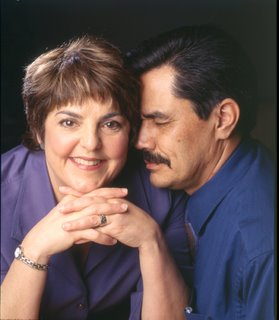
I waited. Then a Volvo stopped on the other side of the station and I saw the Premier in a smart black leather jacket get out with his friend. He put quarters into the parking meter (!) and crossed the street. He beamed at me with that smile and said, "Are you ready Alex?" There he was with no police escort. No Canadian equivalent of a secret service. There he was putting quarters in the parking meter. This is what Canadian democracy is all about. We are yet (touch wood) not ready to assassinate our politicians be they unpopular or not. Many years later I had the opportunity to talk plants (using botanical Greek and Latin) with Vander Zalm and I came to realize that he really was, behind that grin, not too bad. Like all humans he had his tragic flaw. But I could sense the humanity in him.
Sensing a humanity in people is something that I have come to feel when they face my camera and I face them. I have been reading about the shenanigans at City Hall with a small measure of distaste. The fact that I live in Canada does not mean that politicians should be any more honest than they were or are in Argentina or Mexico. I have come to accept that. But it still shocks me. Were I Editor-In-Chief of the Vancouver Sun (Patricia Graham) I would assign David Baines to investigate this affair. My feeling is that Baines would probably not want to soil his excellent reputation of impartiality and honesty by delving into politics. That is a shame.
In my years of taking pictures of politicians for magazines, for political parties and for politicians themselves I have kept my humanity feeler open and here are four that have rewarded me with a feeling that I can trust them and that they will do the best for their city, province or country.
The first one was for a short time the Provincial Leader of the New Democratic Party. He was Bob Skelly. He was a handsome man who wore exquisite shark skin suits and had eyes that reflected honesty and intelligence. Unfortunately I also sense a lack of fire. It was almost as if that lack of passion was caused by a sense of tragedy. I believe this is why Skelly lost in the end. I believe that had he won, that sad streak in the man would have somehow improved us all.
I first met Mike Harcourt when our City Conselors were called Aldermen. In all my many photographic contacts with him and until a most recent one of taking personal pictures for him I had that constant sense of humanity and honesty.
I get the same feelings from Provincial NDP leader Carole James. As a matter of fact when I photograph politicians I am thinking, "Would I buy a used car from him, from her?" I am sure that James would do well even at a used car lot.
-701569.jpg)
The first time I photographed Dawn Black, right, (in the middle 90s) she lost her political bid for MP in her riding for the NDP. I felt a bit ashamed of myself as I thought I was on a lucky streak since so many of the politicians I had photographed had won. I considered that in some way I had contributed a little bit. Dawn Black finally did make it and this time around she won by a smal margin a bid to unseat her from New Westminster-Coquitlam. I do hope that my latest portraits of her may have helped to re-elect her.
We Canadians deserve (but don't always get) people like her and the other three here.

You lie awake in the middle of the night with a stressed-induced insomnia and you have a good idea. This happens to me frequently. Seconds after the idea creeps into my consciousness sleep overtakes me and the idea slips away. Sometimes I resist, I get up and write down the idea or if it has to do with a photograph I go to my files in the basement and pull the one remembered out of the cabinet. And so it happened tonight. Just in case the idea wasn't that original I looked it up in my blog search engine. Alas! I had written on the subject of yielding flesh here. With insomnia still with me I decided to stick with the idea even if it is a second time around.
Twenty four years later after I called up Joanne Dahl, left, (Why not, after all I am a photographer!) and asked her what was erotic I can still feel the shock of her unexpected answer, "Yielding flesh." Shortly after, I took some photographs of Lalita who would have made Alfred Eisenstaedt make a double take (Eisenstaedt discovered Sophia Loren) and tried to apply Dahl's idea on what was erotic. I came up with this shot and when I told her boss, Tony Ricci that I had photographed Lalita's feet and had taken pictures of her pressing on her arm with her fingers he looked at me in disbelief as if I had been trying to sell him the Brooklyn Bridge cheap.

Twenty four years later the shock of that unexpected answer from Dahl is still with me but much diminished. I don't think about the erotic all that much. Perhaps I don't need to ask. Could it be that I know the answer? Not likely. More likely the question does not have much relevance to my life and death is much more exciting.
For yet another take on yielding flesh read the latter part of this.
Death is a cure for all diseases.
Sir Thomas Browne, 1605-1682

Death has been in my mind in the last couple of weeks. First I read Julian Barnes's
nothing to be frightened of and last night I finished Reginald Hill's A Cure for All Diseases. The previous Hill novel also featuring Detective Superintendent Andy Dalziel was called Death Comes for the Fat Man. I have a friend who is rapidly divesting himself of his posessions and wants to be able to die with as little as he came into this world 86 years ago - nothing.
I was shocked then to open my Vancouver Sun this morning and see Paul St. Pierre's essay A Voice from the Grave's Edge. It is a rant but I considered a few things before I would dismiss it. And of course I didn't dismiss it. I had met Paul St. Pierre in November 1993 when I photographed him for an article in the Globe & Mail. St. Pierre had come to my house for his portrait session. We talked about our fondness for Mexico and our admiration for the Mexican concept of death - they live with death and don't avoid it. So I photographed St. Pierre (above, left) with a Mexican pottery version of the Last Supper.
Paul St. Pierre is 86-years old and obviously somebody in the Vancouver Sun wrote the headline for his piece for some reason. I sent an email to Malcolm Parry to see if he could confirm one way or another St. Pierre's situation. Mac's answer was typical:
I took him at his word. Mac
I hope the folks at the Vancouver Sun will forgive me for putting here the whole essay. I know that if I link it the link will disappear after a few weeks or months. Here is Paul St. Pierre's essay. If we are not to forget that the man is 86 and that at one time we showed a large measure of respect to those older than we are, you just might understand that there is some good sense under the obvious rant. Bless him.
A voice from the grave's edge
Paul St. Pierre
Special to the Sun
Monday, November 10, 2008
As life's end nears, two unpaid debts remain to trouble me. One is to my mother, who is not here to be paid, and the other is to my native land, which provided me a good life.
This is a payment, at least a token payment, to my country.
Few will read all this and fewer will heed. When Dwight D. Eisenhower left office he warned the Americans about the sinister power of the military-industrial complex. Had he been heeded, millions of lives would have been saved or made better, but nobody paid much attention. He was just an old president pegging out. Why listen?
So why should you listen to an old man on the way out, who can only claim to have been a fair newspaperman, a so-so politician, a Western-only novelist and a man no better than average as a wing shot? That's all right. This is not written for a lot of people but for those who are, at this moment, few. If this message reaches only one in 10,000 readers it was worth it.
Listen, I speak to you in the head, peoples.
Our Canada is now very close to a condition in which everything that is not compulsory is forbidden. We have become prisoners of the state. Like modern jail prisoners, all our needs for balanced diet, climate-controlled shelter, approved and tested medication, mental health counselling, higher education, suitable entertainment, grief counselling and consensual safe sex are available free. The inmate lacks only freedom itself.
When I was young, Canadians were born almost free; now we are born in manacles of silk and gold.
To the recent generations, this is hyperbole. I understand that. I also understand that young people cannot be expected to miss freedom. How can you miss what you never had? But a few of the old may remember and a few of the young might feel the tug of curiosity. I hope so.
Scarcely a day passes when our rulers do not devise some new law or regulation having the force of law, complete with fines and prison penalties. No one knows how many there are. Even the rulers couldn't find the number when they tried a few years ago. Suffice to say there are enough that everyone is a criminal now.
Here and there a free voice rings out. The Law Reform Commission of Canada quoted, in its first report, the old Roman senator, Cato: "The more the laws, the more the criminals." Even half a century ago, the commission recognized that there were already so many laws that nobody could know more than a few of them and that whether or not you are hauled into court to answer for a crime is not so much a matter of justice but a bureaucratic decision as to whether it seems productive to prosecute.
Among recent decisions we have accepted:
1. Our Supreme Court, repeating George Orwell, ruled that although all Canadians are equal before the law, some are more equal than others.
2. Thought Police arrived. They invent the crime which they investigate, invent the trial procedures and invent the penalties. Careers and lives have been ruined. Many more will be. Who now remembers that extraordinary woman, Queen Elizabeth I, who said it was not the business of the state to "pry into men's souls."
3. In the past 20 years we began a changeover from the British system of justice, in which every man is innocent until proven guilty, to the continental European system, often called the Napoleonic Code, in which the state obliges the citizen to prove innocence of anything the state may choose to suspect. A sample: If you have $10,001 in your pocket our rulers may simply take it and you will never get it back unless and until you prove you obtained it in a way the rulers consider suitable. In 2001 we got a gun control law under which citizens can be obliged to give evidence not only against their own family but also against themselves. Nobody seemed to much care. In Britain an ASBO (Anti-Social Behaviour Order) may commit some pranksome juvenile to prison, even though old British Common Law could not. In the United States you can be put in a cage for five or six years and never allowed to see a lawyer or learn what the charge against you is.
4. By the beginning of this millennium the shape of things to come was clear for those many Canadians, almost all of us, indeed, whose ancestors fled the Old World seeking freedom. Arbitrary rule, Star Chamber courts, class distinction, the creation of a courtier class who have almost exclusive access to the ears of the rulers, and finally the deadly dreary cult of political correctness.
5. Already ordinary people have learned to watch their tongues. This piece would be far more open and more honest were it not for the fear that some Oldspeak or Badthink would prevent it ever being printed. We are all individuals but because of our very individualism, we have permitted tyranny. Individualism does not nourish quick or concerted actions. We individuals drifted lazily into tyranny, accepting the view that the common people can never behave decently unless controlled by carrots and whips. James Madison, a framer of the U.S. Constitution, foresaw it. Americans, he said, could be depended upon to reject a tyrant who came against them bloody sword in hand, but they might surrender freedoms, one by one, to people who assured them it was for their own good. That is exactly what happened, in the United States as in Canada. The Americans try to disguise their wretched state of submission to the rulers by hooting and shrieking the word freedom, tossing firecrackers around and, most recently -- the supreme irony -- calling unconstitutional and oppressive legislation The Patriot Act. An American must bullshit. His health demands it. If he cannot bullshit a foreigner he will bullshit himself, but he has to do it.
6. There is worse. Americans now have revived practices of the Spanish Inquisition and permit their police to torture suspects to obtain appropriate "confessions." Where Americans lead, Canadians usually follow. Statism and totalitarianism, which we spent so much blood and money to fight in the Second World War and the Cold War, rise everywhere. They will keep rising until the private, secret impulse to freedom among individual men and women becomes a working majority. It will. First this majority will be silent and almost invisible. Then, overnight it will seem, it will emerge as a tempest which will sweep most of what we know today into history's garbage can, both the good and the bad. Blood will run.
Is there nothing we can do?
Of course there is, otherwise why waste this space?
1. Put no faith in any major political party. The allegedly profound philosophic differences among big parties are either trivial or imaginary. By their very nature big parties, like big newspapers, cannot lead, they can only follow what they judge to be public taste.
2. Act within small groups. You may be effective as a member of your local school board or Gladiola Society. You are unlikely to have an even detectable impact on a big political party as a voter or on a big company as an employee.
3. Soon we shall be permitted to walk around in our Canada only by carrying internal passports, a more elaborate document than the driver's licence which at present serves for control of the proletariat. What can one do? There is an answer. When internal passports become law, do as terrorists and gangsters do -- obtain more than one workable identity.
4. Try to increase the readership of George Orwell's Nineteen Eighty-four and Animal Farm, and J.B. Priestley's Brave New World and Brave New World Revisited. If it did not violate a basic principle, I would urge these books be compulsory reading in our schools. Those were the most prescient writers of the 20th century.
5. Never forget this: Any government may lie, cheat, murder and steal, for "the public good."
6. Remember Canada is small and remember also that a big world power can never be a true friend of a small power. Read Tito.
7. Although family is a diminishing force and may continue to fade, it remains the best social organism ever known to mankind. Sacrifice for it.
8. Without losing too much sleep, join the underground economy.
9. Fight for the Internet. It may be our last, best hope. Oppose, evade or sabotage every state attempt to control it, yes, even at the cost of permitting such obvious social evils as racial bigotry or child pornography. It is the common man's strongest available instrument and will be the target of sophisticated attacks by all rulers.
10. Support the Canadian Civil Liberties Union. Future generations will see it as a lonely champion of liberty during long, dark years. When it supports a cause that you find obnoxious, trivial or dangerous, increase your donation.
11. Above all, beware of priests, particularly those persuasive ones in the evangelist movement who claim they are not priests. And if you think allegiance to one true God will solve everything, look at Northern Ireland and the Middle East and think again. Seek a world in which religion, like sex, is completely free but practised only in private. You may find it necessary to speak with the many but you can think with the few.
12. Never despair. Keep the faith. Despite Big Brother's awesome and growing power, in the still, dark and secret places of the soul, ordinary men and women retain hopes, dreams and high ethics. Out of that fathomless, still pool of the soul, freedom will emerge again, some day.
Paul St. Pierre is a former Vancouver Sun columnist and member of Parliament who lives in Fort Langley and Mexico.
© The Vancouver Sun 2008

death
more death
even more death
and even more death
I didn't think it was my prerogative to point out that Brave New World was not written by J.B. Priestly. In letters to the editor, the next day in the Vancouver Sun, this was pointed out by a reader.
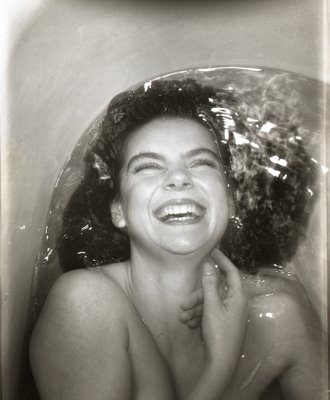
Name: Sarina de Lange
Comments: Alex, I visited the library today and came across a photograph from your 1990 'Women in Tubs' show in Vancouver. Twenty years ago, I was one of the 'women'. I strongly regret that I missed the gallery opening of 'Women in Tubs' and having never seen the image you presented of me to Vancouver. Now, many years and three children later, I am curious to see myself from the vantage point of the viewer over my tub. If you have the stills or copies of your work from this period, is there any way I may see the image you chose of me?
Anticipating your response,
I thank you for your time,
Sarina.
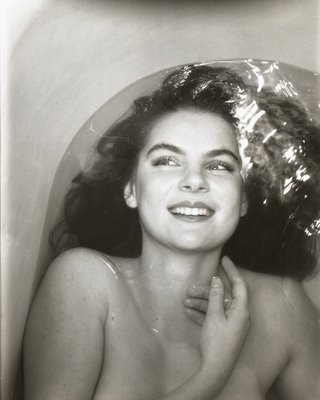
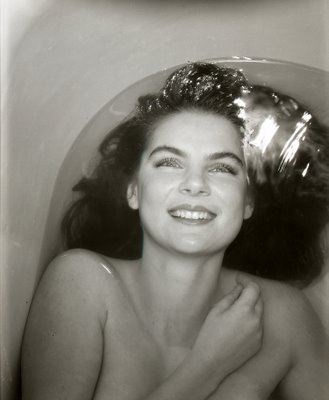
Dear Sarina Catharine,
I have good news for you. Not only do I have the picture that originally appeared in the show but a copy (16x20) which was to be yours and can still be yours if we manage to find a way of getting it to you.
Twenty years ago I was afraid to show outright nudity so I was careful not to show any breasts in any of my pictures. There are some lovely ones of you which I never used. I used the same reasoning for all the rest of my subjects and I remember hearing someone at the show complain that I had not pulled back my camera enough to show "anything".
For some unknown reason I picked a picture of you (left) that shows you at your most whimsical and with your lovely smile. Perhaps I chose right even though I find the laughing one funny and in the second one your hand is more graceful. Photographers go through periods that are dark and then light. Periods when we print with high contrast and periods when we choose to use softer contrast. At the time I printed all the tub shots really dark. Yours was dark, too.
The paper I used was a terrible (hard to use) Kodak fiber based paper that I processed archivally. This means that your copy will be inherited by your grandchildren if you frame it properly.
I also remember at the time the paradox (since they were pictures taken in the water) that all my negatives had water stains that would not disappear with repeated washings. In the end I found out that the wetting agent (Edwal LFN) that I had used had gone through a chemical change and the very problem a wetting agent was supposed to remove, this particular one was adding to it. And your negative was one of the worst. I remember washing it and washing it!
I associate you with Chandler who worked with you at that excellent E-6 (Ektachrome) lab called Quad. I have not seen Chandler nor have I heard about him in a very long time. He used to appear at some of my shows. I always admired his sensitivity to art and his good taste.
From your phone I guess you live somewhere in Alberta. One of the tub women lives there and she is the one that perhaps you saw in the library in the back cover of the Reader's Digest. It would have been a picture of her with her baby son.
Tell me what would be the best way of getting the picture to you. Perhaps you have friends who are coming to Vancouver. I would reluctantly roll it into a tube.
Sincerely yours,
Alex
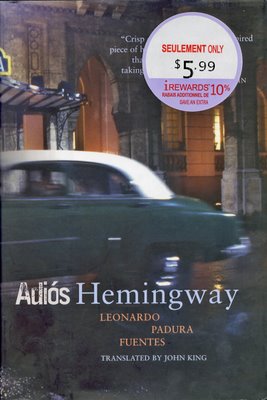
On February 1, 1946, my own Season of gold began as I, Frank Bullinger, Jr. arrived at the front door of La Finca Vigía, expecting to be Hemingway’s only guest, clutching in both hands the manuscript of my novel. Suddenly, several charming famous men with guns plus two wary-looking women, also with guns, came bounding down the front steps, drunk and dressed in peacoats and flannel, leather patches in the right places. Me, I wasn’t drunk, struggled to be charming, and never would become famous. I was a slight man, drenched from the storm that hit the Cuba Line on my way from Miami, dressed in a blus sport coat and a tie I’d gotten for Father’s Day. Gene Tunney brushed past me, portrait of the working-class hero turned patrician millionaire. Babe Ruth patted me on the head and said “Hiya, kid.”
The Veracruz Blues, Mark Winegardner, Viking 1996
This talk of the Veracruzanos reminds me of a famous Mexican joke. A woman comes into a produce market and asks to buy half a melon. We don’t sell that way, says the clerk. You must buy the whole melon. I don’t want the whole melon, the woman says. She gets more obstreperous about the matter and finally the clerk reluctantly agrees to go speak to the owner.
“Can you believe it?” he says to the owner in the back office. “A cheap hag bitch wants to buy half a melon.” The clerk sees alarm in the owner’s eyes and turns around. The woman is right behind him. “And this charming lady,” he quickly says, “wishes to buy the other half.”
The sale is consummated, the woman happily carts away her half melon, and the owner impressed by the young clerk’s quick mind, mentions that he is opening a new produce market in Veracruz. Someone so sharp-witted might be just the person to manage that market, no?
But the clerk is aghast. “Veracruz!” he says. “What a hellhole! There’s nothing in Veracruz but whores and ballplayers.” The owner frowns; he is furious. “I’ll have you know that my dear wife comes from Veracruz.” “Is that so?” says the clerk, not missing a beat. “Does she bat right-handed or left? “
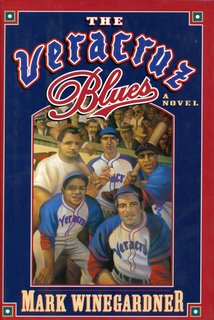
All you wish to know about Mexico, Frank, about our masks, our sense of humor, and the weaponry of our wits, about the way Mexican men see Mexican women, about the Mexican League and my poor dead Jorge, is all contained in that joke.
The Veracruz Blues, Mark Winegardner, Viking 1996
When I first read Mark Winegardner’s lovely novel The Veracruz Blues which is a story of the so-called raid on Major League Baseball by the Mexican League in 1946 I became homesick to my own experience in having discovered baseball, a sport I was ignorant about since I had arrived to Mexico from a soccer-crazed Buenos Aires in 1952. A few years later my cousin Robby took me to see a game between the Mexico City Diablos Rojos and the Tigres. I found the experience so exhilarating that I went to other games including ones with the Águila de Veracruz, formerly the Veracruz Blues of Winegardner’s novel.
Many years later between 1965 and 1967 when my mother was living in Veracruz I went to see the Águila play in Veracruz in a stadium where I could smell the humid salt air of the port. Since I had lived in Mexico City’s thin air for so many years the sound of the cracking bats at sea level were a new and wonderful experience.
In Veracruz Blues I became curious about all the truth and lore of Hemingway’s Cuban period. I read of his fondness for drinking at La Floridita and of his life at his Havana house, la Finca Vigía.
It was in Paco Ignacio Taibo II’s Retornamos Como Sombras (We Return as Shadows, but to my knowledge this novel has never been translated into English) that I first disocovered that Hemingway had volunteered in 1942 to look for marauding German submarines in his yacht El Pilar. What was true and what was false in Taibo’s plot.?

1941. While Mexico is about to declare war on Germany, Hitler is injecting himself with Mexican caffeine and becomes addicted to peyote to resist the pressures of the Eastern Front. In the middle of the Chiapanecan forest (in Mexico) a group of brown-shirted Germans march to the tune of an old gramophone and is accosted by a persistent youth who wants to do them in. A poet, recruited as a spy, discovers that the Mexican Minister of the Interior has a lover who works for the Abwehr IV. A few German submarines cruise the Mexican coastline for a place where a final push to attack the American giant could be unleashed. Hemingway in one more of his alcoholic/literary crisis falls asleep in a Havana swimming pool and re-appears with no explanation in Mexico City.
The great Mexican actress María Felix is a protagonist in both Winegardner’s and Taibo’s novel. While I had known that Felix had been the mistress of Mexican president Miguel Alemán I had been unaware of Felix’s affairs with both Diego Rivera and Frida Kahlo. I discovered this in Taibo’s account.
Only recently I finished a delightful novel translated from the Spanish written by Cuban writer Leonardo Padura Fuentes. This ingenious murder mystery has Hemingway as a protagonist and the novel shifts back and forth when a body is found buried in Hemingway's La Finca Vigía which is now a lovingly restored museum in Havana. The investigator of the murder (the body is from Hemingway's period and an FBI badge is found nearby) is a retired policeman who is attempting to be a writer and finds Hemingway as inspiration having seen him at a dock by his yacht as a boy. The book is lovely even translated into English and the famous swimming pool of Taibo's novels here plays an important part, too. Our investigator falls asleep on Hemingway's bed and has a stupendous wet dream! The dream has all to do with a pair of black lace nickers that are introduced here where the caretaker/curator of Hemingway's villa asks Conde, the investigator if he had been at the finca before.
'But you didn't see the weapons.'
'No. They're in the tower, aren't they?'
'Yes. And I bet you didn't see Ava Gardener's knickers, either."
Conde felt a pang.
'Whose knickers?'
'Ava Gardner's.'
"You sure about them?'
'Couldn't be surer.'
'No I didn't see them. But I've got to see them. The nearest thing to seeing a woman naked is seeing her underwear. I must see them. What color are they?'
'Black, with lace. Hemingway used them to wrap around his .22 revolver."
And the dream begins like this:
He saw her when she was already on the edge of the swimming-pool. She was wearing a fresh flowery bath-robe and her hair was loose, falling around her shoulders. He thought her hair seemed lighter than he remembered and he once more enjoyed the perfect beauty of her face. She said something he couldn't hear or didn't understand, perhaps on account of the noise that his own arms were making in the water. He moved them so as not to sink, and they felt heavy and almost not part of him. Then she took off her bathrobe. She wasn't wearing a swimsuit underneath, just a bra and pair of knickers, black ones, made of revealing lace. The cups of the bra were provocative and he could see, through the lace, the pink aureole of her nipples.
The above passage proceeds in the kind of stuff that I used to read by sneaking into my mother's Frank G Slaughter novels which had passages the taught me what sex was all about in that distant pre-internet era of my youth.
Such was my pleasure in reading Adiós Hemingway that I proceded to Sophia Books to see if they had anything else by Leonardo Padura Fuentes and preferably in Spanish. They did. It was a new edition of Padura Fuentes's first novel Fiebre de Caballos (Horse Fever, but again not translated into English. This is about a boy (a baseball prodigy, too) in his late teens who has yet to have his first introduction to sex. Because it happens with an older woman the novel is like the film The Graduate set in a Fidel Castro envirionment of his revolutionary Cuba.
Of baseball Leonardo Pardura Fuentes says:
I am a typical Cuban of my generation. I was born in ‘55, so I’ve passed my whole conscious lifetime under the system of the Revolution. I was born and grew up (and still live) in a working-class neighborhood on the outskirts of Havana, where I lived with great freedom, dedicating the majority of my time to that which is still my greatest passion: baseball. Since I’m a lefthander, I played first base and outfield, but I didn’t have enough strength at bat to be a good hitter. And for that reason, when I finished high school I decided to study liberal arts at the University, and shortly thereafter, I figured that if I would not be a baseball player, I would be a writer...But even now, when I see a good game of baseball I think that I would have liked even better to be a great baseball player like el Duque Hernandez, for example: a man whom I admire for his passion and discipline, which in some way resemble what I have when I create literature.

The circle of baseball, Hemingway, Cuba, Maria Felix, Ava Gardener's knickers, German submarines closes around one of my favourite authors, the not too well known American Jerome Charyn. Charyn writes about baseball in his novels, in particular of the New York Giants and the Brooklyn Dodgers. But the circle really closes here because Padura Fuentes cites Jerome Charyn and Alejo Carpentier as two of his favourite authors. Some years ago when I interviewed Paco Ignacio Taibo II I had yet to find the connection between Alejo Carpentier and Taibo's abrupt finish to our interview and Beethoven's Ninth Symphony!

Tonight Rebecca and I had a feast at Opera Sushi and watched the end of La Traviata on a TV monitor from Convent Garden directed by Sir Georg Solti and sung by Frank Lopardo and Angela Gheorghiu. We picked up our tickets for Cyrano de Bergerac at the Stanley. We were early so we went to a nearby Starbucks. Rebecca had a large cookie which she did not finish. As we entered the Stanley the woman at the door indicated we could not enter with outside food. I convinced her that my 11-year-old granddaughter was going to rapidly finish it inside.
Another woman made the couple who were sitting by our side leave. They were munching on what looked like excellent ham and sprout sandwiches. I explained to Rebecca that running a theatre company is expensive and that the in-house bar could not make ends meet if people brought in food and drink.
I asked the floor manager if we could visit Carmen Aguirre, backstage, after the end of the play. "My granddaughter has a wish to see what it's like back stage," I told him. He answered unequivically that this was impossible and that we should wait at the lobby. This we did. Carmen Aguirre came out and greeted us. Rebecca told her how she had enjoyed the play.
As we left Rebecca said, "Isn't she pretty? Tell me again about Carmen and Isabel Allende and how you asked her to close her eyes when you photographed her with Isabel Allende"

In spite of the cookie police and in spite of a man who simply could not understand how wonderful it would have been for a young girl (the only one there tonight) to meet, backstage, a nun and a man with a long nose, Rebecca told me, "I love the theatre."
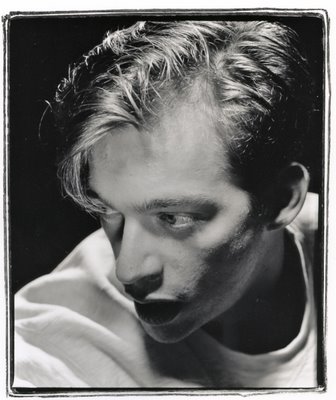
It was October 23, 1990. CBS Records was being taken over by Sony Music. Dave Chesney, the local CBS record rep, had been instructed to find a photographer to record Harry Connick Jr's concert the next day at the Orpheum (a somewhat smaller show than the GM Place performace slated for Fiday night) for Tokyo journalists working on a story on the new Sony star. Fumiko, the Sony representative, was surprised when Dave and I showed up at the Century Plaza Hotel to meet the Japanese Sony delegation. She was concerned that I wasn't Japanese. "Is there anything I can do for you for the trouble?" she asked.
I didn't get the job, but Chesney was still keen to have a photo of Harry to accompany one I had taken of Leonard Cohen that graced the CBS office he was soon to depart.
At 11 a.m. next morning, we knocked on the door of Harry's room at the Georgian Court Hotel. He was being interviewed by a journalist with the help of a translator. The Japanese photographer who had been flown in from Los Angeles, was taking snaps with his motor-driven Nikon. As soon as I unpacked the lights and set up the medium-format camera on a heavy tripod, the journalist and the photographer made a quick and apologetic exit. We were alone with Harry.
Unshaven, he looked uncomfortable. To break the ice I asked Harry if he would ever record my favourite jazz standard, Billy Strayhorn's Lush Life. "That's a woman's song. I don't think I'll tackle it yet." Now smiling and relaxed, however, he added, "I'm ready."

As I write this it is almost 6PM. In an hour Rosemary and I will be at the Helen and Morris Belkin Gallery at the University of British Columbia. We have been invited to the presentation of the establishment of the Alvin Balkind Awards for Creative Curatorship In British Columbia Arts. The award has been funded by Abraham Jedidiah Rogatnick and the first recipients are Scott Watson (curator of the Belkin Gallery) and the Faculty of Arts of the University of British Columbia.
I knew I had at least one photograph of the gallery. It is my favourite view of it even though it is the rear view. I took the picture and many others at UBC for an April article for the Georgia Straight on the new architecture at UBC. The article was written by Sean Rossiter. Rossiter's interests have shifted a bit towards aviation and the Straight, after the editorship of Charles Campbell, seems to have lost interest in architecture. I no longer take this sort of picture and with no Rossiter articles on our city architecture we are all that much poorer.

I cannot recall exactly where I took the second photograph. It is not of the Belkin Gallery but it is my favourite picture of all the ones I took that April 1997 at UBC.
This blog is my little tribute to architect Abraham Rogatnick for his generosity towards UBC.
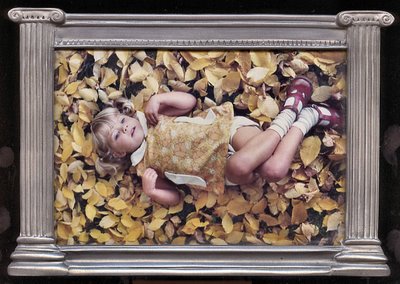
While watching the US elections on CNN tonight I told Rosemary, "I have to write and post today's blog! What am I going to do?"
Looking up at the mantle in our TV room (formerly the smoking room) I spotted the picture of Hilary that I took in Vancouver a year after we arrived in 1975. It was fall of 1976 and we had gone to the UBC campus not far from Nitobe Garden. After many years of having lived in Mexico (a rainy season and a dry season) I was not prepared, nor have I ever gotten used to the surprise and beauty of four distinct seasons. Since that 1976, every fall in Vancouver has been a fall to savour and enjoy.
This year in particular when I made a call to the Cooks a few days ago, Barbara said, "Isn't this particular autumn glorious? All the right things that could occur to make leaves get more colour have happened." Barbara was nicely recovering from a broken jaw (quite a problem if you are over 80) and her lovely New Zealand accent was back exactly as I remembered.
And Monday night when Hilary sat at our table and said, "I am going to be 38 in December," I could not believe that so many years had passed. It seemed that it was not too long ago that I posed her with her little red shoes and she volunteered to cross her legs so cutely.
My mother often told me that I would never understand the love of a mother for her son because I would never be a mother. She repeated this so often that I began to feel like I would never achieve a completion of who I was because a segment, called maternal love, would always be empty. She explained that a mother's love was automatic and it did not depend on a mother particularly liking her son. As a matter of fact I was 21 when she confessed to me that she had always loved me as her son but had felt no particular fondness for me. "I did not like you. You were not the kind of son a mother would like." My shock at listening to this was tempered when she added, "But you have somehow changed and I can assert that I now like you."
With my mother gone I cannot contribute to our conversation. She had a daughter, my sister, that was born dead so she never had any idea what it was to have a daughter. I have two daughters. But she did have a little glimpse when she attempted to educate our headstrong daughter Ale when Ale was 4. My mother did live long enough to hold Hilary in her arms. Before she met Ale, my mother had been living in North Carolina. She understood the pleasure of dressing up a little girl. She sent us a little dress for Ale that she had purchased at Marshall Field's. For the two years that she lived with us she dressed up Ale in the morning. My mother and I never shared this enjoyment. Rosemary and I were too busy making ends meet.
Now as I look at that picture of Hilary at UBC in her bed of fall leaves I have a feeling that I would want to share with my departed mother, "Mother you will never understand what it is to be a father and to love a daughter. You will never be a father."
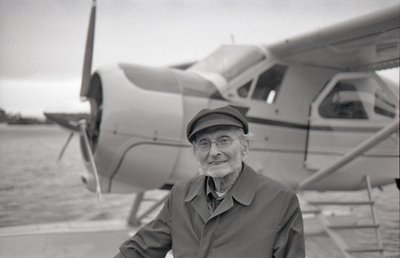
Yesterday I woke up at 5AM and felt terrible. I had slept very little. Yesterday was a perfect day.
Abraham Rogatnick picked me up in a cab at 6:10AM and we went to the Vancouver Airport Seaplane Terminal. It was pouring. Abraham is no different to me. This meant that we arrived one hour before our Seair DeHavilland Beaver would take us on our 20 minute flight to Pender Island.
We were going to visit Abraham's friend of 50 years, Karl Stittgen and his wife Nora. Stitgen was a renowned Vancouver jeweler for many years. Before he retired he was already dabbling with architecture. Stittgen's hero is architect Frank Lloyd Wright and the house he designed and built on Pender Island is a church to wright. It is as if Wright somehow alive, designed and built the house. Everything about the house (and a new guest house), the furniture, the lamps and even some of the dishware pay homage to the great American architect. In Stittgen's library there is an extensive collections of books and magazines on the man.
We were greated at the door by Stittgen and his dog Miho (Nora had picked us up at the dock). I simply did not know where to rest my eyes as everything was a delight. Stittgen the jeweler is now a potter and an amateur (in the 19th century English meaning of the word) architect. The kitchen from where I could smell the large and thin (just the way I like them) pancakes was as perfect as a kitchen could be. We were served breakfast and I had fresh strawberries and fried bananas with my pancakes.
The rest of the day was like that. Lunch was accompanied by a very sweet and light German wine from the area in Germany where Stittgen was born. By the time the Stittgens took us back to the dock at 4 I felt that the day had simply been too short. The sun had appeared as soon as we had arrived to Halcyon Days, the name of Stittgen's home. We explored the guest house, the potting shed and as soon as we had returned for lunch the sky opened up again. But not for long. The sun shone again at the dock and as we flew in our Beaver a setting sun waited for us as we skimmed and then landed, ever so placidly, on one of the Fraser River arms.

The perfection of the day was enhanced because of pleasant experience with Seair Seaplanes. The 1950 Beaver that took us to Pender Island had been refurbished and modernized a week before. The paint shone. I explained to Abraham who is an expert on his favourite city of Venice that flying in a Beaver over the waters of British Columbia did not in any way seem any less glorious than being on a gondola on the Grand Canal. Abraham had probably flown in a Beaver before but I explained all I had learned from Sean Rossiter about the Beaver. He suddenly had a new respect for our airplane and enjoyed his flight. Coming back our Beaver was not as pristine but it had some of the original and beautiful wood trim. Both pilots had read Sean Rossiter and were most impressed to find out that both of us were his friends.

The whole day reminded me of my experience taking still photographs for the CBC series Ritter's Cove.
Somehow, thanks to Abraham Rogatnick, Nora and Karl Stittgen (their dog Miho) and the beautiful DeHavilland Beavers, those treasured halcyon days of my past had come back, for one perfect day.
More Beavers
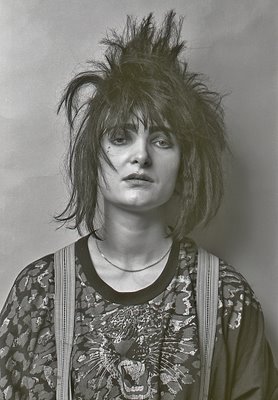
When Vancouver Magazine rock writer Les Wiseman and I met up with Siouxie Sioux at the Sandman Inn on a rainy, early October afternoon I did not have a clue who she was or what kind of music she sang with her band the Banshees. All I knew was that she was English and was avant garde. I had purchased her just released Juju and the music, particularly Spellbound pushed me into greater depression than my then favourite album for achieving the same feeling, Miles Davis' Kind Of Blue.
At the time I was in my sort of minimalist rock photography style. I took a roll of used seamless paper and I would masking-tape it to a hotel room wall. I had just discovered that by carefully using my Pentax 20mm wide angle I could make my pictures look almost as if I had not used such an extreme wide angle. The point of using the wide angle is that it forced me to get close (and intimate) to my subjects. Of the interview these words by Les Wiseman I have always remembered fondly:
"So how about all this mysticism and occult stuf on your new album [Juju]? I heard myself asking a few minutes after tuning on the tape recorder. Thus far the interview had been like trying to reach a mayonnaise lid that has slipped under the frige. Siouxie looked bayfully sweet in oversized trousers prevented from falling right off by a pair of old braces, and a blousy pullover shirt appliquéd with a snarling leopard, her hair a jet elfin hat skyrocketing from her skull. Travel-weary and over-interviewed, she lay propped up on the bed, drinking vodka and smoking like some Twilight Zone Garbo."

It is only recently that I have found out that Siouxsie was really one of the biggest influences on the goth movement. I went to her concert that evening and I was mesmerized by her singing as she droned and shifted from side to side while wearing the tiniest of mini skirts over a pair of beautiful legs in fishnets.
Or as Les Wiseman described it:
Then, bounding and writhing to center stage, Cleopatra-eyed, her hair freaked froth rising from a blur of body language stolen from a Haitian dervish, Siouxsie appears a gorgous vison of rock'n'roll energy in high leather boots, miniskirt and fishnet stockings. The ways that she moves make Mick Jagger and Peter Wolf look as though their shorts are starched with fiberglass. "Oh severed head/I'll feed your head with bread/and paint you lips bright red/I'll keep it fresh on ice/it will look very nice." She chants, incants, moans, shrieks, commands. "And don't forget/when your elders forget/to say their prayers/ take them by the legs/ and throw them down the stairs."

In 1994 I went to an airshow at the Whidbey Island Naval Air Station. It was then that I photographed the base commander Captain Shork next to the plane he had flown for years and I have loved as the most beautiful of all airplanes, the Intruder.
Two years later I returned and because I had photographed Captain Schork, the new base commander Captain Munns gave me access to locations that I would have never dreamed of. He told me that one of the best locations to photograph the Blue Angels was on the tarmac close to the two officers who ran the Blue Angels' show from the ground. He warned me that once there I would not be able to move. I also learned quickly that trying to keep a blue sky blue all the time while shifting my large Mamiya RB-67 equipped with a polarizer was next to impossible. But the whole show from my vantage viepoint on the tarmac was thrilling with the noise and smell of jet fuel.
Today was a gray day and as days shorter I find that November can push one into melancholy. The idea of posting pictures of a clear blue sky in a hot summer day had its appeal.









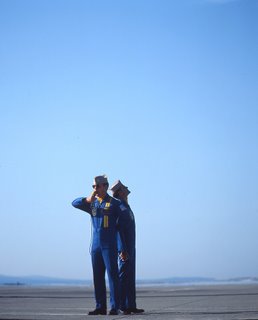


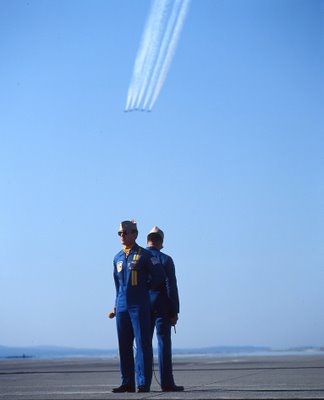

On the early hours of June 6, 1944 (0007 minutes after the invasion of Normandy had started) Staff Sargeant James Wallwork (left), glider pilot, cast off his Horsa glider from the Halifax bomber that was towing him. At that instant, the invasion had really begun. There were 156,000 men prepared to go into France that day, by air and by sea, British, Canadian and American, organized into some 12,000 companies. D Company's 160 men under the commmand of Major John Howard in 6 gliders (Number 1 was Wallwork's) led the way. It was the only company attacking as a completely independent unit. When Wallwork cast off, D Company was alone.
At 0016 Wallwork's No 1 (Irene) landed (a controlled crash) very near the Bénouville Bridge(later renamed, most famously, the Pegasus) on the Caen Canal. The crash sent Wallwork and his co-pilot, Staff Sargeant Ainsworth out of the cockpit, through the perspex canopy and into the ground. Wallwork was the first allied soldier on occupied French soil.
This magnificent performance and that of the other 5 Horsa gliders was praised by Air Vice Marshal Leigh-Mallory, commanding the Allied air forces on D-Day, as the greatest feat of flying of World War II.
I remembered the above when Rosemary and I enjoyed a Vancouver East Cultural Centre double bill last night in one of its unofficial sites (in this case The Firehall Arts Centre) while the new Cultch is being finished. The double bill with its military theme, one specifically about the Normandy landings featured Julia Mackey in her play Jake's Gift directed by Dirk Van Stralen. One would have needed to be Charlie McCarthy to not have been affected by Mackey's performance as little French girl who tends the graves of Canadian soldiers who died in the Juno Beach (the Canadians) part of the Normandy invasion. Mackey also plays her grandmother and Jake. Jake is a crusty old veteran who finally makes it to France after 60 years with the purpose of looking for his elder brother's grave. Jake's Gift made me laugh and if had been a little bit less of a Charlie McCarthy I might have cried, too.
The folks at the Vancouver East Cultural Centre have taken an interesting (in my opinion) plunge in attempting to bring several art forms together under one roof. I go to dance, opera, symphony, baroque concerts and theatre. When I go to ballet I never see the crowd that attends modern dance. At the opera I rarely see the folks that cater to Vivaldi and Pandolfi. The scene is fractured.
But last night and until November 16, the double bill includes Jake's Gift and a collaboration by choreographer Jennifer Mascall and modern dancer Ron Stewart called WhaT,?. The latter is dance with the spoken word and video projections. Is it only dance? It is more.
In the past there have been attempts in Vancouver to add the spoken word to dance. In 1998 John Alleyne lauched his The Goldberg and received lots of criticism for the heavy burden of the narrative side of his ballet. I thought the work was beautiful and I did not care that the Ballet BC dancers could not project the voice of CBC radio announcers. If those same Ballet BC dancers tried to find work at the CBC today they would be rejected for not having speech impediments and or lisps. I don't mind when dancers talk.
Ron Stewart, an extremly fit and flexible redhead with a face that could make you lose all your clothes if you ever tried to play strip poker with him, danced four or five rolls. They featured himself and a man that was part his father and the partrooper father of choreographer Jennifer Mascall.
Having seen many Mascall productions I can ascertain here that they will test your mettle and you cannot sit back and relax. There is a lot of stuff thrown at you that is full of intelligence. Just as a José Saramago novel, you have to read one first for the rest to gradually become that much easier to understand, not that you need to understand modern dance at all to enjoy it. Watching Stewart dance is pleasure enough.

Julia Mackey's rapid fire transformation from one character to another with all the accompanying ticks was a tour de force to watch. In the case of Ron Stewart the long moments of silence as he takes his clothes off (a warning!) or puts them on was almost like watching a not so silent reverse strip. If Julia Mackey's tender story had serious moments the funny moments in Stewart's performance are a lot more serious and personal.
I had no new picture of Ron Stewart so I asked him to oblige me and come to my studio to pose for this blog. Since I am going with my granddaugther Rebecca to see the double bill tomorrow I wanted Stewart to bring the Scotish regalia he wears in parts of WhaT,! . The connection is that both Ron and my Rebecca are surnamed Stewart. I asked why the work is called What,? (that comma is part of the title). It seems that people when seeing this show would simply say, "What's..."
Just a few minutes before I sat down to write this I called James Wallwork at his home in Ladner. He is doing just fine and was wondering when he and his wife Genevieve could visit for tea. Wallwerk is 89. I told him how proud I was and how I remembered him last night when I was watching Jake's Gift and how I wanted to shout, "I know the man who was the first man to hit Normandy, head first through the windshield of his glider plane!"
James, Black, Harcourt & Skelly - Not Your Usual Suspects
Wednesday, November 12, 2008

A long time ago I was waiting to photograph Bob Hope at a film location on West Broadway (Don Ameche was also my subject that day) when I noticed that Hope granted journalists 15 and 20 minute interviews but invited my journalist friend John Lekich to have lunch with him in his trailer. I asked Lekich about this and he told me that actors and directors had to face media so often that they made value judgments based on experience and generally gave you about 1 minute to make your case. In that minute actor and directors decide if they will open up and grant you a good interview or not. In brief even if an actor may not be too swift, experience compensates. It helps them avoid uncomfortable situations or time wasting.
I use Lekich's argument to press my case that photographers, long considered to be stupid, and in spite of it all, we do perceive stuff simply because of experience.

In Argentina we all know that the next rank for a four-star general is Presidente de La Nación. That rank can be obtained through elections but most often it has happened with a "golpe de estado". In Mexico any Mexican will tell you that only stupid and dishonest people would become politicians, "Anybody smart enough, would know better." Few Harvard graduates make it as politicians in Mexico except (and who knows why?) the exceptions have been economists working for both the Argentine and Mexican governments.
In 1975 Rosemary pressed for us to leave Mexico and move to Vancouver. She thought that Canada would be the right place for our growing daughters. In most cases she was right. In fact Rosemary has been right about everything.
There is one particular incident that makes me glory at the fact that I live in Canada and that all is well here.
Some years ago I was working under contract for Canadian Pacific Limited. The PR man Morrie Zeitlin called me one day and said, "Alex, Premier Vander Zalm is entertaining a friend who is mayor of a small town in Holland. The man is interested in trains so we are giving the Premier access to our rail yard. Meet them in front of the CP Train Station and take some pictures during the tour." At that time Vander Zalm was at his least popular. There were headlines about him every day.

I waited. Then a Volvo stopped on the other side of the station and I saw the Premier in a smart black leather jacket get out with his friend. He put quarters into the parking meter (!) and crossed the street. He beamed at me with that smile and said, "Are you ready Alex?" There he was with no police escort. No Canadian equivalent of a secret service. There he was putting quarters in the parking meter. This is what Canadian democracy is all about. We are yet (touch wood) not ready to assassinate our politicians be they unpopular or not. Many years later I had the opportunity to talk plants (using botanical Greek and Latin) with Vander Zalm and I came to realize that he really was, behind that grin, not too bad. Like all humans he had his tragic flaw. But I could sense the humanity in him.
Sensing a humanity in people is something that I have come to feel when they face my camera and I face them. I have been reading about the shenanigans at City Hall with a small measure of distaste. The fact that I live in Canada does not mean that politicians should be any more honest than they were or are in Argentina or Mexico. I have come to accept that. But it still shocks me. Were I Editor-In-Chief of the Vancouver Sun (Patricia Graham) I would assign David Baines to investigate this affair. My feeling is that Baines would probably not want to soil his excellent reputation of impartiality and honesty by delving into politics. That is a shame.
In my years of taking pictures of politicians for magazines, for political parties and for politicians themselves I have kept my humanity feeler open and here are four that have rewarded me with a feeling that I can trust them and that they will do the best for their city, province or country.
The first one was for a short time the Provincial Leader of the New Democratic Party. He was Bob Skelly. He was a handsome man who wore exquisite shark skin suits and had eyes that reflected honesty and intelligence. Unfortunately I also sense a lack of fire. It was almost as if that lack of passion was caused by a sense of tragedy. I believe this is why Skelly lost in the end. I believe that had he won, that sad streak in the man would have somehow improved us all.
I first met Mike Harcourt when our City Conselors were called Aldermen. In all my many photographic contacts with him and until a most recent one of taking personal pictures for him I had that constant sense of humanity and honesty.
I get the same feelings from Provincial NDP leader Carole James. As a matter of fact when I photograph politicians I am thinking, "Would I buy a used car from him, from her?" I am sure that James would do well even at a used car lot.
-701569.jpg)
The first time I photographed Dawn Black, right, (in the middle 90s) she lost her political bid for MP in her riding for the NDP. I felt a bit ashamed of myself as I thought I was on a lucky streak since so many of the politicians I had photographed had won. I considered that in some way I had contributed a little bit. Dawn Black finally did make it and this time around she won by a smal margin a bid to unseat her from New Westminster-Coquitlam. I do hope that my latest portraits of her may have helped to re-elect her.
We Canadians deserve (but don't always get) people like her and the other three here.
Yielding Flesh - Redux
Tuesday, November 11, 2008

You lie awake in the middle of the night with a stressed-induced insomnia and you have a good idea. This happens to me frequently. Seconds after the idea creeps into my consciousness sleep overtakes me and the idea slips away. Sometimes I resist, I get up and write down the idea or if it has to do with a photograph I go to my files in the basement and pull the one remembered out of the cabinet. And so it happened tonight. Just in case the idea wasn't that original I looked it up in my blog search engine. Alas! I had written on the subject of yielding flesh here. With insomnia still with me I decided to stick with the idea even if it is a second time around.
Twenty four years later after I called up Joanne Dahl, left, (Why not, after all I am a photographer!) and asked her what was erotic I can still feel the shock of her unexpected answer, "Yielding flesh." Shortly after, I took some photographs of Lalita who would have made Alfred Eisenstaedt make a double take (Eisenstaedt discovered Sophia Loren) and tried to apply Dahl's idea on what was erotic. I came up with this shot and when I told her boss, Tony Ricci that I had photographed Lalita's feet and had taken pictures of her pressing on her arm with her fingers he looked at me in disbelief as if I had been trying to sell him the Brooklyn Bridge cheap.

Twenty four years later the shock of that unexpected answer from Dahl is still with me but much diminished. I don't think about the erotic all that much. Perhaps I don't need to ask. Could it be that I know the answer? Not likely. More likely the question does not have much relevance to my life and death is much more exciting.
For yet another take on yielding flesh read the latter part of this.
A Cure For All Diseases - Paul St. Pierre
Monday, November 10, 2008
Death is a cure for all diseases.
Sir Thomas Browne, 1605-1682

Death has been in my mind in the last couple of weeks. First I read Julian Barnes's
nothing to be frightened of and last night I finished Reginald Hill's A Cure for All Diseases. The previous Hill novel also featuring Detective Superintendent Andy Dalziel was called Death Comes for the Fat Man. I have a friend who is rapidly divesting himself of his posessions and wants to be able to die with as little as he came into this world 86 years ago - nothing.
I was shocked then to open my Vancouver Sun this morning and see Paul St. Pierre's essay A Voice from the Grave's Edge. It is a rant but I considered a few things before I would dismiss it. And of course I didn't dismiss it. I had met Paul St. Pierre in November 1993 when I photographed him for an article in the Globe & Mail. St. Pierre had come to my house for his portrait session. We talked about our fondness for Mexico and our admiration for the Mexican concept of death - they live with death and don't avoid it. So I photographed St. Pierre (above, left) with a Mexican pottery version of the Last Supper.
Paul St. Pierre is 86-years old and obviously somebody in the Vancouver Sun wrote the headline for his piece for some reason. I sent an email to Malcolm Parry to see if he could confirm one way or another St. Pierre's situation. Mac's answer was typical:
I took him at his word. Mac
I hope the folks at the Vancouver Sun will forgive me for putting here the whole essay. I know that if I link it the link will disappear after a few weeks or months. Here is Paul St. Pierre's essay. If we are not to forget that the man is 86 and that at one time we showed a large measure of respect to those older than we are, you just might understand that there is some good sense under the obvious rant. Bless him.
A voice from the grave's edge
Paul St. Pierre
Special to the Sun
Monday, November 10, 2008
As life's end nears, two unpaid debts remain to trouble me. One is to my mother, who is not here to be paid, and the other is to my native land, which provided me a good life.
This is a payment, at least a token payment, to my country.
Few will read all this and fewer will heed. When Dwight D. Eisenhower left office he warned the Americans about the sinister power of the military-industrial complex. Had he been heeded, millions of lives would have been saved or made better, but nobody paid much attention. He was just an old president pegging out. Why listen?
So why should you listen to an old man on the way out, who can only claim to have been a fair newspaperman, a so-so politician, a Western-only novelist and a man no better than average as a wing shot? That's all right. This is not written for a lot of people but for those who are, at this moment, few. If this message reaches only one in 10,000 readers it was worth it.
Listen, I speak to you in the head, peoples.
Our Canada is now very close to a condition in which everything that is not compulsory is forbidden. We have become prisoners of the state. Like modern jail prisoners, all our needs for balanced diet, climate-controlled shelter, approved and tested medication, mental health counselling, higher education, suitable entertainment, grief counselling and consensual safe sex are available free. The inmate lacks only freedom itself.
When I was young, Canadians were born almost free; now we are born in manacles of silk and gold.
To the recent generations, this is hyperbole. I understand that. I also understand that young people cannot be expected to miss freedom. How can you miss what you never had? But a few of the old may remember and a few of the young might feel the tug of curiosity. I hope so.
Scarcely a day passes when our rulers do not devise some new law or regulation having the force of law, complete with fines and prison penalties. No one knows how many there are. Even the rulers couldn't find the number when they tried a few years ago. Suffice to say there are enough that everyone is a criminal now.
Here and there a free voice rings out. The Law Reform Commission of Canada quoted, in its first report, the old Roman senator, Cato: "The more the laws, the more the criminals." Even half a century ago, the commission recognized that there were already so many laws that nobody could know more than a few of them and that whether or not you are hauled into court to answer for a crime is not so much a matter of justice but a bureaucratic decision as to whether it seems productive to prosecute.
Among recent decisions we have accepted:
1. Our Supreme Court, repeating George Orwell, ruled that although all Canadians are equal before the law, some are more equal than others.
2. Thought Police arrived. They invent the crime which they investigate, invent the trial procedures and invent the penalties. Careers and lives have been ruined. Many more will be. Who now remembers that extraordinary woman, Queen Elizabeth I, who said it was not the business of the state to "pry into men's souls."
3. In the past 20 years we began a changeover from the British system of justice, in which every man is innocent until proven guilty, to the continental European system, often called the Napoleonic Code, in which the state obliges the citizen to prove innocence of anything the state may choose to suspect. A sample: If you have $10,001 in your pocket our rulers may simply take it and you will never get it back unless and until you prove you obtained it in a way the rulers consider suitable. In 2001 we got a gun control law under which citizens can be obliged to give evidence not only against their own family but also against themselves. Nobody seemed to much care. In Britain an ASBO (Anti-Social Behaviour Order) may commit some pranksome juvenile to prison, even though old British Common Law could not. In the United States you can be put in a cage for five or six years and never allowed to see a lawyer or learn what the charge against you is.
4. By the beginning of this millennium the shape of things to come was clear for those many Canadians, almost all of us, indeed, whose ancestors fled the Old World seeking freedom. Arbitrary rule, Star Chamber courts, class distinction, the creation of a courtier class who have almost exclusive access to the ears of the rulers, and finally the deadly dreary cult of political correctness.
5. Already ordinary people have learned to watch their tongues. This piece would be far more open and more honest were it not for the fear that some Oldspeak or Badthink would prevent it ever being printed. We are all individuals but because of our very individualism, we have permitted tyranny. Individualism does not nourish quick or concerted actions. We individuals drifted lazily into tyranny, accepting the view that the common people can never behave decently unless controlled by carrots and whips. James Madison, a framer of the U.S. Constitution, foresaw it. Americans, he said, could be depended upon to reject a tyrant who came against them bloody sword in hand, but they might surrender freedoms, one by one, to people who assured them it was for their own good. That is exactly what happened, in the United States as in Canada. The Americans try to disguise their wretched state of submission to the rulers by hooting and shrieking the word freedom, tossing firecrackers around and, most recently -- the supreme irony -- calling unconstitutional and oppressive legislation The Patriot Act. An American must bullshit. His health demands it. If he cannot bullshit a foreigner he will bullshit himself, but he has to do it.
6. There is worse. Americans now have revived practices of the Spanish Inquisition and permit their police to torture suspects to obtain appropriate "confessions." Where Americans lead, Canadians usually follow. Statism and totalitarianism, which we spent so much blood and money to fight in the Second World War and the Cold War, rise everywhere. They will keep rising until the private, secret impulse to freedom among individual men and women becomes a working majority. It will. First this majority will be silent and almost invisible. Then, overnight it will seem, it will emerge as a tempest which will sweep most of what we know today into history's garbage can, both the good and the bad. Blood will run.
Is there nothing we can do?
Of course there is, otherwise why waste this space?
1. Put no faith in any major political party. The allegedly profound philosophic differences among big parties are either trivial or imaginary. By their very nature big parties, like big newspapers, cannot lead, they can only follow what they judge to be public taste.
2. Act within small groups. You may be effective as a member of your local school board or Gladiola Society. You are unlikely to have an even detectable impact on a big political party as a voter or on a big company as an employee.
3. Soon we shall be permitted to walk around in our Canada only by carrying internal passports, a more elaborate document than the driver's licence which at present serves for control of the proletariat. What can one do? There is an answer. When internal passports become law, do as terrorists and gangsters do -- obtain more than one workable identity.
4. Try to increase the readership of George Orwell's Nineteen Eighty-four and Animal Farm, and J.B. Priestley's Brave New World and Brave New World Revisited. If it did not violate a basic principle, I would urge these books be compulsory reading in our schools. Those were the most prescient writers of the 20th century.
5. Never forget this: Any government may lie, cheat, murder and steal, for "the public good."
6. Remember Canada is small and remember also that a big world power can never be a true friend of a small power. Read Tito.
7. Although family is a diminishing force and may continue to fade, it remains the best social organism ever known to mankind. Sacrifice for it.
8. Without losing too much sleep, join the underground economy.
9. Fight for the Internet. It may be our last, best hope. Oppose, evade or sabotage every state attempt to control it, yes, even at the cost of permitting such obvious social evils as racial bigotry or child pornography. It is the common man's strongest available instrument and will be the target of sophisticated attacks by all rulers.
10. Support the Canadian Civil Liberties Union. Future generations will see it as a lonely champion of liberty during long, dark years. When it supports a cause that you find obnoxious, trivial or dangerous, increase your donation.
11. Above all, beware of priests, particularly those persuasive ones in the evangelist movement who claim they are not priests. And if you think allegiance to one true God will solve everything, look at Northern Ireland and the Middle East and think again. Seek a world in which religion, like sex, is completely free but practised only in private. You may find it necessary to speak with the many but you can think with the few.
12. Never despair. Keep the faith. Despite Big Brother's awesome and growing power, in the still, dark and secret places of the soul, ordinary men and women retain hopes, dreams and high ethics. Out of that fathomless, still pool of the soul, freedom will emerge again, some day.
Paul St. Pierre is a former Vancouver Sun columnist and member of Parliament who lives in Fort Langley and Mexico.
© The Vancouver Sun 2008

death
more death
even more death
and even more death
I didn't think it was my prerogative to point out that Brave New World was not written by J.B. Priestly. In letters to the editor, the next day in the Vancouver Sun, this was pointed out by a reader.
The Pleasant & Most Recent Reappearance of Sarina de Lange
Sunday, November 09, 2008

Name: Sarina de Lange
Comments: Alex, I visited the library today and came across a photograph from your 1990 'Women in Tubs' show in Vancouver. Twenty years ago, I was one of the 'women'. I strongly regret that I missed the gallery opening of 'Women in Tubs' and having never seen the image you presented of me to Vancouver. Now, many years and three children later, I am curious to see myself from the vantage point of the viewer over my tub. If you have the stills or copies of your work from this period, is there any way I may see the image you chose of me?
Anticipating your response,
I thank you for your time,
Sarina.


Dear Sarina Catharine,
I have good news for you. Not only do I have the picture that originally appeared in the show but a copy (16x20) which was to be yours and can still be yours if we manage to find a way of getting it to you.
Twenty years ago I was afraid to show outright nudity so I was careful not to show any breasts in any of my pictures. There are some lovely ones of you which I never used. I used the same reasoning for all the rest of my subjects and I remember hearing someone at the show complain that I had not pulled back my camera enough to show "anything".
For some unknown reason I picked a picture of you (left) that shows you at your most whimsical and with your lovely smile. Perhaps I chose right even though I find the laughing one funny and in the second one your hand is more graceful. Photographers go through periods that are dark and then light. Periods when we print with high contrast and periods when we choose to use softer contrast. At the time I printed all the tub shots really dark. Yours was dark, too.
The paper I used was a terrible (hard to use) Kodak fiber based paper that I processed archivally. This means that your copy will be inherited by your grandchildren if you frame it properly.
I also remember at the time the paradox (since they were pictures taken in the water) that all my negatives had water stains that would not disappear with repeated washings. In the end I found out that the wetting agent (Edwal LFN) that I had used had gone through a chemical change and the very problem a wetting agent was supposed to remove, this particular one was adding to it. And your negative was one of the worst. I remember washing it and washing it!
I associate you with Chandler who worked with you at that excellent E-6 (Ektachrome) lab called Quad. I have not seen Chandler nor have I heard about him in a very long time. He used to appear at some of my shows. I always admired his sensitivity to art and his good taste.
From your phone I guess you live somewhere in Alberta. One of the tub women lives there and she is the one that perhaps you saw in the library in the back cover of the Reader's Digest. It would have been a picture of her with her baby son.
Tell me what would be the best way of getting the picture to you. Perhaps you have friends who are coming to Vancouver. I would reluctantly roll it into a tube.
Sincerely yours,
Alex
Ernest Hemingway, Mexican Baseball, German Submarines & Ava Gardner's Knickers
Saturday, November 08, 2008

On February 1, 1946, my own Season of gold began as I, Frank Bullinger, Jr. arrived at the front door of La Finca Vigía, expecting to be Hemingway’s only guest, clutching in both hands the manuscript of my novel. Suddenly, several charming famous men with guns plus two wary-looking women, also with guns, came bounding down the front steps, drunk and dressed in peacoats and flannel, leather patches in the right places. Me, I wasn’t drunk, struggled to be charming, and never would become famous. I was a slight man, drenched from the storm that hit the Cuba Line on my way from Miami, dressed in a blus sport coat and a tie I’d gotten for Father’s Day. Gene Tunney brushed past me, portrait of the working-class hero turned patrician millionaire. Babe Ruth patted me on the head and said “Hiya, kid.”
The Veracruz Blues, Mark Winegardner, Viking 1996
This talk of the Veracruzanos reminds me of a famous Mexican joke. A woman comes into a produce market and asks to buy half a melon. We don’t sell that way, says the clerk. You must buy the whole melon. I don’t want the whole melon, the woman says. She gets more obstreperous about the matter and finally the clerk reluctantly agrees to go speak to the owner.
“Can you believe it?” he says to the owner in the back office. “A cheap hag bitch wants to buy half a melon.” The clerk sees alarm in the owner’s eyes and turns around. The woman is right behind him. “And this charming lady,” he quickly says, “wishes to buy the other half.”
The sale is consummated, the woman happily carts away her half melon, and the owner impressed by the young clerk’s quick mind, mentions that he is opening a new produce market in Veracruz. Someone so sharp-witted might be just the person to manage that market, no?
But the clerk is aghast. “Veracruz!” he says. “What a hellhole! There’s nothing in Veracruz but whores and ballplayers.” The owner frowns; he is furious. “I’ll have you know that my dear wife comes from Veracruz.” “Is that so?” says the clerk, not missing a beat. “Does she bat right-handed or left? “

All you wish to know about Mexico, Frank, about our masks, our sense of humor, and the weaponry of our wits, about the way Mexican men see Mexican women, about the Mexican League and my poor dead Jorge, is all contained in that joke.
The Veracruz Blues, Mark Winegardner, Viking 1996
When I first read Mark Winegardner’s lovely novel The Veracruz Blues which is a story of the so-called raid on Major League Baseball by the Mexican League in 1946 I became homesick to my own experience in having discovered baseball, a sport I was ignorant about since I had arrived to Mexico from a soccer-crazed Buenos Aires in 1952. A few years later my cousin Robby took me to see a game between the Mexico City Diablos Rojos and the Tigres. I found the experience so exhilarating that I went to other games including ones with the Águila de Veracruz, formerly the Veracruz Blues of Winegardner’s novel.
Many years later between 1965 and 1967 when my mother was living in Veracruz I went to see the Águila play in Veracruz in a stadium where I could smell the humid salt air of the port. Since I had lived in Mexico City’s thin air for so many years the sound of the cracking bats at sea level were a new and wonderful experience.
In Veracruz Blues I became curious about all the truth and lore of Hemingway’s Cuban period. I read of his fondness for drinking at La Floridita and of his life at his Havana house, la Finca Vigía.
It was in Paco Ignacio Taibo II’s Retornamos Como Sombras (We Return as Shadows, but to my knowledge this novel has never been translated into English) that I first disocovered that Hemingway had volunteered in 1942 to look for marauding German submarines in his yacht El Pilar. What was true and what was false in Taibo’s plot.?

1941. While Mexico is about to declare war on Germany, Hitler is injecting himself with Mexican caffeine and becomes addicted to peyote to resist the pressures of the Eastern Front. In the middle of the Chiapanecan forest (in Mexico) a group of brown-shirted Germans march to the tune of an old gramophone and is accosted by a persistent youth who wants to do them in. A poet, recruited as a spy, discovers that the Mexican Minister of the Interior has a lover who works for the Abwehr IV. A few German submarines cruise the Mexican coastline for a place where a final push to attack the American giant could be unleashed. Hemingway in one more of his alcoholic/literary crisis falls asleep in a Havana swimming pool and re-appears with no explanation in Mexico City.
The great Mexican actress María Felix is a protagonist in both Winegardner’s and Taibo’s novel. While I had known that Felix had been the mistress of Mexican president Miguel Alemán I had been unaware of Felix’s affairs with both Diego Rivera and Frida Kahlo. I discovered this in Taibo’s account.
Only recently I finished a delightful novel translated from the Spanish written by Cuban writer Leonardo Padura Fuentes. This ingenious murder mystery has Hemingway as a protagonist and the novel shifts back and forth when a body is found buried in Hemingway's La Finca Vigía which is now a lovingly restored museum in Havana. The investigator of the murder (the body is from Hemingway's period and an FBI badge is found nearby) is a retired policeman who is attempting to be a writer and finds Hemingway as inspiration having seen him at a dock by his yacht as a boy. The book is lovely even translated into English and the famous swimming pool of Taibo's novels here plays an important part, too. Our investigator falls asleep on Hemingway's bed and has a stupendous wet dream! The dream has all to do with a pair of black lace nickers that are introduced here where the caretaker/curator of Hemingway's villa asks Conde, the investigator if he had been at the finca before.
'But you didn't see the weapons.'
'No. They're in the tower, aren't they?'
'Yes. And I bet you didn't see Ava Gardener's knickers, either."
Conde felt a pang.
'Whose knickers?'
'Ava Gardner's.'
"You sure about them?'
'Couldn't be surer.'
'No I didn't see them. But I've got to see them. The nearest thing to seeing a woman naked is seeing her underwear. I must see them. What color are they?'
'Black, with lace. Hemingway used them to wrap around his .22 revolver."
And the dream begins like this:
He saw her when she was already on the edge of the swimming-pool. She was wearing a fresh flowery bath-robe and her hair was loose, falling around her shoulders. He thought her hair seemed lighter than he remembered and he once more enjoyed the perfect beauty of her face. She said something he couldn't hear or didn't understand, perhaps on account of the noise that his own arms were making in the water. He moved them so as not to sink, and they felt heavy and almost not part of him. Then she took off her bathrobe. She wasn't wearing a swimsuit underneath, just a bra and pair of knickers, black ones, made of revealing lace. The cups of the bra were provocative and he could see, through the lace, the pink aureole of her nipples.
The above passage proceeds in the kind of stuff that I used to read by sneaking into my mother's Frank G Slaughter novels which had passages the taught me what sex was all about in that distant pre-internet era of my youth.
Such was my pleasure in reading Adiós Hemingway that I proceded to Sophia Books to see if they had anything else by Leonardo Padura Fuentes and preferably in Spanish. They did. It was a new edition of Padura Fuentes's first novel Fiebre de Caballos (Horse Fever, but again not translated into English. This is about a boy (a baseball prodigy, too) in his late teens who has yet to have his first introduction to sex. Because it happens with an older woman the novel is like the film The Graduate set in a Fidel Castro envirionment of his revolutionary Cuba.
Of baseball Leonardo Pardura Fuentes says:
I am a typical Cuban of my generation. I was born in ‘55, so I’ve passed my whole conscious lifetime under the system of the Revolution. I was born and grew up (and still live) in a working-class neighborhood on the outskirts of Havana, where I lived with great freedom, dedicating the majority of my time to that which is still my greatest passion: baseball. Since I’m a lefthander, I played first base and outfield, but I didn’t have enough strength at bat to be a good hitter. And for that reason, when I finished high school I decided to study liberal arts at the University, and shortly thereafter, I figured that if I would not be a baseball player, I would be a writer...But even now, when I see a good game of baseball I think that I would have liked even better to be a great baseball player like el Duque Hernandez, for example: a man whom I admire for his passion and discipline, which in some way resemble what I have when I create literature.

The circle of baseball, Hemingway, Cuba, Maria Felix, Ava Gardener's knickers, German submarines closes around one of my favourite authors, the not too well known American Jerome Charyn. Charyn writes about baseball in his novels, in particular of the New York Giants and the Brooklyn Dodgers. But the circle really closes here because Padura Fuentes cites Jerome Charyn and Alejo Carpentier as two of his favourite authors. Some years ago when I interviewed Paco Ignacio Taibo II I had yet to find the connection between Alejo Carpentier and Taibo's abrupt finish to our interview and Beethoven's Ninth Symphony!
A Win By A Nose
Friday, November 07, 2008

Tonight Rebecca and I had a feast at Opera Sushi and watched the end of La Traviata on a TV monitor from Convent Garden directed by Sir Georg Solti and sung by Frank Lopardo and Angela Gheorghiu. We picked up our tickets for Cyrano de Bergerac at the Stanley. We were early so we went to a nearby Starbucks. Rebecca had a large cookie which she did not finish. As we entered the Stanley the woman at the door indicated we could not enter with outside food. I convinced her that my 11-year-old granddaughter was going to rapidly finish it inside.
Another woman made the couple who were sitting by our side leave. They were munching on what looked like excellent ham and sprout sandwiches. I explained to Rebecca that running a theatre company is expensive and that the in-house bar could not make ends meet if people brought in food and drink.
I asked the floor manager if we could visit Carmen Aguirre, backstage, after the end of the play. "My granddaughter has a wish to see what it's like back stage," I told him. He answered unequivically that this was impossible and that we should wait at the lobby. This we did. Carmen Aguirre came out and greeted us. Rebecca told her how she had enjoyed the play.
As we left Rebecca said, "Isn't she pretty? Tell me again about Carmen and Isabel Allende and how you asked her to close her eyes when you photographed her with Isabel Allende"

In spite of the cookie police and in spite of a man who simply could not understand how wonderful it would have been for a young girl (the only one there tonight) to meet, backstage, a nun and a man with a long nose, Rebecca told me, "I love the theatre."
Harry Connick Jr. Didn't Tackle Lush Life
Thursday, November 06, 2008

It was October 23, 1990. CBS Records was being taken over by Sony Music. Dave Chesney, the local CBS record rep, had been instructed to find a photographer to record Harry Connick Jr's concert the next day at the Orpheum (a somewhat smaller show than the GM Place performace slated for Fiday night) for Tokyo journalists working on a story on the new Sony star. Fumiko, the Sony representative, was surprised when Dave and I showed up at the Century Plaza Hotel to meet the Japanese Sony delegation. She was concerned that I wasn't Japanese. "Is there anything I can do for you for the trouble?" she asked.
I didn't get the job, but Chesney was still keen to have a photo of Harry to accompany one I had taken of Leonard Cohen that graced the CBS office he was soon to depart.
At 11 a.m. next morning, we knocked on the door of Harry's room at the Georgian Court Hotel. He was being interviewed by a journalist with the help of a translator. The Japanese photographer who had been flown in from Los Angeles, was taking snaps with his motor-driven Nikon. As soon as I unpacked the lights and set up the medium-format camera on a heavy tripod, the journalist and the photographer made a quick and apologetic exit. We were alone with Harry.
Unshaven, he looked uncomfortable. To break the ice I asked Harry if he would ever record my favourite jazz standard, Billy Strayhorn's Lush Life. "That's a woman's song. I don't think I'll tackle it yet." Now smiling and relaxed, however, he added, "I'm ready."
Alvin Balkind Awards & A Rear View Of The Belkin Gallery At UBC
Wednesday, November 05, 2008

As I write this it is almost 6PM. In an hour Rosemary and I will be at the Helen and Morris Belkin Gallery at the University of British Columbia. We have been invited to the presentation of the establishment of the Alvin Balkind Awards for Creative Curatorship In British Columbia Arts. The award has been funded by Abraham Jedidiah Rogatnick and the first recipients are Scott Watson (curator of the Belkin Gallery) and the Faculty of Arts of the University of British Columbia.
I knew I had at least one photograph of the gallery. It is my favourite view of it even though it is the rear view. I took the picture and many others at UBC for an April article for the Georgia Straight on the new architecture at UBC. The article was written by Sean Rossiter. Rossiter's interests have shifted a bit towards aviation and the Straight, after the editorship of Charles Campbell, seems to have lost interest in architecture. I no longer take this sort of picture and with no Rossiter articles on our city architecture we are all that much poorer.

I cannot recall exactly where I took the second photograph. It is not of the Belkin Gallery but it is my favourite picture of all the ones I took that April 1997 at UBC.
This blog is my little tribute to architect Abraham Rogatnick for his generosity towards UBC.
Autumnus & The Little Red Shoes
Tuesday, November 04, 2008

While watching the US elections on CNN tonight I told Rosemary, "I have to write and post today's blog! What am I going to do?"
Looking up at the mantle in our TV room (formerly the smoking room) I spotted the picture of Hilary that I took in Vancouver a year after we arrived in 1975. It was fall of 1976 and we had gone to the UBC campus not far from Nitobe Garden. After many years of having lived in Mexico (a rainy season and a dry season) I was not prepared, nor have I ever gotten used to the surprise and beauty of four distinct seasons. Since that 1976, every fall in Vancouver has been a fall to savour and enjoy.
This year in particular when I made a call to the Cooks a few days ago, Barbara said, "Isn't this particular autumn glorious? All the right things that could occur to make leaves get more colour have happened." Barbara was nicely recovering from a broken jaw (quite a problem if you are over 80) and her lovely New Zealand accent was back exactly as I remembered.
And Monday night when Hilary sat at our table and said, "I am going to be 38 in December," I could not believe that so many years had passed. It seemed that it was not too long ago that I posed her with her little red shoes and she volunteered to cross her legs so cutely.
My mother often told me that I would never understand the love of a mother for her son because I would never be a mother. She repeated this so often that I began to feel like I would never achieve a completion of who I was because a segment, called maternal love, would always be empty. She explained that a mother's love was automatic and it did not depend on a mother particularly liking her son. As a matter of fact I was 21 when she confessed to me that she had always loved me as her son but had felt no particular fondness for me. "I did not like you. You were not the kind of son a mother would like." My shock at listening to this was tempered when she added, "But you have somehow changed and I can assert that I now like you."
With my mother gone I cannot contribute to our conversation. She had a daughter, my sister, that was born dead so she never had any idea what it was to have a daughter. I have two daughters. But she did have a little glimpse when she attempted to educate our headstrong daughter Ale when Ale was 4. My mother did live long enough to hold Hilary in her arms. Before she met Ale, my mother had been living in North Carolina. She understood the pleasure of dressing up a little girl. She sent us a little dress for Ale that she had purchased at Marshall Field's. For the two years that she lived with us she dressed up Ale in the morning. My mother and I never shared this enjoyment. Rosemary and I were too busy making ends meet.
Now as I look at that picture of Hilary at UBC in her bed of fall leaves I have a feeling that I would want to share with my departed mother, "Mother you will never understand what it is to be a father and to love a daughter. You will never be a father."
DeHavilland Beavers - Frank Lloyd Wright - The Perfect Day
Monday, November 03, 2008

Yesterday I woke up at 5AM and felt terrible. I had slept very little. Yesterday was a perfect day.
Abraham Rogatnick picked me up in a cab at 6:10AM and we went to the Vancouver Airport Seaplane Terminal. It was pouring. Abraham is no different to me. This meant that we arrived one hour before our Seair DeHavilland Beaver would take us on our 20 minute flight to Pender Island.
We were going to visit Abraham's friend of 50 years, Karl Stittgen and his wife Nora. Stitgen was a renowned Vancouver jeweler for many years. Before he retired he was already dabbling with architecture. Stittgen's hero is architect Frank Lloyd Wright and the house he designed and built on Pender Island is a church to wright. It is as if Wright somehow alive, designed and built the house. Everything about the house (and a new guest house), the furniture, the lamps and even some of the dishware pay homage to the great American architect. In Stittgen's library there is an extensive collections of books and magazines on the man.
We were greated at the door by Stittgen and his dog Miho (Nora had picked us up at the dock). I simply did not know where to rest my eyes as everything was a delight. Stittgen the jeweler is now a potter and an amateur (in the 19th century English meaning of the word) architect. The kitchen from where I could smell the large and thin (just the way I like them) pancakes was as perfect as a kitchen could be. We were served breakfast and I had fresh strawberries and fried bananas with my pancakes.
The rest of the day was like that. Lunch was accompanied by a very sweet and light German wine from the area in Germany where Stittgen was born. By the time the Stittgens took us back to the dock at 4 I felt that the day had simply been too short. The sun had appeared as soon as we had arrived to Halcyon Days, the name of Stittgen's home. We explored the guest house, the potting shed and as soon as we had returned for lunch the sky opened up again. But not for long. The sun shone again at the dock and as we flew in our Beaver a setting sun waited for us as we skimmed and then landed, ever so placidly, on one of the Fraser River arms.

The perfection of the day was enhanced because of pleasant experience with Seair Seaplanes. The 1950 Beaver that took us to Pender Island had been refurbished and modernized a week before. The paint shone. I explained to Abraham who is an expert on his favourite city of Venice that flying in a Beaver over the waters of British Columbia did not in any way seem any less glorious than being on a gondola on the Grand Canal. Abraham had probably flown in a Beaver before but I explained all I had learned from Sean Rossiter about the Beaver. He suddenly had a new respect for our airplane and enjoyed his flight. Coming back our Beaver was not as pristine but it had some of the original and beautiful wood trim. Both pilots had read Sean Rossiter and were most impressed to find out that both of us were his friends.

The whole day reminded me of my experience taking still photographs for the CBC series Ritter's Cove.
Somehow, thanks to Abraham Rogatnick, Nora and Karl Stittgen (their dog Miho) and the beautiful DeHavilland Beavers, those treasured halcyon days of my past had come back, for one perfect day.
More Beavers
Siouxsie Sioux - Goth Banshee
Sunday, November 02, 2008

When Vancouver Magazine rock writer Les Wiseman and I met up with Siouxie Sioux at the Sandman Inn on a rainy, early October afternoon I did not have a clue who she was or what kind of music she sang with her band the Banshees. All I knew was that she was English and was avant garde. I had purchased her just released Juju and the music, particularly Spellbound pushed me into greater depression than my then favourite album for achieving the same feeling, Miles Davis' Kind Of Blue.
At the time I was in my sort of minimalist rock photography style. I took a roll of used seamless paper and I would masking-tape it to a hotel room wall. I had just discovered that by carefully using my Pentax 20mm wide angle I could make my pictures look almost as if I had not used such an extreme wide angle. The point of using the wide angle is that it forced me to get close (and intimate) to my subjects. Of the interview these words by Les Wiseman I have always remembered fondly:
"So how about all this mysticism and occult stuf on your new album [Juju]? I heard myself asking a few minutes after tuning on the tape recorder. Thus far the interview had been like trying to reach a mayonnaise lid that has slipped under the frige. Siouxie looked bayfully sweet in oversized trousers prevented from falling right off by a pair of old braces, and a blousy pullover shirt appliquéd with a snarling leopard, her hair a jet elfin hat skyrocketing from her skull. Travel-weary and over-interviewed, she lay propped up on the bed, drinking vodka and smoking like some Twilight Zone Garbo."

It is only recently that I have found out that Siouxsie was really one of the biggest influences on the goth movement. I went to her concert that evening and I was mesmerized by her singing as she droned and shifted from side to side while wearing the tiniest of mini skirts over a pair of beautiful legs in fishnets.
Or as Les Wiseman described it:
Then, bounding and writhing to center stage, Cleopatra-eyed, her hair freaked froth rising from a blur of body language stolen from a Haitian dervish, Siouxsie appears a gorgous vison of rock'n'roll energy in high leather boots, miniskirt and fishnet stockings. The ways that she moves make Mick Jagger and Peter Wolf look as though their shorts are starched with fiberglass. "Oh severed head/I'll feed your head with bread/and paint you lips bright red/I'll keep it fresh on ice/it will look very nice." She chants, incants, moans, shrieks, commands. "And don't forget/when your elders forget/to say their prayers/ take them by the legs/ and throw them down the stairs."
Blue Angels In The Wild Blue Yonder
Saturday, November 01, 2008

In 1994 I went to an airshow at the Whidbey Island Naval Air Station. It was then that I photographed the base commander Captain Shork next to the plane he had flown for years and I have loved as the most beautiful of all airplanes, the Intruder.
Two years later I returned and because I had photographed Captain Schork, the new base commander Captain Munns gave me access to locations that I would have never dreamed of. He told me that one of the best locations to photograph the Blue Angels was on the tarmac close to the two officers who ran the Blue Angels' show from the ground. He warned me that once there I would not be able to move. I also learned quickly that trying to keep a blue sky blue all the time while shifting my large Mamiya RB-67 equipped with a polarizer was next to impossible. But the whole show from my vantage viepoint on the tarmac was thrilling with the noise and smell of jet fuel.
Today was a gray day and as days shorter I find that November can push one into melancholy. The idea of posting pictures of a clear blue sky in a hot summer day had its appeal.



















